SUBS RESCUE

TO THE
HOW AMERICAN CODEBREAKERS ON CORREGIDOR ESCAPED THE JAPANESE
DIRECTOR JOHN FORD AT MIDWAY
GOES TO WAR!DISNEY
A GERMAN CRUISER RAIDS THE PACIFIC




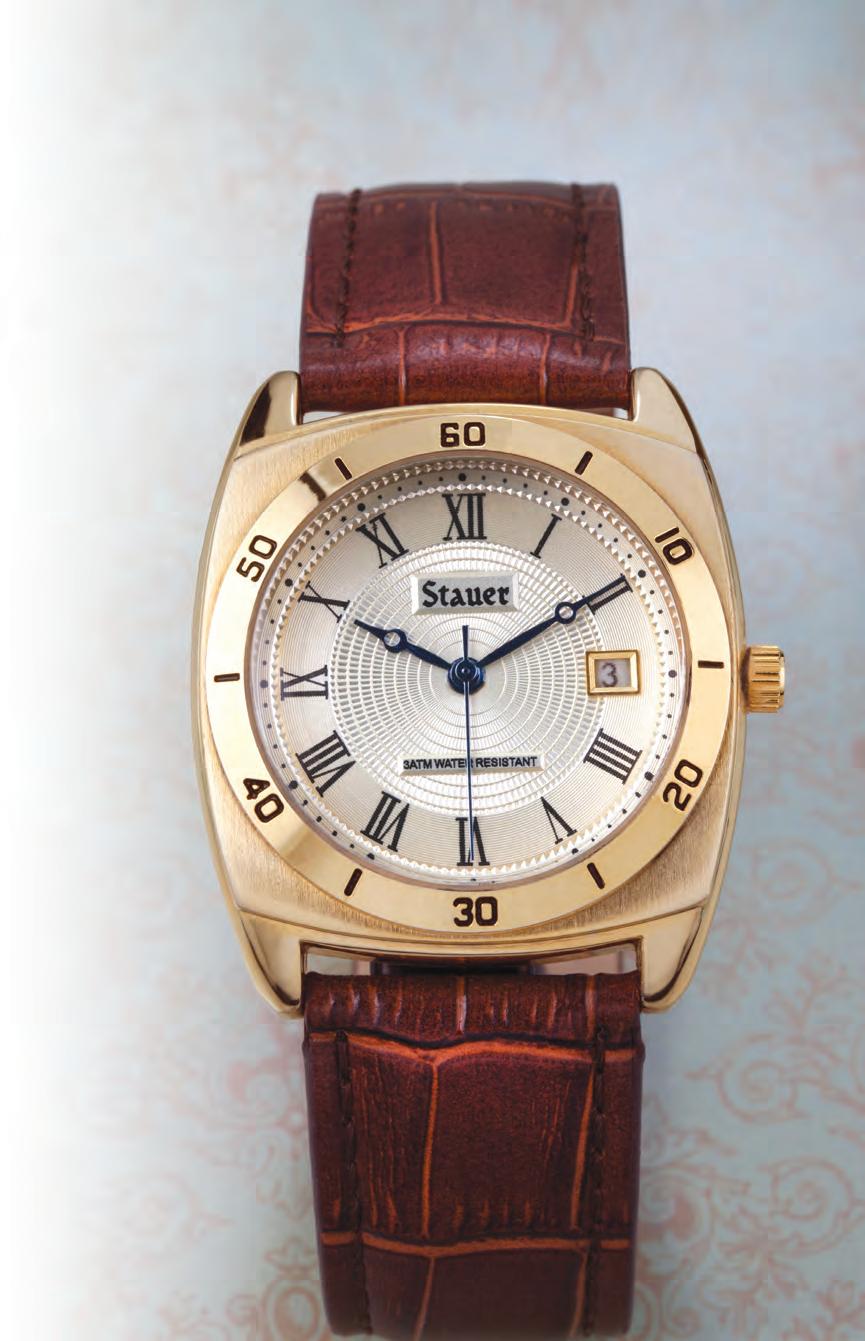
In the history of timepieces, few moments are more important than the creation of the world’s first Piezo timepiece. First released to the public in 1969, the watch turned the entire industry on its head, ushering in a new era of timekeeping. It’s this legacy that we’re honoring with the Timemaster Watch, available only through Stauer at a price only we can offer.
Prior to Piezo watches, gravity-driven Swiss watches were the standard bearer of precision timekeeping. But all that changed when the first commercially available Piezo watch came onto the market.
The result of ten years of research and development by some of the world’s top engineers, they discovered that when you squeeze a certain type of crystal, it generates a tiny electric current. And, if you pass electricity through the crystal, it vibrates at a precise frequency–exactly 32,768 times each second. When it came on the market, the Piezo watch was the most dependable timepiece available, accurate to 0.2 seconds per day. Today, it’s still considered a spectacular advance in electrical engineering.
“[Piezo timepieces]...it would shake the Swiss watch industry to its very foundations.”















With the Timemaster we’ve set one of the world’s most important mechanical advances inside a decidedly masculine case. A handsome prodigy in rich leather and gold-finished stainless steel. The simplicity of the watch’s case belies an ornately detailed dial, which reflects the prestige of this timepiece.
Call today to secure your own marvel of timekeeping history. Because we work directly with our own craftsman we’re able to offer the Timemaster at a fraction of the price that many Piezo watches cost. But a watch like this doesn’t come along every day. Call today before time runs out and they’re gone. Your satisfaction is 100% guaranteed. Spend some time with this engineering masterpiece for one month. If you’re not convinced you got excellence for less, simply send it back within 30 days for a refund of the item price. But we’re betting this timekeeping pioneer is a keeper.


During World War II, Douglas was home to the primary prisoner of war (POW) camp for Wyoming. There were 17 satellite camps throughout the state.
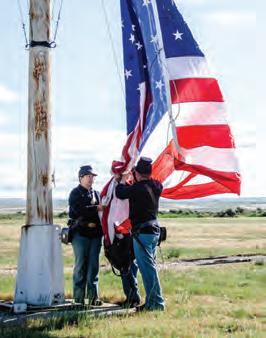

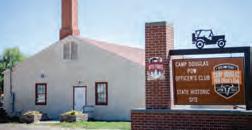





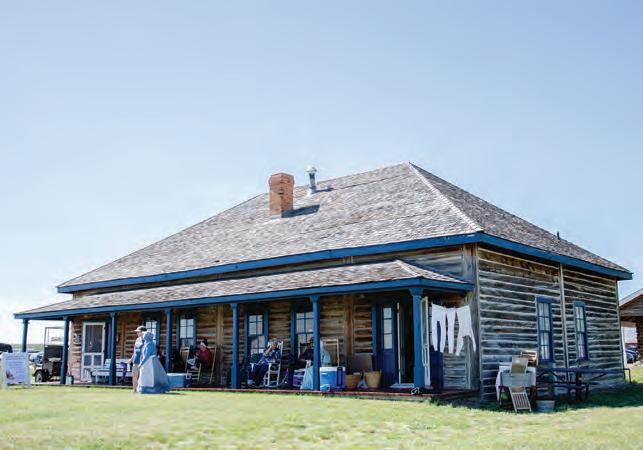
Construction on the camp took just four months, being completed in May 1943. The first prisoners to arrive at the camp were 412 Italians on Aug. 28, 1943. The federal government paid $23,955 for the land comprising the camp. The total cost for constructing the camp was $1.1 million.
The camp was over a square mile in size and comprised of 180 buildings, which housed up to 2,000 Italian and 3,000 German POWs and 500 army personnel from the spring of 1943 to the
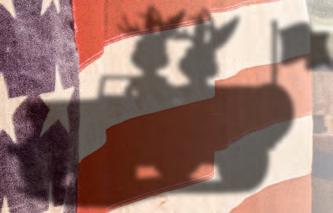




winter of 1946. During the camp’s use it was larger than the town of Douglas. Today, all that remains on the site is the officers club building.

One prisoner at the camp was quoted saying, “We never had it so good.” For many of the prisoners, it was the first time since being drafted that they had clean clothes, a warm bed, good food and health care. Prisoners at the camp ranged from 14 to 80 years old.




The camp was fully self-sufficient with a 150bed hospital, mess halls, kitchens, a motor pool, a cemetery, a newspaper, a bank and a fire department. There was a canine corps that patrolled the compound 24 hours a day.



The Soviet icebreaker Stalin gave a helping hand to the German raider Komet as part of a short-lived pact between the two dictatorships.
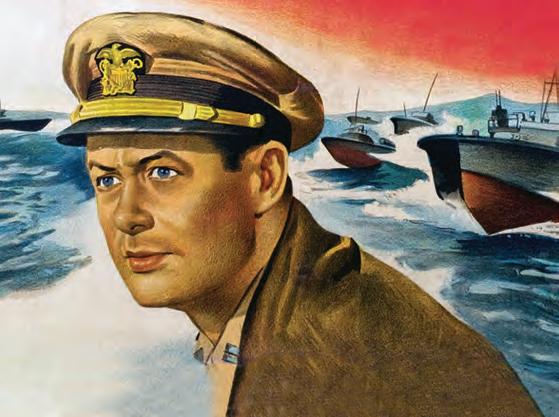
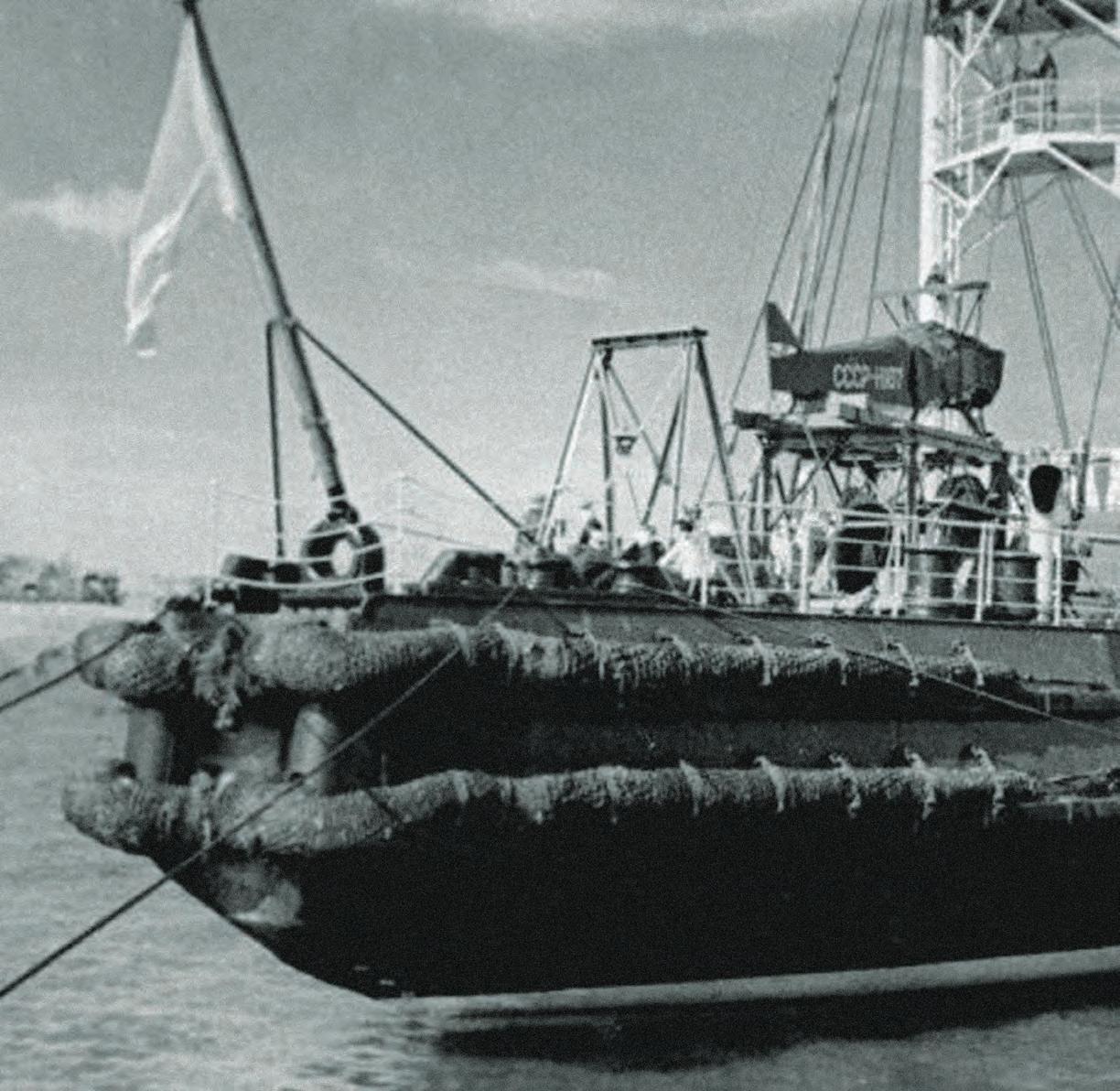

SUMMER 2023
ENDORSED BY THE NATIONAL WORLD WAR II MUSEUM, INC.

COVER STORY
30 CODEBREAKERS IN PERIL
The men of Station Cast on Corregidor knew too much—so they couldn’t risk falling into Japanese hands JOSEPH CONNOR
38 JOHN FORD AT MIDWAY
The noted director was used to saying “Action!” Now he would experience some for himself TOM HUNTINGTON
46 RAMPAGE IN
After a German raider got stuck in ice, the Soviets helped send it on its way down a trail of destruction STUART D. GOLDMAN
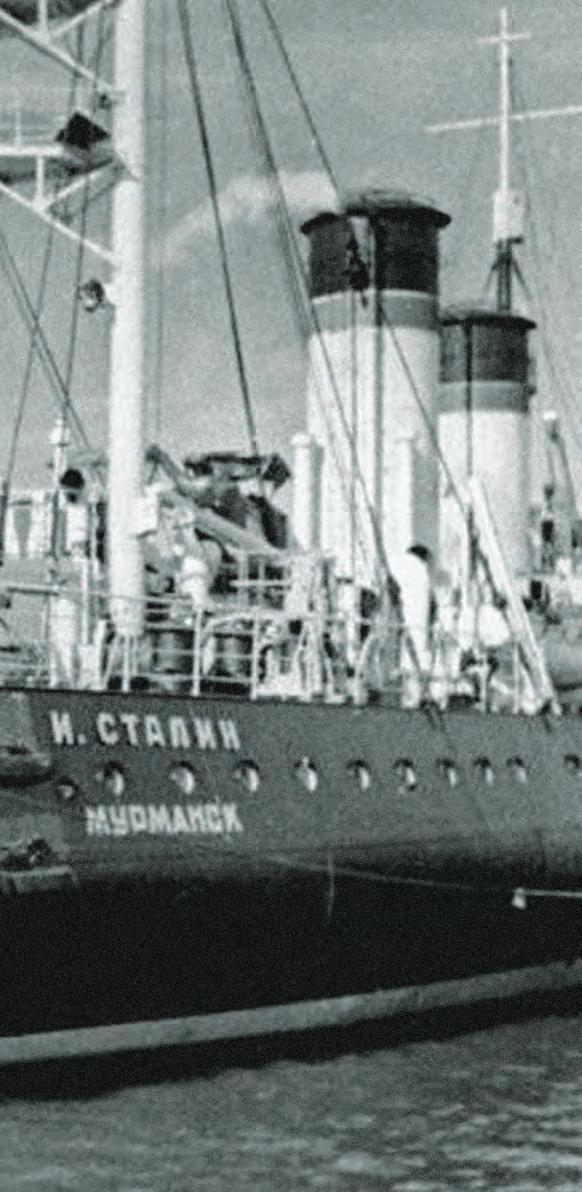
WEAPONS MANUAL
54 DOUBLE TROUBLE
Germany’s 88mm anti-aircraft gun was good for more than just flak PORTFOLIO
56 DISNEY’S WAR
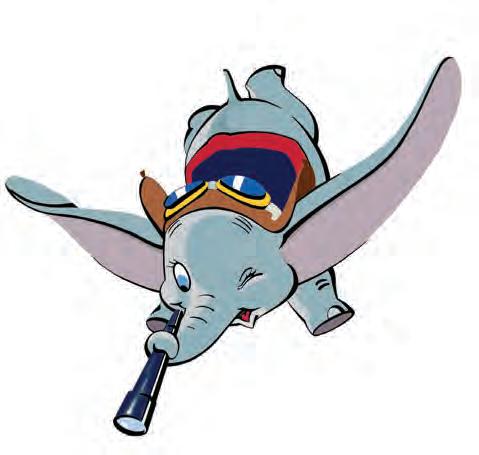
When the United States entered World War II, the Walt Disney Studios had an animated response

62 BALANCING ACT
How did Turkey maintain its neutrality for most of the war even though it was surrounded by belligerents? MAC CAREY
DEPARTMENTS
6 FRONT LINES
8 MAIL
10 WORLD WAR II TODAY
20 CONVERSATION
Wally King talks about his experiences flying the P-47 Thunderbolt
24 NEED TO KNOW
26 TRAVEL
The Mediterranean island of Malta still bears traces of war
70 REVIEWS
To the End of the Earth, The Collaborators, and more
76 BATTLE FILMS
John Ford’s They Were Expendable is a love letter to PT boats
79 CHALLENGE
80 FAMILIAR FACE
Tom Huntington EDITOR
Larry Porges SENIOR EDITOR
Jerry Morelock, Jon Guttman HISTORIANS
David T. Zabecki CHIEF MILITARY HISTORIAN

Paul Wiseman NEWS EDITOR
Brian Walker GROUP DESIGN DIRECTOR
Melissa A. Winn DIRECTOR OF PHOTOGRAPHY
Guy Aceto PHOTO EDITOR
Dana B. Shoaf EDITOR IN CHIEF Claire Barrett NEWS AND SOCIAL EDITOR
ADVISORY BOARD
Ed Drea, David Glantz, Keith Huxen, John C. McManus, Williamson Murray
CORPORATE
Kelly Facer SVP REVENUE OPERATIONS
Matt Gross VP DIGITAL INITIATIVES
Rob Wilkins DIRECTOR OF PARTNERSHIP MARKETING
Jamie Elliott SENIOR DIRECTOR, PRODUCTION
ADVERTISING
Morton Greenberg SVP ADVERTISING SALES MGreenberg@mco.com
Terry Jenkins REGIONAL SALES MANAGER TJenkins@historynet.com

DIRECT RESPONSE ADVERTISING
Nancy Forman / MEDIA PEOPLE nforman@mediapeople.com
© 2023 HistoryNet, LLC
Subscription Information 800-435-0715 or shop.historynet.com

LIST RENTAL INQUIRIES:




Belkys Reyes, Lake Group Media, Inc. / 914-925-2406 / belkys.reyes@lakegroupmedia.com
World War II (ISSN 0898-4204) is published quarterly by HistoryNet, LLC, 901 N. Glebe Road, 5th Floor, Arlington, VA 22203 Periodical postage paid at Vienna, VA and additional mailing offices. Postmaster: send address changes to World War II, P.O. Box 900, Lincolnshire, IL 60069-0900 Canada Publications Mail Agreement No. 41342519 Canadian GST No. 821371408RT0001
The contents of this magazine may not be reproduced in whole or in part without the written consent of HistoryNet, LLC.
PROUDLY MADE IN THE USA
As we near completion of our expansion, exclusive new Victory pavers are now available. Honor your WWII hero’s legacy, and that of other veterans, in the heart of our campus!


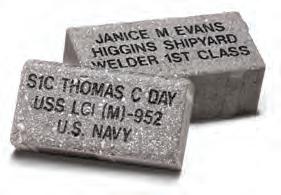
BRICK & PAVER TEXT (Please Print Clearly)
Honor your hero with a classic red Victory brick along the sidewalk of our campus.
BRICK & SMALL PAVER TEXT (3 Lines*)


8” x 4”
9” x 4.5”
*18 characters including spaces.


LARGE PAVER TEXT (6 Lines*)




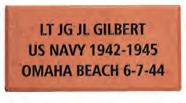




12” x 12”
18” x 12”
*20 characters including spaces
Installation in prominent area of Founders Plaza.

*Includes an image of your paver and 44 page history of WWII.
PLEASE MAKE CHECKS PAYABLE TO THE NATIONAL WWII MUSEUM
tribute items (if applicable). The National WWII Museum’s Road to Victory brick and paver program honors the WWII generation, the American heroes who served during the war, U.S. veterans, veteran organizations, and individuals who exemplify the American spirit. The goal of our program is to celebrate the American spirit while forging a link between the present generation and the generations who fought to secure our nation’s freedom during World War II and other wars and conflicts. Therefore, the Museum reserves the right to deny requests for inscriptions that might be considered offensive or inappropriate to those who sacrificed during the WWII era or other eras, or messages that do not align with the Museum’s mission, which is to tell the story of the American experience in the war that changed the world—why it was fought, how it was won, and what it means today—so that all generations will understand the price of freedom and be inspired by what they learn. HistoryNet

IN COLLEGE , I wanted a solid, practical education, so I majored in…cinema history and criticism. In truth, I guess what I really wanted was a way to watch movies in class.

One thing my teachers stressed in scriptwriting class was that every scene in a screenplay needed some kind of conflict. It could be as simple as two characters disagreeing about something, or it could be British bombers attacking German infrastructure in The Dam Busters . Conflict is essential. So, it’s no wonder that war movies have become such a film staple. In fact, the first movie to win the Academy Award for best picture was Wings, a World War I film.
The Second World War has inspired a slew of feature films, and every issue of World War II takes a look at one of them in the “Battle Films” column. Most of the movies we cover there are fictionalized, but one feature article this issue takes a closer look at a real war movie—the Battle of Midway short that director John Ford produced from his experiences on the island when the Japanese
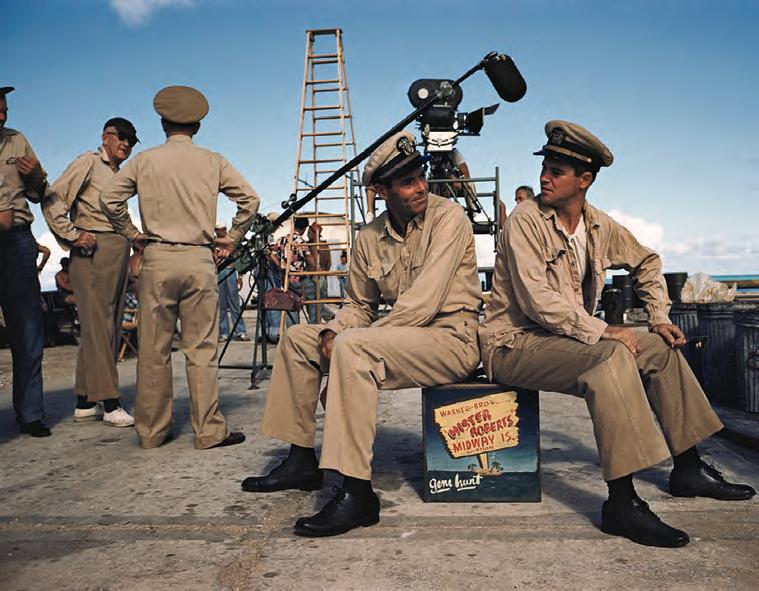
attacked on June 4, 1942.
Ford is best known today for his Westerns, but I find it a little surprising that he didn’t direct more features set in World War II, since he loved the U.S. Navy and was very proud of his war experiences. We look at They Were Expendable, his 1945 adaptation of the Walter Lindsay White book, in this issue’s “Battle Films,” but the only other World War II feature Ford directed was 1955’s Mister Roberts. An adaptation of a successful play, it starred Henry Fonda (see “Familiar Face” on page 80 for more about Fonda’s military career), who was recreating his successful stage role, as well as James Cagney, William Powell, and Jack Lemmon. Mister Roberts is a much-loved movie, but it had a tumultuous production. Shooting started in September 1954 on location at Midway, 12 years after Ford’s experiences there during the war. But the director was drinking heavily, and Fonda was becoming increasingly disenchanted with the way the film was diverging from the play, especially with all the comic relief Ford was creating for Lemmon. When Fonda went to Ford’s room one evening to talk to the director about his concerns, Ford, who had been drinking, got infuriated and slugged him. The incident ended the friendship between the two men. Before long Ford fell ill and needed gallbladder surgery, so director Mervyn LeRoy stepped in to finish the film.
Come to think of it, maybe conflict isn’t always good for a movie, at least when it happens offscreen.
On another note: A lot of readers were fooled by last issue’s “Challenge” (see page 79) because the Hurricane in the image had a two-bladed propeller. While it’s true that the propellers in later versions of the airplane had three blades, early Mk 1 versions like the one in last issue’s photo did indeed have the two-bladed Watts propeller (and the airplanes had fabric-covered wings, too). We always like to keep you guessing! H
5 Countries, 5 Pure Silver Coins!

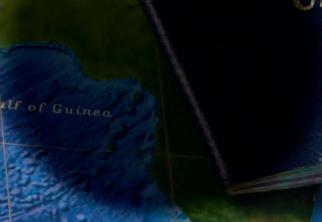

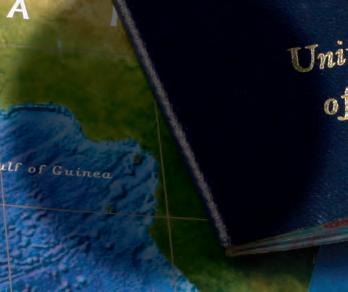

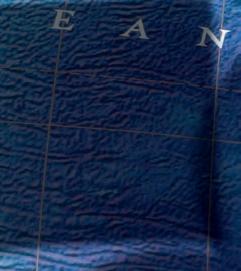

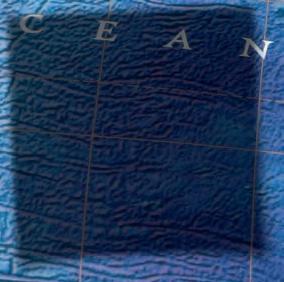


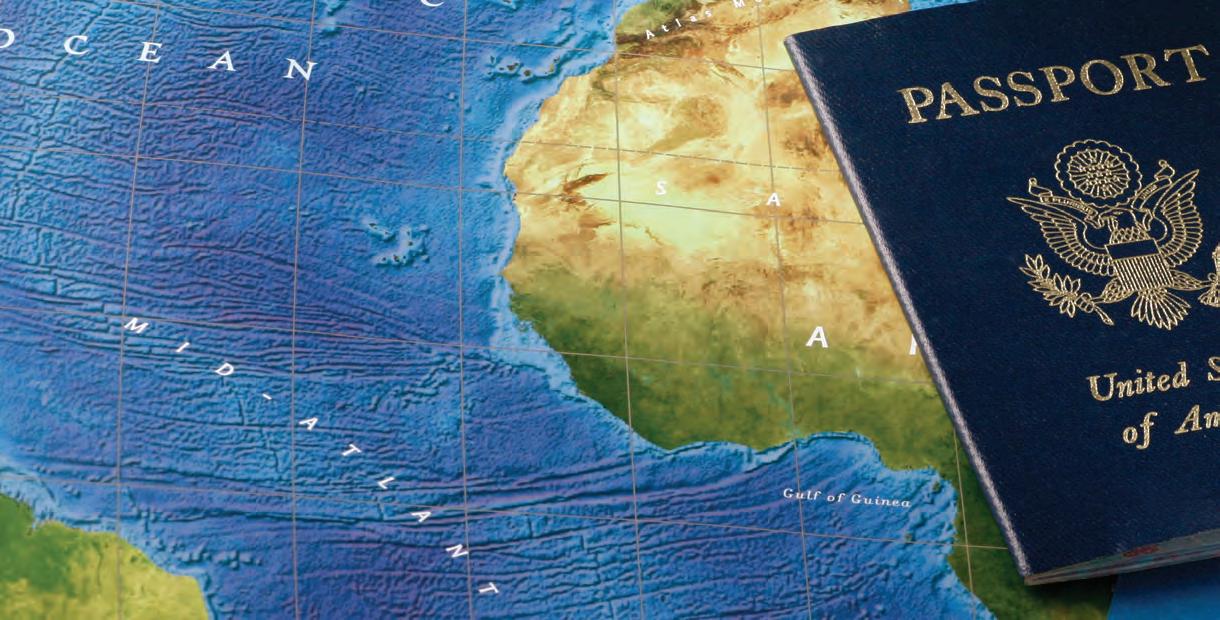





Travel the globe, without leaving home—with this set of the world’s ve most popular pure silver coins. Newly struck for 2023 in one ounce of ne silver, each coin will arrive in Brilliant Uncirculated (BU) condition. Your excursion includes stops in the United States, Canada, South Africa, China and Great Britain.
Each of these coins is recognized for its breathtaking beauty, and for its stability even in unstable times, since each coin is backed by its government for weight, purity and legal-tender value.

2023 American Silver Eagle: The Silver Eagle is the most popular coin in the world, with its iconic Adolph Weinman Walking Liberty obverse backed by Emily Damstra's Eagle Landing reverse. Struck in 99.9% fine silver at the U.S. Mint.





2023 Canada Maple Leaf: A highly sought-after bullion coin since 1988, this 2023 issue includes the FIRST and likely only use of a transitional portrait, of the late Queen Elizabeth II. These are also expected to be the LAST Maple Leafs to bear Her Majesty's effigy. Struck in high-purity




99.99% fine silver at the Royal Canadian Mint.
2023 South African Krugerrand: The Krugerrand continues to be the best-known, most respected numismatic coin brand in the world. 2023 is the Silver Krugerrand's 6th year of issue. Struck in 99.9% fine silver at the South African Mint.




2023 China Silver Panda: 2023 is the 40th anniversary of the first silver Panda coin, issued in 1983. China Pandas are noted for their heart-warming one-year-only designs. Struck in 99.9% fine silver at the China Mint.

2023 British Silver Britannia: One of the Royal Mint's flagship coins, this 2023 issue is the FIRST in the Silver Britannia series to carry the portrait of King Charles III, following the passing of Queen Elizabeth II. Struck in 99.9% fine silver.

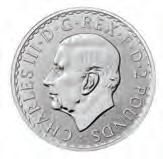



These coins, with stunningly gorgeous finishes and detailed designs that speak to their country of origin, are sure to hold a treasured place in your collection. Plus, they provide you with a unique way to stock up on precious silver. Here’s a legacy you and your family will cherish. Act now!
You’ll save both time and money on this world coin set with FREE shipping and a BONUS presentation case, plus a new and informative Silver Passport!
BONUS Case!
2023 World Silver 5-Coin Set Regular Price $229 – $199 SAVE $30.00 (over 13%) + FREE SHIPPING
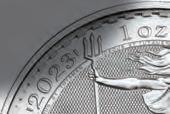



FREE SHIPPING: Standard domestic shipping. Not valid on previous purchases. For fastest service call today toll-free

1-888-201-7070


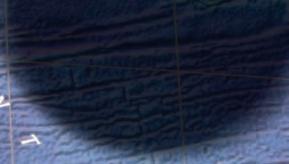


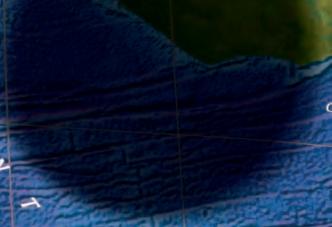



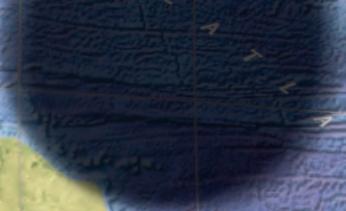
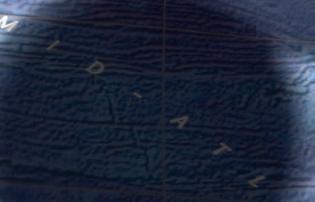


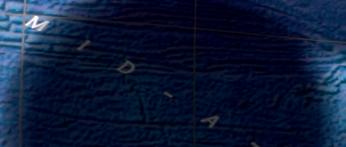









Offer Code WRD288-05








Please mention this code when you call.




SPECIAL CALL-IN ONLY OFFER
Not sold yet? To learn more, place your phone camera here >>> or visit govmint.com/WRD
GovMint.com® is a retail distributor of coin and currency issues and is not a liated with the U.S. government. e collectible coin market is unregulated, highly speculative and involves risk. GovMint.com reserves the right to decline to consummate any sale, within its discretion, including due to pricing errors. Prices, facts, gures and populations deemed accurate as of the date of publication but may change signi cantly over time. All purchases are expressly conditioned upon your acceptance of GovMint.com’s Terms and Conditions (www.govmint.com/terms-conditions or call 1-800-721-0320); to decline, return your purchase pursuant to GovMint.com’s Return Policy. © 2023 GovMint.com. All rights reserved.
AS SOON AS I saw the headline “Rescuing Norway’s Gold” in the Spring 2023 issue, I remembered a book I read as a kid, called Snow Treasure. In the story, four Norwegian children help to get gold bars out of Norway by taking them a few at a time on their sleds down a mountain and past German guards to a hiding place, and from there Norwegian volunteers pick up the gold bars and get them to the ship that will take them to safety. An Internet search identified the author as Marie McSwigan; the book was first published by E.P. Dutton in 1942. The author claimed her book was based on a true story, although most people disagree. As a child I didn’t know whether it was true or not, it was simply a very exciting tale.

I remember another book I picked up in my elementary school library about D-Day—I can’t remember the title, but I never forgot the names of the five beaches. Around the same time, my father got out his collection of newspapers from World War II and went over them with me. He had saved not just front pages but entire papers, and we could see the ads, the funnies, what the weather was like, the radio listings. (My father served in the Marines during the war but did not go overseas; the war ended as he was still training.)
Never underestimate the power of a book, or a newspaper, or a magazine, to spark a lifelong interest in World War II history. I am still reading about it some 60 years later.
Anne Moiseev Springfield, New JerseyI am no gamer. I put away childish things many years ago. I did play the board games D-Day and Gettysburg back when I was a youth. But somehow my youthful brain did not process these pursuits as “fun” and “entertaining.” T his was serious business. Educational even.
Chris Ketcherside, who wrote the recent review in World War II magazine of the Undaunted: Stalingrad board game [Spring 2023], uses the above words to describe the game and then adds: “The city tiles realistically recreate Stalingrad, and it is fun that they can be replaced as the game goes along and the city becomes increasingly damaged.”
No need to point out to the readers of World War II magazine the insensitivity, for lack of a better word, of describing the awfulness of the siege of Stalingrad within the framework of a board game. Wouldn’t it have been better to highlight the possible educational factors involved in a game concerning a battle-to-the-death on both sides and how a twist here or a turn there might have impacted the final result? As I said: even as a kid I respected the D-Day and Gettysburg board games as a means to a better understanding of what the heck was going on. Saying, “It’s only a game” just didn’t sit well with me this time around.
Martin E. Horn South Plainfield, New JerseyWhat a pleasant surprise to open up the Spring 2023 issue and read the letter from the new editor, Tom Huntington [“Front Lines”]. I immediately had flashbacks (good ones!) to my senior year in high school in 1973. While looking through a newsstand, I noticed the eyecatching cover photo of the initial issue of Marshall Cavendish’s History of the Second World War. I was immediately hooked. I purchased a number of issues in the ensuing weeks, including some of the “special issues” mentioned. Unlike Tom, I did not continue to buy all 96 issues. Something called college diverted my interests!
I am not sure what happened to my small collection, but I vividly remember reading each issue cover to cover, a number of times.
Mark R. Lindon Longmont, ColoradoI read “Front Lines” in the Spring 2023 issue and had to laugh at the irony behind the anecdote you shared of your pursuit of collecting issues of History of the Second World War
I have been a longtime reader of World War II, and I, too, purchased binders to keep my print copies neatly organized on my library shelves. I even purchased the CD containing all past issues that I didn’t have but reading them on the computer just didn’t satisfy the way the printed magazine does. Sadly, I decided to let my subscription lapse this year after the decision was made to go to a quarterly schedule. I agree fully with fellow reader Sidney Spezza and the comments he made in his letter to the “Mail” column this issue. The printed magazine is the gem in your custody.
Christopher Carbott, CDR USN (RET) Northville, MichiganI have two comments on the Spring issue. In reference to “Armed Medics” in “Mail”: Based on my service in Korea at the ceasefire on July 27, 1953, the medics I met all carried carbines (updated to M2, automatic or semi-automatic) for their own protection
Jessica Wambach Brown’s feature “Dog Bait on Cat Island” reminded me how, after the ceasefire, I participated in patrols in the DMZ, occasionally with a dog and its trainer. When we were briefed prior to the first patrol we were told to avoid trying to pet the dogs, as they were trained to resist that. As I heard this, I felt a cold, wet nose in the palm of my hand. I folded my arms.
Carl Sardaro Milan, New YorkI have points to make about two of your articles in the Spring 2023 issue of World War II
About the report in “World War II Today” [“Eighty Years Later, WWII Still Causing Damage”], the author describes finding radioactive contamination “far in excess” at an elementary school in suburban St. Louis. Subsequent testing of the site, first by the U.S. Army Corps of Engineers, and secondly an independent St. Charles company, SCI Engineering, which was hired by the school district for independent testing, found that the school building and grounds do not contain higher levels of radioactive materials than
you’d expect to find at any other school.
In an otherwise excellent article on a conversation with author Bruce Henderson [“Conversation”], Mr. Henderson makes the unsubstantiated statement: “With the anti-immigrant sentiment in this country today, we need to be reminded that we all come from somewhere.” We are all entitled to opinions, but I would remind Mr. Henderson that opposition to illegal immigration is not necessarily anti-immigrant as some of the strongest opponents of illegal immigration are themselves legal immigrants.
Drew Klein Ballwin, MissouriAs a reader of your magazine for many years, I must write and tell you what a great job that you are doing.
I enjoyed “Bomber Boys” in the Spring 2023 issue. Looking at all the photos of the A-2 Jackets and the stories behind them made me think of my WWII AAF collection of over 40 years and the 30-plus A-2s that I have. Yes, each jacket is a part of history and does have its own story that goes with it.
Keep up the good work, World War II magazine
John Reid Marietta, GeorgiaIn the Winter 2023 issue of Wo rld War II m agazine on page 13, you have a picture of the “Hollywood Victory Caravan” with 11 Hollywood stars with their hands raised in what would seem to be “V for Victory” signs. During World War II, you will find pictures of world leaders such as Prime Minister Win ston Churchill raising his hand both ways. With two fingers raised and the palm of the hand facing forward, it was “V for Victory.” If the two-fingered gesture had the back of the hand facing forward, it was telling Der Fuhrer “where to go and what he could do to himself.” Five of the actors in the picture of the Victory Caravan have their hands raised in the V-sign with their palms forward while the other six have the backs of their hands facing forward. One can assume which version each actor preferred.
 Ted Severe Baltimore, Maryland
Ted Severe Baltimore, Maryland
PLEASE SEND LETTERS TO:
In England, with the two-fingers up and the palm facing inward, the symbol means “Up yours” or “Go eff yourself.” It’s also true that Churchill used the “V for Victory” symbol that way early in the war, until his aides told him the lower classes were giggling at him. So, we don’t think the meaning was universally known in WWII, because we can’t really imagine Winston Churchill intentionally giving the equivalent of a middle finger in public appearances.
worldwar2@historynet.com
Please include your name, address, and daytime telephone number.
@WorldWarIImag
REPORTED AND WRITTEN BY
PAUL WISEMANTHEY DID NOT GET OFF to a dazzling start. Disembarking at Glasgow, Scotland, on February 14, 1945, after nearly two weeks at sea, many of the more than 800 women—nearly all of them Black— were seasick or covered in salt spray. Then a German V-1 buzz bomb hit near the dock and they had to scramble for cover. They were, their commander Major Charity Adams later wrote, “a very unhappy looking lot.”
And that was before they began their daunting task: sorting through a backlog of mail—eventually 17 million pieces of it, includ-
ing airplane hangars full of undelivered Christmas presents. The letters and packages were stuck in England, far from American G.I.s fighting their way through Nazi-occupied Europe and longing to hear from their families and friends back home.

From those decidedly unglamorous beginnings, the 855 women of the 6888th Central Postal Directory Battalion (part of the Wom-


TONY VACCARO, an American infantryman who took stunning but forbidden battlefield photos on a small camera he’d bought as a teenager, died December 28, 2022, at age 100. Vaccaro (center, above) requested assignment as a combat photographer in Europe but was told that at 21 he was too young and should stick to fighting. Army regulations limited photography to the Signal Corps, but Vaccaro kept snapping pictures on his 35-millimeter Argus C3 as the 83rd Infantry Division battled from Normandy to Germany. His photographs provided an up-close view of war unavailable to Signal Corps photographers who carried heavier equipment. After the war, Vaccaro became known for his magazine fashion shoots and celebrity photos.
en’s Army Corps, or WACs) are finally getting their due. In 2019, they were the subject of a documentary film. In 2022, President Joe Biden signed legislation awarding them the Congressional Gold Medal. And now they are receiving the full Hollywood treatment: filmmaker and actor Tyler Perry is writing and directing a film about the battalion’s wartime experiences. Six Triple Eight will feature Kerry Washington (Scandal ) and Oprah Winfrey among the ensemble cast.
It’s a story of perseverance. Inspired by the motto they created—“No Mail, Low Morale”—they developed their own sorting system and plowed through the backlog. A job that was expected to take six months took them three. The 6888th had its own medics, dining hall, support staff, and military police (unarmed but trained in jiu-jitsu).
Along the way, they battled racism and sexism. Adams, only 26 years old, refused to accept Red Cross equipment for a segregated recreational center and urged members of the 6888th not to stay in a segregated Red Cross hotel while they were on leave. When a visiting general threatened to send “a white first lieutenant” to show her how to run the battalion, Adams stood firm: “Over my dead body, sir,” she said. She braced for a court-martial, but the general backed down. Adams was, in fact, promoted to lieutenant colonel—the highest possible rank
for a woman in the WAC—in December 1945.


Coming from segregated America, the women were surprised that they could go wherever they wanted in Birmingham, England. They bowled. They went dancing. They were invited to locals’ homes for dinner. But mostly they worked in eight-hour shifts, 24 hours a day, seven days a week.
Asked what drew him to making Six Triple Eight , which will air on Netflix when completed, Perry told World War II, “ I had the honor of meeting [6888th veteran] Lena King in April 2022. I was so moved in hearing her story and the emotion she still carries about the people in her life and her experiences with the 6888th over 70 years later…. The spirit of these women wanted us to tell their story.” Perry added, “My hope is that audiences w ill connect with their story and the struggles they faced on many levels.”
THE USS ALBACORE was one the deadliest American submarines in the Pacific—and one of the unluckiest. In the fall of 1943 it was hit twice by friendly fire, once sustaining heavy damage from American bombs. A year later, the 312-foot, Gato -class submarine went missing in the heavily mined Tsugaru Strait off Japan’s Hokkaido island. All 85 men aboard were lost.
Nearly eight decades later, a retired University of Tokyo engineering professor located the wreck of the Albacore 800 feet underwater. Tamaki Ura, who has developed unmanned mini-submarines to scour Japanese water for the wrecks of wartime submarines, raised $15,000 via crowdfunding sources to search for the Albacore
Using documents from the Japan Center for Asian Historical Records, Ura zeroed in on the lost sub’s possible location. A survey by one of his mini-subs in October 2022 convinced the U.S. Navy that he’d found the Albacore. Particularly persuasive were images showing modifications known to have been made to the Albacore before her last mission, including an SJ radar dish and mast and a row of vents along the top of the superstructure. Strong currents and heavy vegetation had made the site difficult to study.

“We sincerely thank and congratulate Dr. Ura and his team for their efforts in locating the wreck of Albacore,” said Samuel Cox, a
retired navy rear admiral and director of the Naval History and Heritage Command, when the findings were announced in February. The command has jurisdiction over legally protected American wartime wrecks.
The Albacore, named for a species of tuna, was built in Groton, Connecticut, by the Electric Boat Company and commissioned June 1, 1942. It is considered one of America’s most successful wartime submarines, sinking 10 confirmed Japanese ships and possibly three others. On June 19, 1944, the Albacore torpedoed and sank the 31,000-ton Taiho, Japan’s newest and biggest aircraft carrier, during the Battle of the Philippine Sea.
The Albacore was last seen October 28, 1944, refueling at Midway en route to Japanese waters. On November 7, a Japanese patrol boat reported seeing the explosion of a submerged submarine before bedding, oil, and food supplies rose to the surface.
—French general Charles de Gaulle in a BBC radio broadcast from London on June 18, 1940, as France was falling to Hitler’s Germany

“Has the last word been said? Must we abandon all hope? Is our defeat final and irremediable?
To those questions I answer—No!”


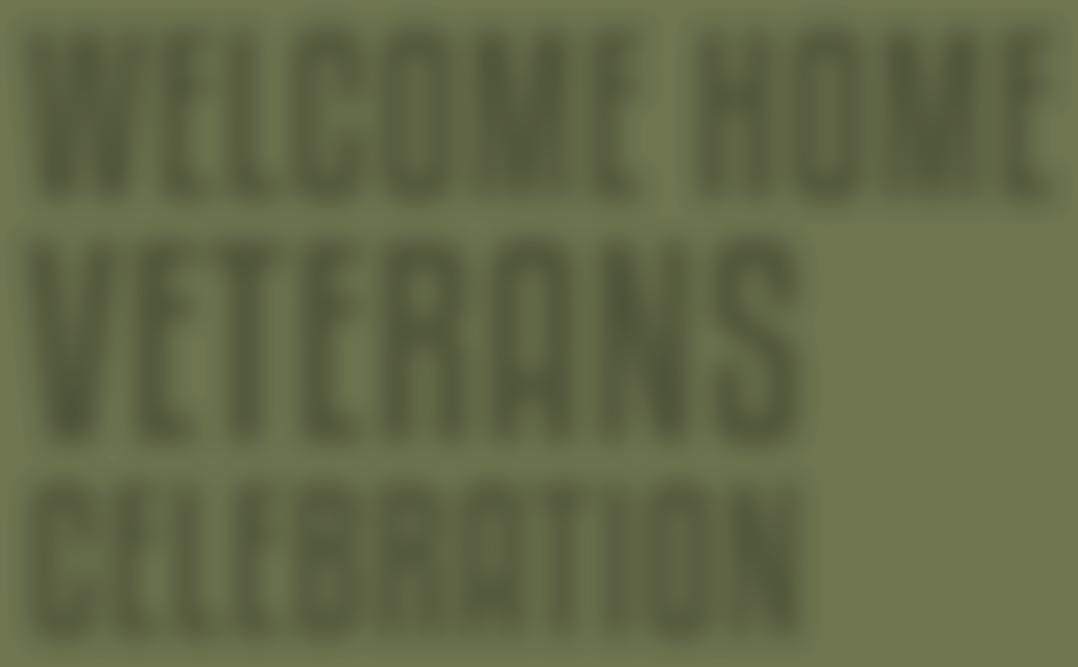

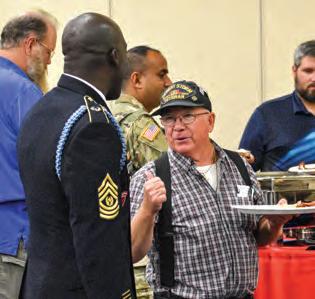


My brother, Private Joseph Patrick Donnelly, was a member of the 9th Armored Division, 19th Tank Battalion, Headquarters Company. He was killed on November 10, 1944, in Scheidgen, Luxembourg. Unfortunately, most of Joe’s military records were destroyed in the 1973 St. Louis Archives fire. What can you tell us about Joe and his unit?
—Rich Donnelly, Williamstown, New JerseyThe lineage of your brother’s unit, the 19th Tank Battalion, goes back to 1836 and the formation of the 2nd Cavalry Regiment. The 2nd Cavalry saw action in some of the most notable campaigns in U.S. military history, including Gettysburg, Little Big Horn, and the Meuse-Argonne (as America’s only horse-mounted cavalry unit to fight in World War I).
The regiment was assigned to Fort Riley, Kansas, in July 1942. There, the 2nd’s centuryold service as a cavalry unit came to an end and it was redesignated the 2nd Armored Regiment, part of the 9th Armored Division, with its men transitioning from horses to tanks. The newly formed regiment trained at Fort Riley until June 1943. Your brother enlisted in the army on November 12, 1942, so he joined the regiment there.
On October 9, 1943, the 9th’s 3rd Battalion was redesignated the 19th Tank Battalion and, in November 1943, the division moved to Fort Polk, Louisiana, for nine months of maneuvers, training, and testing until deploying overseas. The 9th sailed from New York to Scotland on August 20, 1944, before taking a train south to billet in England. Assigned to the U.S. Ninth Army, the 9th was the first armored division to receive the latest model Sherman M4A3s— with 76mm guns—and new 105mm howitzer assault guns. With these tools in hand, it sailed from England on October 1, 1944, and landed in France two days later. The troops stayed in Ste.-Marie-duMont, Normandy, for ten days while prepping to march east, and the unit history evokes the details of what might have been your brother’s experience: “Nightly movies and broadcasts of the 1944 World Series helped to while away the chilly, rainy days.”
On October 13, the push toward Germany began. The 9th
arrived in central Luxembourg, an active combat zone, on October 19 and remained in reserve for two weeks. On November 3, the 19th Tank Battalion moved to the front at Scheidgen, Luxembourg, an evacuated town, where it shelled German positions in its first wartime action. A week later, on November 10, the 19th took its first casualties. An assault gun platoon moved under cover of fog into firing position. When the fog suddenly lifted and exposed the platoon, a barrage of German artillery found its mark. All six tanks in the platoon were hit, killing three men and injuring six. This is no doubt the battle in which your brother lost his life.
The 9th Armored Division soon found itself at the forefront of the Battle of the Bulge, meeting the initial German thrust on December 16. The 19th Tank Battalion was assigned near Echternach, Luxembourg, with some elements of the battalion farmed out to support other units. On January 3, 1945, after months of intense fighting and 125 battalion casualties during its advance east, the 19th was relieved and its role in the Bulge ended. Fifteen battalion officers and men later received decorations for their actions.

The 19th rejoined the fight in late February 1945 as the U.S. Army advanced into Germany. Fighting intensified throughout March and April in the last-ditch German attempt to stave off defeat. Town-by-town battles against anti-tank guns, sniper fire, mortars, and artillery from retreating Wehrmacht troops resulted in heavy American casualties, but by early May the end of the war was clearly at hand. Germany surrendered on May 8.
The 19th then assumed occupation duty. Stationed in central Germany, the battalion took on outpost duty to help control refugees fleeing west from the Soviets and to pick up any straggling German soldiers. Some battalion members guarded factories, hospitals, and POW work patrols, while others served in camps for displaced persons.
In October 1945, the 9th Armored Division returned to the United States and was inactivated on October 13, its major role in the defeat of Germany complete. Your brother’s name, Joseph Patrick Donnelly, is listed in the unit history among the 52 members of the 19th Tank Battalion who died in those final months of World War II. —Larry
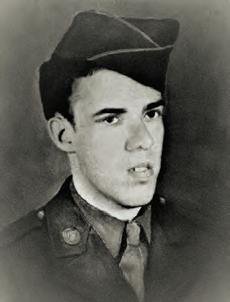 Porges
Porges
Do you have a relative from a World War II unit you’d like to learn more about?
Contact us at worldwar2@historynet.com (with “My Parents’ War” in the subject line) with the following:
—Your relative’s full name, date of birth, and the specific unit in which he or she served
—A high-resolution wartime-era photograph —Copies of any paperwork that may help us determine the particulars of your relative’s service.
Note that we are unable to conduct independent genealogical research.
ago, Persians, Tibetans and Mayans considered turquoise a gemstone of the heavens, believing the striking blue stones were sacred pieces of sky. Today, the rarest and most valuable turquoise is found in the American Southwest–– but the future of the blue beauty is unclear. On a recent trip to Tucson, we spoke with fourth generation turquoise traders who explained that less than five percent of turquoise mined worldwide can be set into jewelry and only about twenty mines in the Southwest supply gem-quality turquoise. Once a thriving industry, many Southwest mines have run dry and are now closed.
We found a limited supply of turquoise from Arizona and purchased it for our Sedona Turquoise Collection . Inspired by the work of those ancient craftsmen and designed to showcase the exceptional blue stone, each stabilized vibrant cabochon features a unique, one-of-a-kind matrix surrounded in Bali metalwork. You could drop over $1,200 on a turquoise pendant, or you could secure 26 carats of genuine Arizona turquoise for just $99

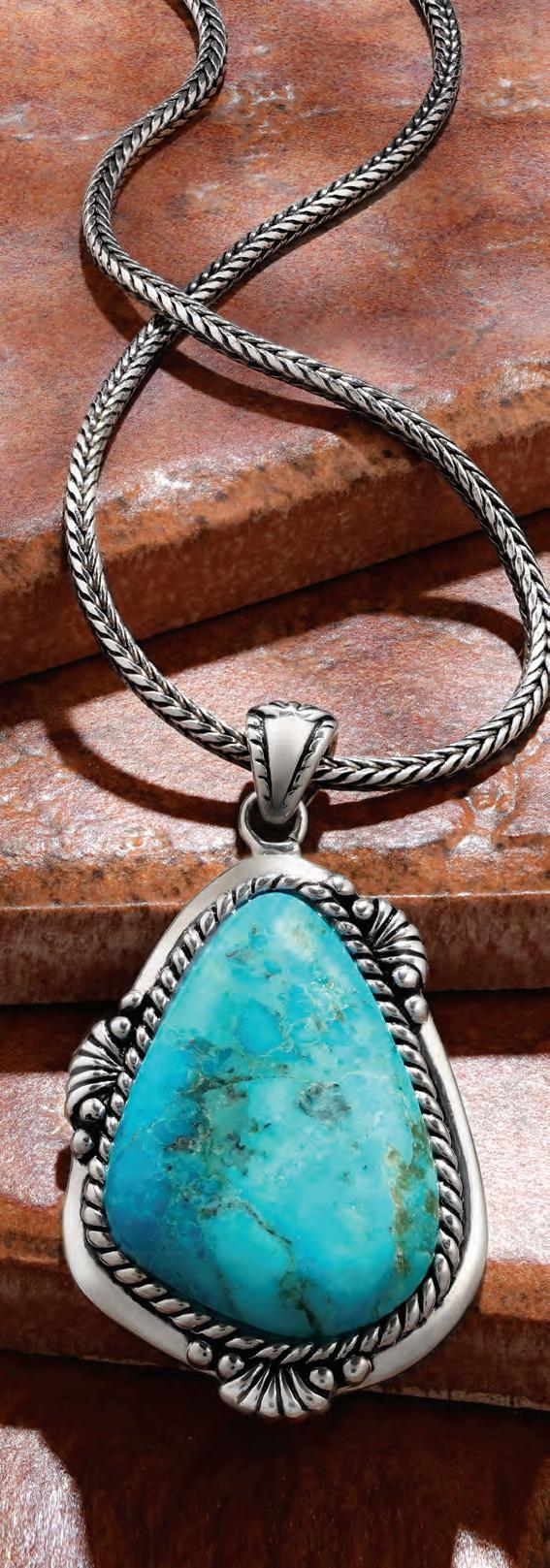
Your satisfaction is 100% guaranteed. If you aren’t completely happy with your purchase, send it back within 30 days for a complete refund of the item price.
The supply of Arizona turquoise is limited, don’t miss your chance to own the Southwest’s brilliant blue treasure. Call today!
Jewelry Specifications:
• Arizona turquoise • Silver-finished settings
Sedona Turquoise Collection
A. Pendant (26 cts) $299 * $99 +s&p Save $200
B. 18" Bali Naga woven sterling silver chain $149 +s&p
C. 1 1/2" Earrings (10 ctw) $299 * $99 +s&p Save $200
Complete Set** $747 * $249 +s&p Save $498
**Complete set includes pendant, chain and earrings.
Call now and mention the offer code to receive your collection. 1-800-333-2045
Offer Code STC788-09
You must use the offer code to get our special price.
*Special price only for customers using the offer code versus the price on Stauer.com without your offer code.
26 carats of genuine Arizona turquoise ONLY $99
 A.
B.
A.
B.

THE SHOOTING STOPPED nearly 80 years ago, but the dying continues in the South Pacific’s Solomon Islands, scene of some of the bloodiest fighting of World War II.
Every year at least 20 islanders are killed or maimed by the detonation of leftover bombs, artillery shells, or other munitions. In January, the United States stepped up efforts to solve the problem, providing $1 million to the demining nonprofit HALO Trust to
locate and document unexploded ordnance left behind by American and Japanese forces.
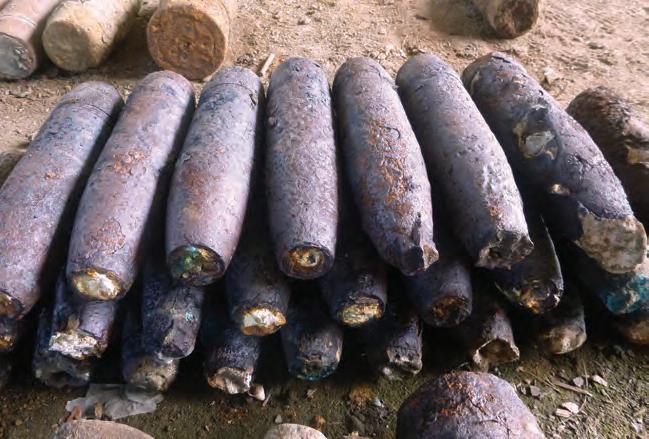

A survey is considered long overdue. There are no reliable records on where the bombs are most likely to be buried, just anecdotes and old war stories. The munitions are often discovered in the worst way possible—when someone disturbs them and sets them off. In May 2021, for instance, two people were killed by an explosion at a Seventh Day Adventist Church cookout; parishioners had unknowingly started a fire on top of a buried American artillery shell.
Adding to the problem: local fishermen often dig up the munitions and turn them into homemade fishing bombs. One explosion can bring in a catch worth $240—more than a month’s income for the average Solomon Islander, according to reporting by the nonprofit news site Honolulu Civil Beat. Farmers burning vegetation to clear land for crops can also detonate hidden munitions.
The Solomon Islands, an impoverished nation of 900 islands and 700,000 people, gained independence from Britain in 1978, but its government has been too overwhelmed fighting economic woes and political unrest to do much about the problem. And the issue has been something of an afterthought for Japan and the United States. But U.S. officials have recently begun to pay more attention to the Solomons, partly to counter growing Chinese influence in the Pacific.
The Japanese occupied the Solomon Islands in early 1942 and began constructing naval and air bases to defend their invasion of New Guinea and to disrupt Allied supply lines. The Allies counterattacked in August 1942, sending a force led by American Marines onto the Solomons’ Guadalcanal island. Japanese troops were vanquished on Guadalcanal by February 1943 after months of vicious jungle warfare, but fighting continued in the Solomons until the end of the war in August 1945.
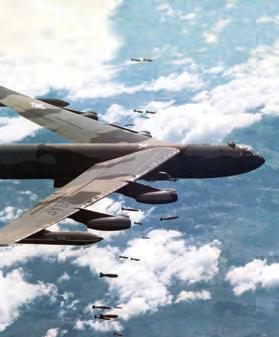

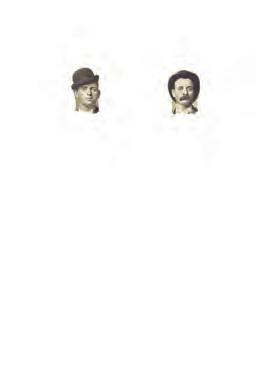







American soliders prepare to storm Omaha Beach on D-Day. How did Omaha and the other Normandy beaches get their code names?


Q: I am in my 80s and have read numerous books on World War II—but in all my years I have never seen who came up with the names of the five beaches on D-Day. Can you help?
—Robert Palmer, Pass Christian, Mississippi
A: The code names for the Normandy landing beaches are well known, but their exact origins are murky at best. In theory, World War II code names were randomly assigned from existing code books and were frequently changed due to concerns over security or appearance. Hence the three British/Canadian beaches were originally designated after species of fish: Gold, Jelly, and Sword. However, according to legend, no less a personage than Winston Churchill himself objected to the term “Jelly Beach”—he considered it too frivolous for the site where Canadian forces would kill and die, and suggested Juno in its place. (Churchill also objected to early code names for the entire invasion: “Roundup,” “Sledgehammer,” and the melded term “Roundhammer.” Churchill insisted on the more magisterial sounding “Overlord.”) Lesser known is “Band Beach,” proposed in a swampy area east of Sword. Considered for a possible landing, it was eventually deemed unnecessary and unsuitable. Presumably the term came from the bandfish species.
The origin of the American beach names is also uncertain. One anecdote, recorded by British historian Peter Caddick-Adams, recounts that two American soldiers were assigned to perform carpentry work at the headquarters of U.S. general Omar Bradley in London as the invasion plans were being developed. Chatting with the soldiers, Bradley discovered one was from Omaha, Nebraska, and the other from Provo, Utah. Soon, “Omaha” and “Utah” beaches appeared on Bradley’s planning maps to replace the code names “X-Ray” and “Yoke.” CaddickAdams calls this an “intriguing addendum to history, but impossible to verify.”
Regardless of the origins, the names Utah, Omaha, Gold, Juno, and Sword have made the transition from top-secret terms to common geographic usage in ways no other code names ever have.
—John D. Long is the director of education at the National D-Day Memorial Foundation in Bedford, Virginia.
The French port city of Marseille recently marked the 80th anniversary of the wartime roundup of Jews and suspected resistance fighters by German troops and French authorities (top). The January 1943 raids targeted the city’s Old Port district (above) and sent hundreds of Jews to their deaths.
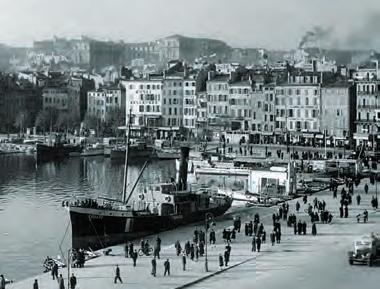
Mayor Benoît Payan told a crowd outside City Hall on January 29, 2023, that Marseille “represented everything the Nazis hated…. It was a cosmopolitan city where people of all backgrounds mingled.” After deporting its residents, the Germans and French police razed an entire section of the district, destroying more than 1,500 buildings.
French Minister of the Interior Gerald Darmanin told the audience the event “gets too little attention in the history books.” A photo exhibit planned for later this year will help keep it in public memory.
Giant Grab Bag of over 200 used US stamps includes obsolete issues as much as 100 years old. Also historic airmails and commemoratives. Each Grab Bag is different and yours is guaranteed to contain at least 200 used stamps. Perfect to start or add to a collection. Strict limit of one Grab Bag per address. Satisfaction guaranteed.
Send $1 for your Grab Bag today and you’ll also receive special collector’s information along with other interesting stamps on approval.

o Yes! Send me the Giant Grab Bag of 200 used US stamps. Enclosed is $1. Strict limit of one. Shipping and guaranteed delivery are FREE. My satisfaction is guaranteed.
4
Quick order at MysticAd.com/5H148
Name ___________________________________________________________________________________________
Address _________________________________________________________________________________________
City/State/Zip ____________________________________________________________________________________
IN THE SPRING OF 1945, Wally King was a young lieutenant flying a Republic P-47 Thunderbolt over Germany. During King’s last combat mission, his plane was hit by flak and he bailed out over enemy territory. He survived the last few weeks of World War II in captivity but was able to return home, raise a family, and start a successful career as a CPA, eventually owning one of the largest accounting firms in Pittsburgh. Today, the 99-year-old veteran serves as a volunteer for the Meals on Wheels program, visiting shut-ins and the infirm near his home in New Wilmington, Pennsylvania. The active almost-centenarian spoke with World War II about his military career.
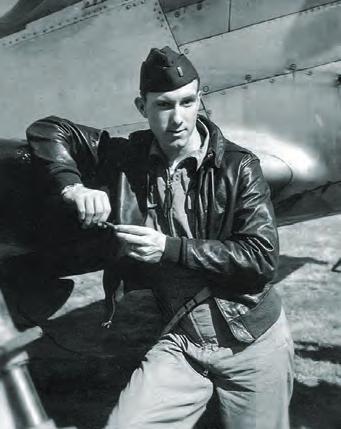

I turned 18 and graduated high school in 1942 in my hometown in Ohio. I went to the recruiting office and said I wanted to be a pilot. He said, “Let me sign you up and then once you’re in the army, you can ask to go for pilot training.”
Well, I didn’t fall for that. So they told me to go to Cleveland to apply for pilot training. I was called up for active duty in January 1943 and went through basic training.
I trained on P-40s in Tallahassee, Florida. Nice solid airplane, but certainly way behind other aircraft by that time. Then I shipped over to England in 1944 and went to Goxhill airfield on the North Sea to fly the P-51. Probably got about 30 hours in the air there. Then, after D-Day they flew us over to A-1 Airfield behind Utah Beach. I was assigned to the 363rd Fighter Group.
A few days later, the army deactivated the unit because they needed more photo reconnaissance. We could stay with Mustangs that had cameras in their bellies or transfer to fighter groups, which is what we did. I went to Le Mans and joined the 513th Squadron of the 406th Fighter Group in the Ninth Air Force. The operations officer took me out to a P-47 Thunderbolt for a cockpit check and then told me to fly it. The next day I flew my first combat mission.
How did the P-47 compare to the P-51? The Thunderbolt was a totally different airplane than the Mustang. It was much easier to fly. The P-47 was also a better ground-support airplane. It was a very honest fighter that didn’t have any quirky habits and could take a lot of punishment. One time, we hit a German night fighter field. I was flying low and looked over to my wingman, who was going down this concrete runway. I could see this fire on the end of his propeller. He was grinding it on the concrete! About five inches of his blade was gone. I never really had any major damage on the missions that I flew, except for the last one. The P-47 was a durable, tough machine.
You flew 75 missions during the war. What type of action did you experience?
Most of the time, we would fly along the battlefield and look for enemy vehicles. After the Falaise Gap [in mid-August 1944], the Germans were afraid to move because they would get strafed. We rarely saw vehicles on the road. Never saw many tanks. I did see a couple of Tigers, but we didn’t have anything that would damage them. If they were on a hard surface road, we would strafe the back of it and bounce the bullets up underneath to the fuel tanks. I did that once but can’t say it was effective.
Our targets were mostly marshaling yards, rail traffic, road bridges, and just cutting railroad lines. We’d send one plane down and drop bombs to blow the railroad tracks, then send another one a few miles away to do the same thing.
The most memorable mission was when the Ardennes Offensive began [on December 16, 1944]. Our group provided air cover during the Battle of the Bulge. We hadn’t flown for a week or more until the weather cleared a couple of days before Christmas. Our goal was to quiet the flak before air drops of supplies were made around Bastogne. We couldn’t see
anything because of the snow cover, so we bombed, fired rockets, and strafed the woods. Once the C-47 Dakotas pushed out supplies, a whole army of ants appeared out of the white snow. These guys had been dug in and started dragging those supplies into town.
What other missions did you fly?
Our squadron had the undesirable task of beating up flak before a parachute drop on the Rhine River near Wesel in March 1945. When we saw the line of transport planes coming, we went down to make a strafing pass. As I was coming up, the C-47s had already started dropping their people. A paratrooper went right over my wing! I thought, “This is suicide!” It looked like Dante’s Inferno. These C-47s were burning, they had engines out, paratroopers were being dropped in the river, gliders were crashing and, of course, the air was filled with flak. It looked to me like a colossal failure, but it wasn’t. They got pontoon bridges over the river and the tanks went across.
Let’s talk about your last mission, which you were told would be your last.
They called for an eight-plane mission on April 18, 1945. I was leading the second flight. I said to the squadron commander, “This is my 75th mission. Don’t you think it’s time to quit?” He said, “Yeah. This is going to be your last mission.” Little did I know!
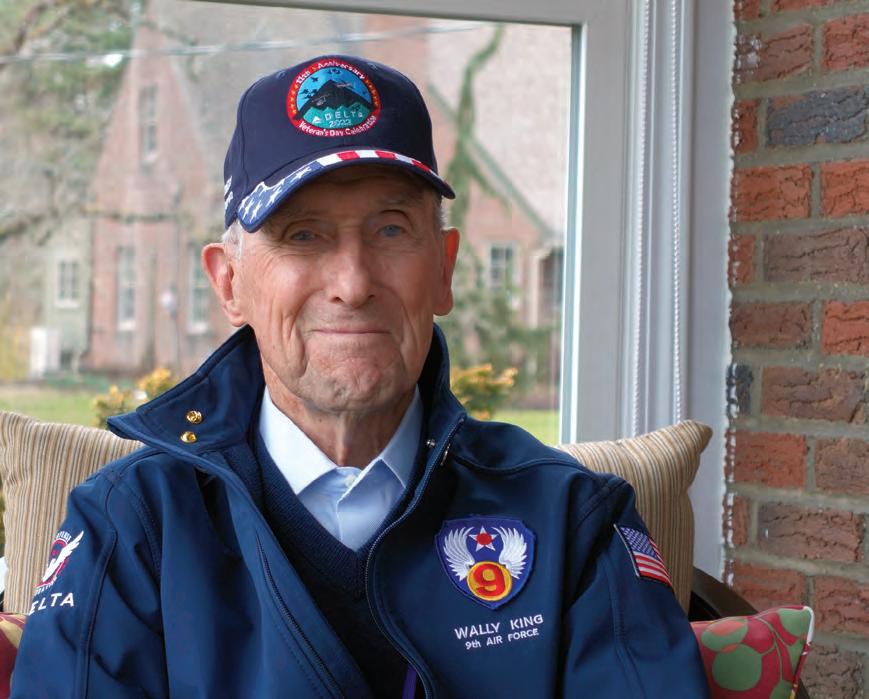
The army had reached the Elbe River and crossed over just south of Magdeburg. We were looking for targets of opportunity. On our way home, my wingman spotted a cannon on a railroad car and wanted to go after it. So we buzzed down to take a look.
I was pretty low but I wasn’t strafing. All of a sudden, there was a boom. I knew I had been hit in the engine by flak. Soon, fire was coming over the windshield. I looked down at my feet and saw the armor plate in front of the cockpit was melting. I said, “Time to go,
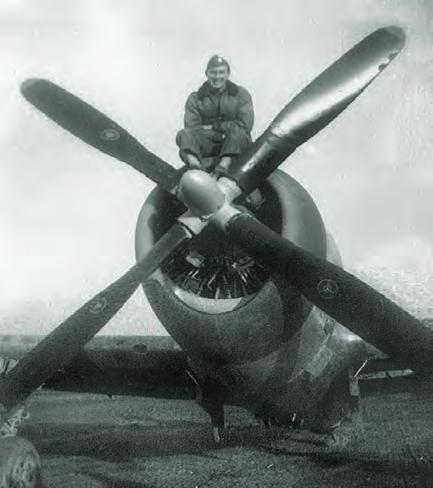
At the age of 99, King remains a captivating storyteller. Below: During the war, King perches atop his Thunderbolt, which he considered to be a “durable, tough machine.”
Wally!” I was like a cork out of a bottle! The chute opened and I was upside down. I got myself upright and I heard this noise whizzing by. I thought it was bees. It was civilians shooting rifles! I started swaying to make myself a poor target. I drifted over this house
into the backyard. I got down and could see the Elbe River. I thought maybe I could float downstream to an American bridge. I’d gone about 100 yards toward the river when this little boy tripped me. Then these guys showed up with rifles. I just put my hands up and surrendered. They took me into the house where a medic started working on me. I had burns on my face, a broken wrist, and a bad ankle. Then two German soldiers came in. They smashed me across the side with their guns and knocked me off a stool I was sitting on.
“I looked down at my feet and saw the armor plate in front of the cockpit was melting.”
King’s decorations from the war include the Purple Heart, Distinguished Flying Cross, and the Air Medal. He flew 75 missions during the war and came back safely from all of them—except the last one.

They hauled me out into the yard where the civilians started beating me. I’m pretty terrified. I am in the toughest situation of my life and I’ve never even thought about God. Once I said that, the most sublime peace settled over me. I felt God had come to take me home. That sense stayed with me for the two weeks I was a prisoner. Whatever happened to me was going to be all right.
The soldiers took me to a bunker, where this big, burly noncom was going to rearrange my teeth. A German officer just shoved him and started screaming. From what I could get, he was saying, “Would you like our pilots to be treated this way?”
It wasn’t long before a Mercedes staff car pulled up with two Wehrmacht officers. They brought me to a major, who looked like he had just walked off a movie set. There was all this destruction everywhere and he was dressed immaculately. He started asking me questions and I answered name, rank, and serial number. Just then the door banged open and in comes a Luftwaffe major, who was also immaculately dressed. They started shouting at each other. I knew what it was about. The Wehrmacht had no authority to hold American airmen. He was supposed to turn me over to the Luftwaffe.
So the Luftwaffe major took me to a dispensary where a medic starts working on me. He says, “You’re a lucky guy. The people in that village killed a bomber crew yesterday.”
A few days later, we evacuated the building. They took me to a house near the Russian front where other Americans were being treated. I was there for nearly two weeks and had little food. There were several American patients, but most were unconscious. An American captain told me he wanted to take these guys to a bridgehead about 40 miles away because no one was caring for them. Somehow, he found a couple of ambulances with fuel. So off we went with a German doctor and these other German soldiers, who had surrendered since the war was all but over now.
We made it to this castle, which looked like something you’d see at Disneyland. A lady came down and handed us keys to the fruit cellar. She said if the Russians get close, we should destroy all the food. This German officer said, “The Russians are close enough. Let’s eat!” So they made this big meal, which was the first real food I had had in two weeks. Then I found a bed in the castle—the biggest I had ever seen in my life—and went to sleep.
The next day, we headed for the American lines. Because of the German soldiers, we avoided the SS since they would kill these men for surrendering. We left after dark with no lights. American soldiers on a Jeep with a .50-caliber machine gun found us and guided us the rest of the way. We kept stopping so they could drag anti-tank mines off the road. We finally got there and they took me to the medical tent. They cleaned me up and took care of my burns and injuries. The next day, I was flown out with other burn patients to a hospital in France. I was there for about eight weeks. They finally sent me home on a Liberty ship loaded with cargo, tanks, and halftracks.
You went back to Europe last year as part of a Normandy tour. What was that like?
Delta flew us on a charter right to the beachhead—the first commercial airliner ever to land there. I wanted to find A-1, the first airstrip I landed at with the Mustang. I was near Sainte-Mère-Église, behind Utah Beach. My guide and I went to look for the airstrip. It was almost dark and we were about to give up when I spotted this monument. It said this was the site of A-1. I walked up this road that could have been the runway. I felt like I had been there before. It was a strange feeling standing on that spot where I had been 78 years ago.
You talk to groups about your experiences. What do you tell them?
I’m not a rah-rah-boy-we-won-the-war type of guy. I tell them that war is a nasty, dirty, evil business. There is nothing glamorous or glorious about war. I also tell them not all Germans were bad guys. That German doctor risked his own life for the Americans in his care. I wonder how many of those wounded guys would have made it if not for him.
I’m troubled by the fact that the U.S. college students and the high school students know nothing about World War II. Contrast that with France. We visited a school there and they were so engaged. They knew their history and asked intelligent questions. The headmaster asked the last question: “What advice do you have for these students?” I said, “Put down your cell phones and love one another.” H
You can’t always lie down in bed and sleep. Heartburn, cardiac problems, hip or back aches – and dozens of other ailments and worries. Those are the nights you’d give anything for a comfortable chair to sleep in: one that reclines to exactly the right degree, raises your feet and legs just where you want them, supports your head and shoulders properly, and operates at the touch of a button.


Our Perfect Sleep Chair® does all that and more. More than a chair or recliner, it’s designed to provide total comfort. Choose your preferred heat and massage settings, for hours of soothing relaxation. Reading or watching TV? Our chair’s recline technology allows you to pause the chair in an infinite number of settings. And best of all, it features a powerful lift mechanism that tilts the entire chair forward, making it easy to stand. You’ll love the other benefits, too. It helps with correct spinal alignment and promotes back pressure relief, to prevent back and muscle pain. The overstuffed, oversized biscuit style back and unique seat design will cradle you



OVER 100,000 SOLD
OVER 100,000 SOLD







in comfort. Generously filled, wide armrests provide enhanced arm support when sitting or reclining. It even has a battery backup in case of a power outage.










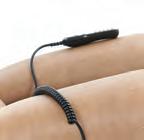

White glove delivery included in shipping charge. Professionals will deliver the chair to the exact spot in your home where you want it, unpack it, inspect it, test it, position it, and even carry the packaging away! You get your choice of Luxurious and Lasting Miralux, Genuine Leather, stain and liquid repellent Duralux with the classic leather look, or plush MicroLux microfiber, all handcrafted in a variety of colors to fit any decor. Call now!




1-888-420-8757
Please mention code






“To you, it’s the perfect lift chair. To me, it’s the best sleep chair I’ve ever had.”
— J. Fitzgerald, VA 3CHAIRS
I CAN VIVIDLY REMEMBER the first few interviews I did with veterans of the Second World War. One was with Wendy Maxwell, who had been a secretary to General Hastings Ismay (later Lord Ismay), military adviser to the British War Cabinet. She’d attended cabinet meetings and all the Allied conferences and had been at Nuremberg, too. It seemed incredible that the very elegant lady sitting opposite me had been a witness to such enormous events and met so many towering figures from history. A few weeks later, I chatted with a Battle of Britain Spitfire pilot, Geoff Wellum, in his local pub. He was terrific, holding his beer in one hand, an ashtray in the other (that’s how long ago it was) and saying, “So, I’m in my Spit, and this Me-109 is bearing down on me…”
Over the next few years I talked to veterans all over the world: Germans, Austrians, South Africans, Australians, French, Indians, Brits, and, of course, Americans. I reckon I’ve visited more than 30 states in my time. It was a huge privilege; these veterans were a living, tactile link to the past and helped me shift from a world that, in my mind’s eye, was monochrome to one of vivid color.
These 300 or so interviews of mine are all preserved, as are tens of thousands of others, so we do have an excellent—although sadly not comprehensive—global archive of veterans’ testimonies, but that greatest generation is now slipping away. It’s sad and makes me feel wistful and yet, as I have been discovering, there are still plenty of untapped voices from the war for the generations that follow to dis-

cover. A couple of years ago I was working on a book about a British tank regiment, and while I had a few interviews with veterans, I discovered it was the letters and diaries of those who served that were the most interesting and valuable. I was struck by their immediacy; after all, they had no idea how the war would play out, or even if they would make it through.
It was also astonishing how their young selves shone off every page. There was one 32-year-old tank commander who wrote the most touching letters back to his wife, full of longing, regret, hopes, and anxiety, but also of humor, too. I really felt I got to know him very well, and in writing about him was putting flesh back onto bones that had long ago been laid to rest. Another was a young officer who turned 21 on the day the Allies liberated Paris, August 25, 1944. He was very clearly a boy-man: old enough to command men and tanks in battle, but still young enough to be dependent on his parents and with a lack of worldliness that was very engaging. I cannot stress enough how upsetting it was to learn that he died less than a month later, on September 23.
I’ve since been doing some work on the Italian campaign and have deliberately decided to use contemporary sources as much as possible. The diaries and letters, written at a precise moment in time and on a particular day, are very moving. These servicemen obsess about letters from home and about aircraft in the skies. The Germans worry endlessly about the future, the fate of Germany, and what will happen to their families and homes back in the Reich. The Americans curse and grumble about the mud and rain but are extraordinarily stoic and phlegmatic. I’m in awe. One set of letters I’ve been reading are by an Australian serving in an Irish battalion who writes heartbreakingly to his wife about his best friend, a fellow officer, dying in his arms. It’s devastating to read, although even more tragic is that he, too, loses his life. And that’s it. The letters end.
I still believe oral histories are of immense value and feel very lucky to have spoken to so many veterans while I still had the chance, but men and women who are long gone from this world have been coming back to life for me in their words from 80 years ago, their young selves bursting from their pens. It has been utterly illuminating. H
● Easy One Touch Menu
● Large Fonts
200% Zoom
● 100% US Support
● Large Print Keyboard
If you find computers frustrating and confusing, you are not alone. When the Personal Computer was introduced, it was a simple. It has now become a complex Business Computer with thousands of programs for Accounting, Engineering, Databases, etc.
You want something easy, enjoyable, ready to go out of the box with just the programs you need. That’s why we created the Telikin One Touch computer.

Telikin is easy, just take it out of the box, plug it in and connect to the internet. Telikin will let you easily stay connected with friends and family, shop online, find the best prices, get home delivery, have doctor visits, video chat with the grand kids, share pictures, find old friends and more. Telikin One Touch is completely different.

One Touch Interface - A single touch takes you to Email, Web, Video Chat, Contacts, Photos, Games and more.
Large Fonts, 200% Zoom – Easy to see, easy to read.
Secure System – Telikin has never had a virus.
Voice Recognition - No one likes to type. Telikin has Speech to Text. You talk, it types.

Preloaded Software - All programs are pre-loaded and set up. Nothing to download.
100% US based support – Talk to a real person who wants to help

Secure System No Viruses!
Speech to Text You talk, It types!
Great Customer Ratings

This computer is not designed for business. It is designed for you!
" "This s was s a great t investment." "
Ryan M,CopperCanyon, TX
"Thank k you u again n for r making g a computer r for r seniors" "
Megan M,Hilliard, OH
"Telikin n support t is s truly y amazing.”
NickV,Central Point, OR
Call toll freeto find out more!

Mention Code 1224 for intro pricing. 60 Day money back guarantee
844-201-8310
FOR GENERATIONS OF BRITISH SERVICEMEN, the Mediterranean island of Malta came to be known as a place of “yells, bells, and smells,” and for good reason. Street hawkers loudly peddled their wares, and there always seemed to be a local festa somewhere, accompanied by booming fireworks and the ringing of parish church bells. During the often unbearably hot and dusty summers, one routinely encountered herds of shoats (supposedly a sheep-goat hybrid), horse- and donkey-drawn carts, and numerous stray cats and dogs. The mess such creatures left behind worsened after festering in the summer sun, making it a hazardous undertaking to negotiate the island’s narrow streets.
My mother was Maltese. She married my father, who was in the Royal Navy, in 1955. I was born over a year later. My early memories are of 1960s Malta, a very different place from the island today. There was a very noticeable British military presence then, but that had changed by the 1980s. The island had also begun to undergo massive redevelopment, slowly at first, and then with startling rapidity. As in times past, the roads can still be difficult to negotiate, but now it is because of traffic congestion. And while much of the original architecture remains—not least the magnificent Baroque churches—entire streets have been transformed elsewhere, with traditional balconied homes, none of them alike, having been replaced by characterless high-rise apartment blocks. Those who desire the hustle and bustle of the new Malta will not be disappointed. The capital city, Valletta, is always busy and provides an eclectic choice of
tourist sites, shops, restaurants, and bars.
In the early 1800s, after the British ousted a French occupation force, Malta became part of the British Empire. It soon became a popular posting for the armed forces, with Grand Harbour providing a natural deep-water port for the Royal Navy’s warships. In the 20th century, British army battalions were based at various locations around the island, while the Royal Air Force (RAF) maintained a modest presence at Luqa, today’s International Airport, in central Malta.

Being part of the British Empire had its benefits, but it was also not without its perils. When Britain declared war on Germany in 1939, hostilities were initially confined mainly to northern Europe and the Atlantic Ocean. But on June 10, 1940, Italy joined Germany in the war against Britain and France. At dawn the very next day, units of the Italian air force, the Regia Aeronautica, commenced operations against Malta. At the time, Malta’s fighter force consisted of no more than four Gloster Sea Gladiator biplanes, acquired from the Royal Navy by the RAF. These planes and a half-dozen pilots were hastily formed into a Fighter Flight. Opposing them from bases in Sicily was a variety of Italian aircraft of 2a Squadra Aerea, including Fiat CR.42 and Macchi C.200 fighters.
In January 1941, units of the Luftwaffe joined the Italian effort to neutralize Malta as an effective Allied base. As the war continued, Malta received steady reinforcements of British troops, antiaircraft guns, and Hawker Hurricane fighters. The RAF included volun-
teers from South Africa, Rhodesia, and the United States, as well as pilots and aircrews from the air forces of Australia, New Zealand, and Canada. From Malta, fighters and bombers, together with warships and submarines, struck at Axis Mediterranean supply convoys, presenting a very serious threat to Italo-German forces in North Africa.
In March 1942, the first Supermarine Spitfire Mk Vs landed on Malta. These new fighters quickly made their presence felt. In the hands of an experienced pilot, the Spitfire V was a formidable machine, with the speed and maneuverability to take on the latest Messerschmitt Me-109F fighter and the necessary firepower to destroy the Junkers Ju-88 bomber.
Throughout its ordeal, Malta continued to receive supplies by sea, but at heavy cost to the Merchant Navy and escorting warships and their crews. The islanders endured well over 3,000 air alerts. More than 1,500 people lost their lives and many more were injured. Malta held out and emerged undefeated and triumphant following the failure of the final Axis air offensive at the end of October 1942. Britain continued its long military association with the island until withdrawing its remaining units in 1979.
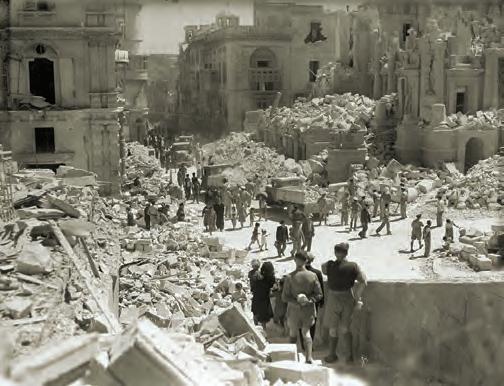

Today, Malta has a number of museums devoted wholly or in part to its role in World War II. The National War Museum is the oldest of these and owes its origins to a group of dedicated enthusiasts who opened an exhibition at Valletta’s Fort St. Elmo in May 1975. This led to the inauguration of the National War Museum in 1979.

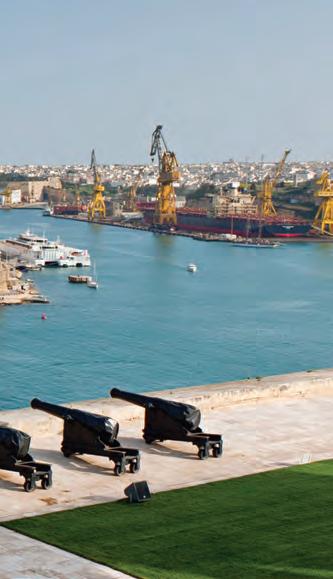
I was more than familiar with the original museum prior to 2015, when it moved from Lower St. Elmo to elsewhere within the fort. Today it covers all eras of Malta’s military history. On a recent visit I sought out several of the museum’s World War II displays, including the George Cross that King George VI awarded to the island on April 15, 1942, at the height of the Battle of Malta. The restored fuselage of the only surviving Malta Gladiator (N5520, known as Faith) is positioned a little too high to be fully appreciated, but a Willys Jeep has a prominent place in a spacious setting. General Dwight
D. Eisenhower used the vehicle when he was in Malta to prepare for Operation Husky—the Allied invasion of Sicily—after which it was presented to Air Vice Marshal Sir Keith Park, Air Officer Commanding (AOC) Malta. The jeep later transported President Franklin D. Roosevelt when he visited the island in December 1943.
Other World War II sites include the Malta at War Museum, the War Headquarters Tunnels, and the Lascaris War Rooms. The Malta at War Museum is in a former wartime police station at Couvre Porte, Birgu (also called Vittoriosa). I visited it for the first time in February 2023 and was pleasantly surprised with Artifacts at the National War Museum (above) recall Malta’s role in the war, when Axis bombs reduced much of the island to rubble (below).
Takali (Ta’ Qali). A main focus has been the restoration and display of historic aircraft. The first such venture was rebuilding a Spitfire Mk IX—a later variant of the Spitfire V flown during the
southwest of the village of Qrendi, on farmland accessible via a lane off Triq ta’ Ħassajeq, shortly before it joins Triq Ħaġar Qim—but do ask the farmer before entering his property. H
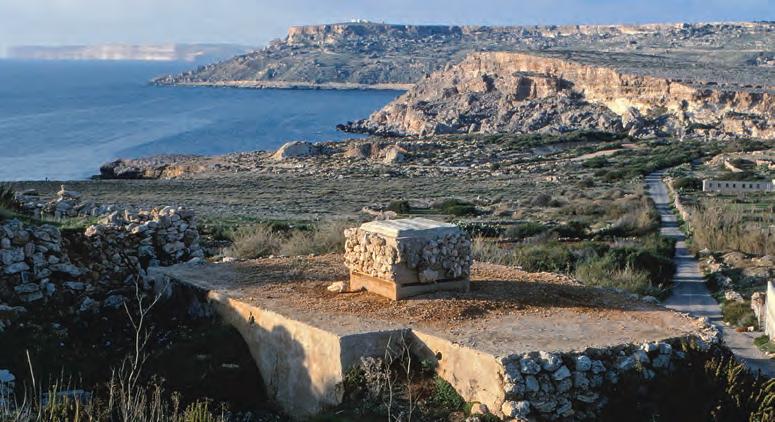
Malta is situated in the central Mediterranean Sea. Air Malta provides regular flights from numerous European destinations, and a ferry service runs between the island and Sicily, some 55 miles north. The best time of the year to visit is late spring or summer, although it tends to get quite hot from June to August. Getting around is easy. There are cabs, but Malta’s buses are an inexpensive, reliable, and convenient mode of travel. Most museums are run by either Heritage Malta heritagemalta.mt), a government department, or Fondazzjoni Wirt Artna wirtartna.org), a volunteerbased NGO.

Hotels and tourist accommodation vary considerably. If you’re looking for nightlife, opt for St. Julian’s or St. Paul’s Bay. A quieter time may be had in Mellieha. Xara Palace xarapalace.com.mt) is a converted 17th-century palazzo and the only hotel within the walls of the ancient city of Mdina. Bars and cafés are many and all around, and restaurants cater to every kind of taste—the local cuisine is typically fish, rabbit, or pasta.
Besides the exhibits on display, the National War Museum (heritagemalta. mt/explore) is worth visiting for its location. Fort St. Elmo, overlooking Grand Harbour, was a strongpoint during the Great Siege of 1565, which ended in defeat for invading Ottoman forces.
MAY 6, 1996
FORMER DIRECTOR OF THE CENTRAL INTELLIGENCE AGENCY WILLIAM COLBY IS FOUND DEAD ON A RIVERBANK IN ROCK POINT, MD. AN AVID OUTDOORSMAN, HE HAD SET OUT ON A SOLO CANOE TRIP NINE DAYS EARLIER. CONSPIRACY THEORIES ABOUND REGARDING THE CAUSE OF HIS DEATH. CLOAK AND DAGGER DAYS BEHIND HIM, COLBY WAS QUOTED AS SAYING “THE COLD WAR IS OVER, AND THE MILITARY THREAT IS NOW FAR LESS, IT’S TIME TO CUT OUR MILITARY BUDGET BY 50 PERCENT AND TO INVEST THAT MONEY IN OUR SCHOOLS, OUR HEALTH CARE, AND OUR ECONOMY.”
For more, visit HISTORYNET.COM/ TODAY-IN-HISTORY


U.S. Navy personnel on Corregidor continued deciphering Japanese messages even as the enemy closed in—and they knew they couldn’t be taken alive
By February 1942, the 74 men of Station Cast on the Philippine island of Corregidor had become some of the most important sailors in the U.S. Navy. These radio operators, linguists, and cryptanalysts were eavesdropping on enemy radio transmissions and had made steady progress deciphering the Japanese naval code. The U.S. military hoped this top-secret project would soon give the United States advance notice of the Imperial Japanese Navy’s plans.
Station Cast’s problem was its location. The Japanese had invaded the Philippines two months earlier and were pushing the American and Filipino defenders back toward a last-ditch stand on the Bataan peninsula on the island of Luzon. Corregidor, a small fortified island in Manila Bay, lay only two miles off Bataan. If Bataan fell, which seemed inevitable, Corregidor would soon follow.
The navy couldn’t let Station Cast’s personnel fall into enemy hands. The Japanese knew what these men were doing and would torture them to
Codebreaking personnel of Station Cast in the tunnels of Corregidor show the strain of knowing the Japanese are approaching. The top-secret work the men did here had to be kept from the enemy, one way or another.

BY THE TIME the United States entered the war in December 1941, the U.S. Navy had made codebreaking a high priority. The Japanese relied heavily on radio signals to send information to their bases and warships across the Pacific, and their communication

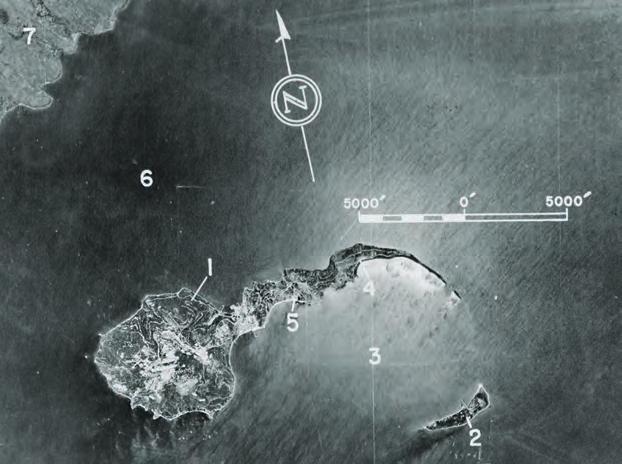
ing off to the sides. It was stocked with hightech equipment that included 11 National model RAO shortwave radio receivers, 21 specially built Underwood typewriters to translate Morse code into the Japanese alphabet, various IBM machines that were precursors of modern computers, and direction-finding equipment to determine the origin of enemy radio transmissions. It also housed a so-called Purple machine, which decrypted Japanese diplomatic messages and was one of the fewer than a dozen such machines in existence.
Station Cast was a hush-hush operation, and security was tight. A double iron gate blocked the tunnel’s entrance. Classified documents were stored in a vault protected by a triple-combination lock, and a Marine sentry stood guard at the tunnel entrance 24 hours a day. To disguise the outfit’s true purpose, it was called the Emergency Radio Station, with a cover story that it was merely a back-up communications system for the U.S. Asiatic Fleet.
The station had two components: a general unit, which did the interception work, and a special unit, which analyzed the intercepted messages. The cryptanalysts were a special breed. Their work required a high IQ, an abundance of curiosity, and painstaking attention to detail. They were dedicated to their craft. “I have never seen a more devoted group of workers. Many of us often worked two shifts a day,” said Ensign Laurance L. MacKallor, one of the codebreakers. “The work was too challenging to put down as long as one could keep his eyes open.”
The tunnel protected the men from the frequent bombing raids, but the war hit home in other ways. Lieutenant Rudolph J. Fabian, a cryptanalyst, had stockpiled crates of food for Station Cast, but the army confiscated these rations and put them into the communal pot for the entire Corregidor garrison. After that, said Chief Yeoman John E. “Vince” Chamberlin, Station Cast’s personnel ate only two sparse meals a day, mostly spaghetti and soggy rice. The skimpy fare wasn’t enough for active men in a tropical climate, and all lost weight. In four months, for example, Chief Radioman Sidney A. Burnett dropped 53 pounds, and Chamberlin lost 40. Occasionally, the chow contained meat, and when it did, Radioman James B. Capron Jr. worried that Monkey Point had gotten its name for a reason.
Corregidor was a likely target for a Japanese landing, so all troops, regardless of spe-
cialty or assignment, trained to defend its beaches. This posed a problem for Station Cast, whose arsenal consisted of only two .45-caliber pistols and one .22-caliber rifle, but an enterprising chief petty officer found a sunken barge in shallow water nearby and salvaged several crates of .30-caliber Enfield rifles. The men cleaned these weapons and practiced infantry drills, calling themselves the Monkey Point Militia.
The Japanese blockade isolated Corregidor from the outside world, and the men were on their own. No mail could get through from home, so their only contact with the United States came when they tuned in KGEI, a shortwave radio station in San Francisco. The codebreakers knew that Corregidor was doomed and in January 1942 they began burning sensitive documents, including used carbon paper, and destroyed any equipment they didn’t need for daily operations.

The navy high command pondered Station
Top: American codebreakers put together a machine that helped them crack the Japanese “Purple” diplomatic code. Above: This piece of a Purple machine was taken from the Japanese embassy in Berlin at the end of the war. Background: Encrypted Purple messages looked like random letters. The handwritten notations were to indicate how to adjust the machine’s rotors to break the code.


Cast’s future. It realized it couldn’t let these men fall into Japanese hands. “Their loss would represent a severe setback to our Communication Intelligence activities,” the brass noted on January 23. It recommended evacuation, but that presented daunting problems. Dodging the Japanese blockade to get out of the Philippines would be risky, and the loss of these men would eliminate nearly half of the American codebreakers in the Pacific theater. A mass evacuation was out of the question because, even if it succeeded, it would put Station Cast out of business for weeks as the men traveled to Australia and set up shop there. At this critical juncture in the war the codebreaking activities were essential. “Communication Intelligence organization…is of such importance to successful prosecution of war in Far East that special effort should be made to preserve continuity,” insisted Admiral Ernest J. King, commander-in-chief of the U.S. Fleet and, beginning in March 1942, chief of naval operations.
King ordered the men to be taken out in stages so Station Cast could keep operating on Corregidor for as long as possible. He knew the Japanese would eventually capture the island, but he couldn’t predict how much longer Bataan or Corregidor could hold out. He believed a staged evacuation was worth the risk.
While the high command pondered its options, the codebreakers learned there was a far more drastic plan in play. One evening, Radioman Duane L. Whitlock saw two officers in the tunnel sitting at their desks and cleaning their .45-caliber pistols. He jokingly asked if they were expecting a visit from the Japanese that night, but they didn’t smile. “No, these are for you and the others,” one of them explained. “We have discussed it between us and have decided we will not let a single one of you fall into their hands. When the time comes, we are going to shoot every one of you, then shoot ourselves.” Whitlock knew the officers weren’t kidding around. The general feeling, Radioman Burnett said, was that if “any of us got off the place alive, it would be a miracle.”
THE EVACUATIONS BEGAN on February 5, 1942, at 7:31 p.m., when the submarine USS Seadragon (SS-194) surfaced off the coast of Corregidor. It left 15 minutes later, carrying four officers and 13 enlisted men from Station Cast. The submarine took them to the Netherland East Indies (now Indonesia). From there, they went to Australia to begin setting up a new Station Cast. The evacuation happened unexpectedly and on short notice, leaving the 57 men left behind startled to find their 17 colleagues gone so quickly that they had to leave all their worldly goods behind. Their clothing went into a “lucky bag” for communal use, and Chief Machinist’s Mate J.W. “Pappy” Lowery received their cigarettes for rationing. Station Cast remained in business. The navy had made sure that enough linguists, cryptanalysts, and radiomen stayed behind to do the work.
By March, the Japanese continued to push the Allied defenders farther back on Bataan. The navy high command realized that Bataan and Corregidor could fall at any time. “Evacuate personnel of Radio Intelligence Unit soon as possible…. Take all steps possible to prevent loss of personnel of Radio Intelligence Unit,” Admiral King ordered on March 5.
The evacuation would take time. While they waited, the men continued their daily work, and on March 16 they made a discovery, seemingly routine at the time, that justified King’s insistence on keeping the station open. The cryptanalysts determined that “AF” was

the coded designation that the Japanese used for the Pacific atoll of Midway, a vital U.S. base 1,100 miles northwest of Pearl Harbor. Station Cast relayed this information to Station Hypo in Hawaii.
That same day, the submarine USS Permit (SS-178) docked off Corregidor. It had originally been sent to evacuate General MacArthur and his staff, but MacArthur had left by PT boat five days earlier, a method of escape deemed impractical for the much larger number of Station Cast personnel and their equipment. Instead, the Permit took on board four officers and 32 enlisted men from Station Cast, as well as other assorted evacuees. The Permit now carried 111 men, nearly double its normal complement. Its mission was to get the codebreakers safely to Australia, but the submarine received orders to make a detour to hunt Japanese warships. It was a puzzling directive, since the men from Station Cast would be lost if the Permit were sunk.
That almost happened the next day. At 8:10 p.m., skipper G. “Moon” Chapple spotted three enemy destroyers near Tayabas Bay, southeast of Corregidor. Within minutes he fired two torpedoes from a range of 2,000 yards. The torpedoes missed but attracted the destroyers’ undivided attention. At 8:22 p.m., the Permit dove and the enemy ships attacked, dropping 12 depth charges that rattled the submarine, shaking bunks loose from bulkheads and light bulbs from their sockets. The persistent destroyers continued to hunt for the Permit with depth charges. With 111 men aboard the submerged submarine, the air soon became foul. There wasn’t even enough oxygen to light a match, Radioman Whitlock said, and Chapple took emergency steps to prevent suffocation. The Permit finally surfaced at 6:55 p.m. on March 18 after having been submerged for a harrowing 22 hours and 33 minutes. Ensign MacKallor called the episode “the most terrifying experience that I have ever undergone.” The Permit reached Australia on April 7.
NOW ONLY 21 MEN, including station commander Lieutenant John M. “Honest John” Lietwiler, remained behind to run Station Cast. They continued their interception and decryption work, usually toiling for 16-18 hours a day, but they knew that time was running out.

Of special concern was the Purple machine
used to read diplomatic messages and the specialized IBM equipment used for decryption. The navy didn’t want these items to be captured because they might tip the Japanese off to American codebreaking secrets.
The men chopped up the Purple machine and dumped the pieces into deep water in Manila Bay. They saved the IBM equipment because Lietwiler wanted to use it in Australia. He assigned Ensign Ralph E. Cook, a former IBM engineer, to disassemble the equipment and pack it in crates so they could take it with them on a submarine. In case the

Japanese ended up capturing the machines, Cook decided to create “a complex puzzle” for anyone trying to reassemble the equipment. He cut the devices’ cables and labeled their dozens of wires in a distinctive way that only he understood. To create further confusion, he threw some random parts into the crates.
On April 3, the Japanese launched a final offensive on Bataan, slicing through the American and Philippine lines. By April 8, Bataan’s commander, Major General Edward P. King Jr., decided he had no alternative but to surrender the next day. Once Bataan surrendered, Corregidor’s days would be numbered.
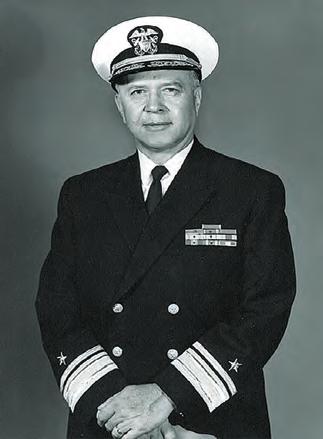
On the evening of April 8, Radioman Burnett answered the phone in the tunnel. “Sid, run like hell,” the caller said. “We are loading out in a few minutes.” The last 21 men of Station Cast scrambled onto a waiting truck and rode to the dock.
Yeoman Chamberlin described the scene that awaited them as “Dante’s Inferno PLUS.” Explosions rocked the ground and lit the night sky as the Bataan garrison destroyed its fuel and ammunition dumps in anticipation of surrender. In an attempt to give the defenders some breathing room, Corregidor’s artillery roared at Bataan, with muzzle flashes leaping 100 feet into the sky. Even nature got involved, as an earthquake shook the area.
When Chamberlin looked at his comrades, he saw a “ragtag bunch in worn, torn dungarees or khakis, underweight from malnutri-
tion….” The accumulated stress showed, he said, and the men’s faces bore the “spectral look we came to call ‘The Corregidor Stare.’”
The men boarded a waiting submarine, the Seadragon, but there wasn’t enough time to load the crated IBM equipment before the submarine shoved off at 9:57 p.m. Once underway, the sub’s crew treated the codebreakers like royalty, showering them with cigars, candy, and cookies, delicacies that were unknown on Corregidor. They even let the evacuees use their bunks, and the men got their first good night’s sleep in months. There was also one unexpected passenger. In the chaos of the evacuation, a machinist’s mate from Corregidor had snuck onto the submarine as a stowaway, preferring a stay in the brig to a Japanese prison camp.

As with the Permit three weeks earlier, the Seadragon received orders to seek targets in Philippine waters after picking up the codebreakers. At 4:49 p.m. on April 11, skipper W.E. “Pete” Ferrall spotted a Japanese destroyer near Subic Bay, north of Corregidor, and fired three torpedoes from a range of 1,800 yards. All missed, and the destroyer dropped six depth charges near the submarine. “[N]one very close,” Ferrall noted in his patrol log. He asked the evacuees if the attack had frightened them. “Hell, no,” Burnett answered. He knew that sweating out depth charges was better than the fate that had awaited him on Corregidor.
The Seadragon reached Australia on April 26. All the passengers, including the stowaway, were “most happy to walk ashore in a friendly port,” Ensign Cook said.
The enemy invaded Corregidor on May 5,
Cook decided to create a complex puzzle for anyone who tried to reassemble the equipment.
less than a month after the last codebreakers had departed, and the American and Filipino defenders surrendered the next day. Naval intelligence suspected that the Japanese had a complete roster of Station Cast personnel, possibly seized when they overran the Cavite naval yard near Manila four months earlier. The enemy made diligent efforts to find the Station Cast personnel among the Corregidor prisoners, but by this time they were all safely in Australia, continuing their interception and decryption work in Melbourne under the name FRUMEL (Fleet Radio Unit, Melbourne). The Japanese did find the crated IBM machines that had been left behind and realized their importance. They took the equipment to Tokyo so they could get it working and study American codebreaking technology. Ensign Cook, however, had done his job well and the Japanese never figured out his idiosyncratic wiring system.

Station Cast’s discovery that “AF” was the Japanese designation for Midway paid huge dividends. In early May 1942, Station Hypo determined that Japanese forces were gathering for a major operation but didn’t know where they would strike. Days later, it intercepted messages referring to “invasion force AF” and the “AF occupation force.” Now it knew that Midway was the target. Forewarned, the heavily outnumbered Pacific Fleet ambushed the Japanese forces advancing toward Midway on June 4, 1942, sinking four enemy carriers and winning a stunning victory that changed the course of the Pacific war.
The Intercept Tunnel, home to Station Cast, didn’t survive the war intact. On February 16, 1945, U.S. forces landed on Corregidor to
retake the island. Ten days later, as they mopped up resistance near Monkey Point, a large cache of Japanese explosives stored in the tunnel detonated. The blast was so powerful that it tossed a 34-ton M4 Sherman tank 50 yards through the air, killing most of the crew, and threw debris so far that some hit a destroyer 2,000 yards offshore. The explosion killed 50 G.I.s and wounded 150 more.
It was an ignominious end for the place where only three years earlier, a small band of dedicated and ingenious codebreakers had helped turn the tide of the Pacific war and put the United States on the road to victory. H

The Hollywood director found himself in the middle of the action at a pivotal time in the Pacific War
 By Tom Huntington
By Tom Huntington
Midway atoll’s “gooney birds” are mute witnesses to the aftermath of the Japanese attack on June 4, 1942. Inset: Another witness was director John Ford, who was on Midway and captured the action on film for the navy.
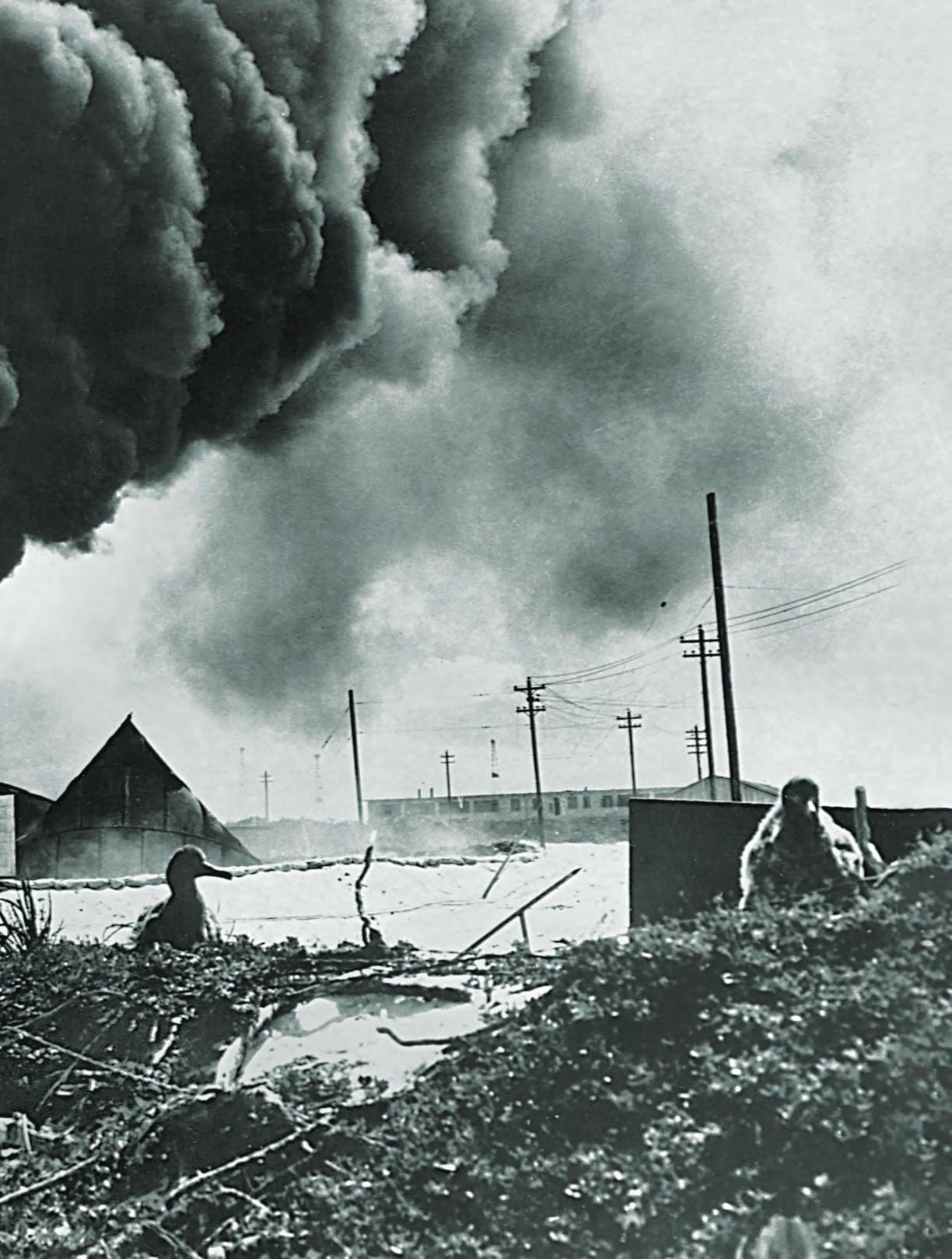
On the afternoon of December 7, 1941, director John Ford and his wife were attending a luncheon at the home of Rear Admiral Andrew C. Pickens in Alexandria, Virginia. The host excused himself to take a call from the War Department. When he returned, he told his guests that the Japanese had attacked Pearl Harbor. “We are at war,” he said.
Ford was ready.
He had been born John Martin Feeney in Cape Elizabeth, Maine, on February 1, 1894, the son of Irish immigrants who had settled in nearby Portland, where the elder Feeney operated a bar. Young John played on the Portland High School football team and graduated in 1914. His high school nickname, probably because of his football prowess, was “Bull.”
When Feeney’s older brother Francis headed west and found work as an actor and director in California, young John followed—and assumed his brother’s stage name of Ford as well. Eventually John Ford began directing his own films. By the time of Pearl Harbor he was one of Hollywood’s most respected directors, with a resume that included The Iron Horse (1924), Young Mr. Lincoln (1939), The Grapes of Wrath (1940), How Green Was My Valley (1941), and even a Shirley Temple film, Wee Willie Winkie (1937). In his 1939 Western Stagecoach, Ford turned a relatively obscure actor named John Wayne into a star. That was also the first movie Ford shot in the Southwest’s Monument Valley, a setting he made iconic in his postwar Westerns.
Yet for all his talent, John Ford was a flawed human being with a strong streak of pure New England cussedness. “Actors were terrified of him because he liked to terrify them,” said John Carradine, who acted for Ford in several films. “He was a sadist.” Ford became known for the way he
Ford loved spending time on his yacht Araner and he sometimes used the vessel to keep an eye on Japanese ships he encountered at sea. He also used it for boisterous getaways.

needled his actors, especially Wayne, during filming and for his tendency to go on drunken benders between projects. According to one acquaintance, “It was as though God had touched John Ford at the beginning of his life and said, ‘How would you like to be a very unique man—like no one else. However, you may scare some people.’”
Ford had always nursed a love for the sea, perhaps inspired by his youth on Maine’s Casco Bay. In the 1930s he enlisted in the Navy Reserve with a commission as a lieutenant commander, and as tensions with Japan increased, he sometimes used his yacht Araner to shadow any Japanese vessels he encountered off the California coast. He started the Eleventh Naval District Motion Picture and Still Photographic Group in 1939 as a means of documenting the navy’s activities
in the impending war and began recruiting friends from all aspects of the film industry to help. As he later said, “They are writers, directors, some actors, but mostly technicians, electricians, cutters, sound cutters, negative cutters, positive cutters, carpenters, and that sort of thing.” The navy called the 47-year-old Ford to active duty in September 1941 as a lieutenant commander and he went to Washington, where his photographic unit was assigned to work under William J. Donovan, the head of the Office of Strategic Services, the precursor to the Central Intelligence Agency.
In his new role Ford visited Iceland and Panama to survey the military situations there. After the attack on Pearl Harbor he received orders to head to Hawaii to film the aftermath. He and a crew embarked on the trip west on January 4, 1942. Twelve days later he was at Pearl Harbor, which he found “in a state of readiness. The Army and the Navy, all in good shape, everything taken care of, patrols going out regularly, everybody in high spirit[s]…”
On April 18, 1942, Lt. Col. James Doolittle and his raiders took off in twin-engine B-25 Mitchells from the carrier USS Hornet to bomb Tokyo. Although the Doolittle Raid did little physical damage to Japan, it dealt a psychological blow. Shocked by the American attack on its mainland, the Japanese military decided to move aggressively across the Pacific to prevent any more raids. One of its targets was a tiny atoll with an airstrip 1,110 miles northwest of Hawaii called Midway. It was little more than a speck in the vast Pacific, populated mostly by a species of albatross that people called gooney birds, but Midway was also the U.S. Navy’s westernmost base and home to a Marine detachment. Pan American World Airways had used Midway as a base for its Clippers, and navy submarines fueled there, too. A pair of Japanese destroyers had shelled Midway on the night of December 7, 1941, and the Japanese speculated that perhaps Doolittle’s men had taken off from the atoll for their attack. Furthermore, Japanese Admiral Isoroku Yamamoto, the mastermind behind the Pearl Harbor attack, believed that if he threatened Midway, he could draw the U.S. Pacific Fleet under Admiral Chester W. Nimitz out from Hawaii and into battle.
The U.S. Navy had cracked Japanese codes and knew that Midway was in the crosshairs, and Nimitz wanted Ford to photograph the
fighting once it erupted. Sometime in late May 1942 he summoned Ford to his office at Pearl Harbor, said he had a dangerous assignment for him, and told him to report to Admiral David W. Bagley. Ford and cameraman Jack Mackenzie Jr. were soon zipping across the harbor in a speedboat for a rendezvous with a destroyer that was already underway. “Hadn’t the slightest idea what I was doing, where I was going,” Ford said. “I found out when I got on board the destination was Midway.”
ALL WAS QUIET on Midway when Ford and Mackenzie arrived. “All the year around it’s the same out there on that little Pacific island,” Mackenzie told American Cinematographer magazine. “The grandest place in the whole ocean to find absolute quiet and peace— if that’s what you want.” Ford spent time photographing the island’s gooney birds and the PT boats that had accompanied the task force. He remained doubtful that the Japanese would really attack but, forewarned by the codebreakers, the navy had been scrambling to bolster the atoll’s defenses by flying in more aircraft and reinforcing the ground forces.
“By June 4 there were 121 combat planes, 141 officers and 2,886 enlisted men on the atoll,”
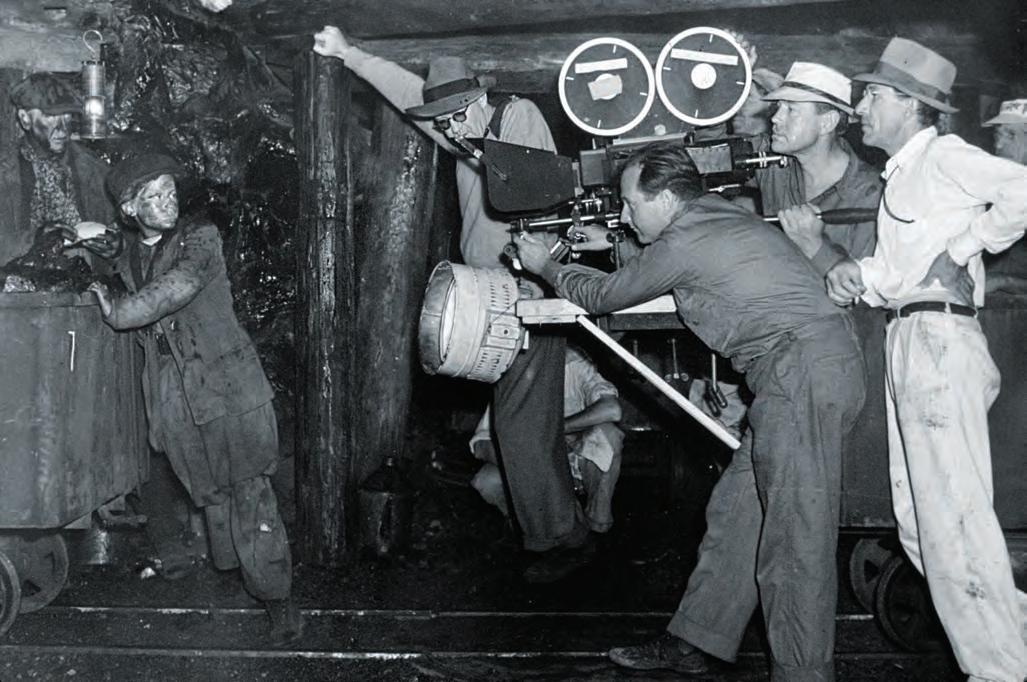
noted Samuel Eliot Morison in his history of naval operations during the war.
On June 3, Ford said, Commander Massie Hughes invited him aboard a PBY Catalina flying boats for a patrol. At first they saw nothing, Ford claimed, but then they got a glimpse of enemy vessels through a break in the clouds. When a couple of Japanese airplanes appeared to spot the PBY, Hughes headed into the clouds, and then descended for a wave-hugging return to Midway.
Something, Ford realized, “was about to pop.” Another Catalina spotted what appeared to be the Japanese invasion fleet and the commander of Naval Air Station Midway, Captain Cyril T. Simard, sent out B-17s and Catalinas to attack the vessels, with little result. Simard expected the Japanese to attack the next morning and suggested that Ford place himself on top of the powerhouse, where he would have a good view of the impending action as well as a telephone link to headquarters. Ford and Mackenzie set up and went to bed.

Simard was right about the attack, although the morning of June 4 started off calmly enough. “Everything was very quiet and serene,” Ford says. He and Mackenzie shared the powerhouse with some Marines who had also stationed themselves on the roof. The filmmakers had a pair of 16mm cameras loaded with color film. Sometime around 6:30 that morning Ford was scanning the sky with binoculars when he spotted the first black dots that meant incoming Japanese aircraft. There were 108 airplanes in all, including 36 Nakajima B5N “Kate” bombers, 36 Aichi D3A “Val” dive b ombers, and 36 Mitsubishi A6M “Zero” fighters, and they had been launched from four carriers about 200 miles out to sea. Midway’s radar had already picked them up and the defenders were braced for the



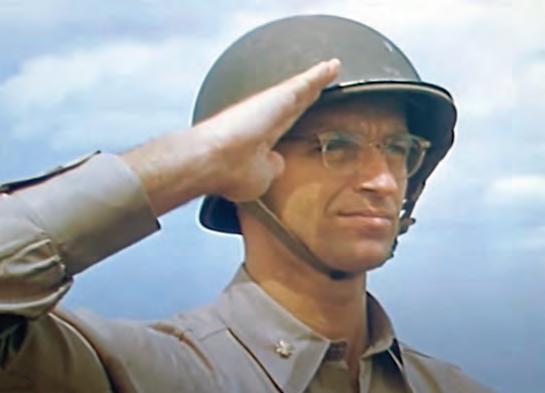

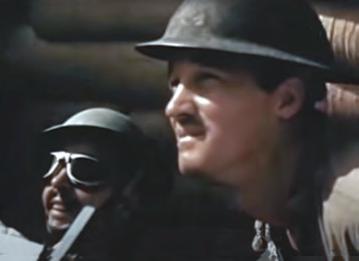


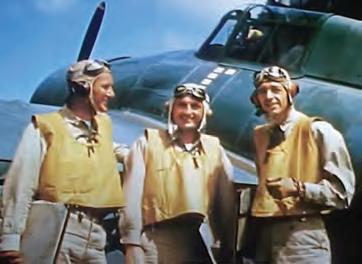

onslaught. “Everybody was very calm. I was amazed, sort of, at the lackadaisical air everybody took,” Ford said. It was as though this kind of thing happened all the time.
The Japanese planes roared in to attack. According to Ford, the lead pilot shocked everybody by flipping his Zero on its back and flying upside down about 100 feet off the ground in a show of bravado. “Everybody was amazed, nobody fired at him, until suddenly some Marine said, ‘What the Hell,’ let go at him and then shot him down,” said Ford. “He slid off into the sea.”
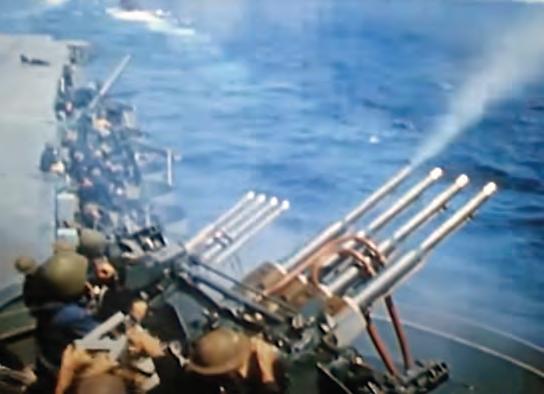



Then the attack started “in earnest.” Bombs exploded nearby, shaking the cameras. A plane dropped a bomb on the garrison’s hangar, which exploded. A piece of concrete struck Ford in the head and briefly knocked him out. “Just knocked me goofy for a bit, and I pulled myself out of it.” Recovering, Ford continued to film despite also receiving an ugly, three-inch shrapnel wound in his arm.
Mackenzie, who kept a lucky rabbit’s foot in his pocket, had also been knocked down by the blast, and he regretted missing a shot of the explosion because he had been reloading film when it happened. He
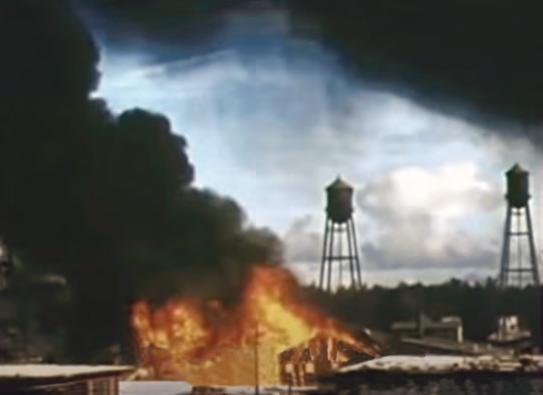
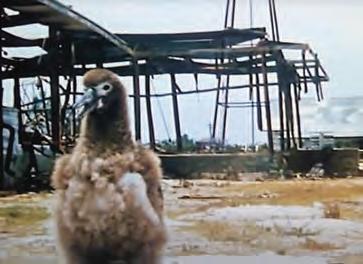
recovered and scrambled down a ladder to the ground and resumed shooting. “By this time [the Japanese] had riddled the hangars and set them on fire,” he recalled. “The hospital too was smashed and on fire, and the commissary was all busted up and burning fierce and one of our oil tanks was on fire sending a plume of heavy black smoke up into the atmosphere. It was a merry little hell all around.”
It appeared to Ford that the Japanese avoided bombing the runway, perhaps, he
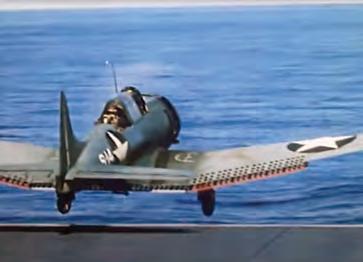

Out at sea, American aircraft struck a devastating blow at the Japanese fleet. Top: Douglas SBD-3 Dauntless dive bombers prepare to attack. Center: The Japanese carrier Hiryu¯ avoids American bombs. Bottom: Midway survived the attack, but not without damage.
thought, because they hoped to capture the island and use it later. They did bomb alongside it, and they focused a lot of attention on an airplane the Americans had left out in the open as a decoy. From what Ford saw, the enemy wasted a lot of effort to destroy it. “[T]hey lost about three planes trying to get to that fake plane, as it came into a cone of fire that was pretty dangerous,” he said.
One incident that angered Ford happened as he peered through his binoculars and saw a Zero attack and kill a Marine who had bailed out of his airplane. “This kid jumped and this Zero went after him and shot him out of his harness,” he said, and then the Japanese pilot returned to strafe the water where the Marine had come down.

Ford told his debriefers how impressed he had been by the Marines around him. “They were kids, oh, I would say from 18 to 22, none of them were older. They were the calmest people I have ever seen. They were up there popping away with rifles, having a swell time and none of them were alarmed.” He added, “I was really amazed. I thought that some kids, one or two would get scared, but no, they were having the time of their lives.”
But not all of them had escaped with their lives. Forty-nine of the atoll’s Marine defenders had been killed. Their aircraft—F4F Wildcats and obsolete F2A Brewster Buffaloes— were outmatched by the Japanese Zeros, and attacks flown from Midway against the Japanese vessels proved inconsequential at best and resulted in the loss of more aircraft.
The attack on the atoll lasted only about 20 minutes. The Japanese did not return to follow it up with an invasion because they ran into difficulties out to sea. Yamamoto had accomplished his goal of drawing the Pacific Fleet into battle, but the results were not what the Japanese had desired. American carrierbased dive bombers pounced on the Japanese ships and sank four of its aircraft carriers— and one reason the American airplanes found the enemy ships at a disadvantage is because the carriers had to recover, refuel, and rearm the aircraft that had returned from the attack on the island. Although the U.S. lost the car-
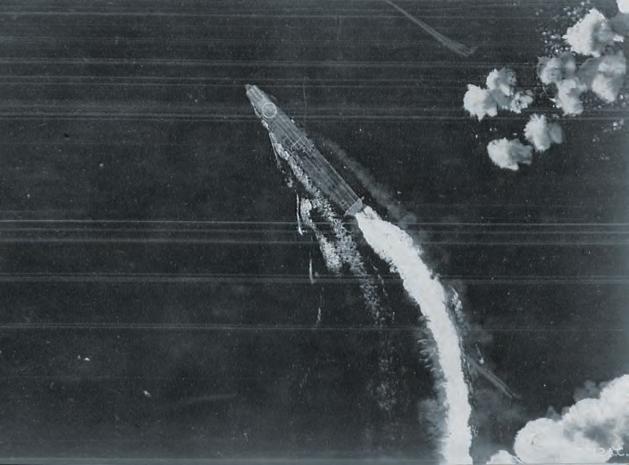

“This kid jumped and this Zero went after him and shot him out of his harness,” Ford said.
rier Yorktown, the Battle of Midway at sea proved to be a disaster for Japan and a turning point in the Pacific war.
FORD RETURNED to the United States with the raw footage from his small portion of the fight as well as footage shot by another of his cameramen, Lieutenant Kenneth M. Pier, who had been aboard the carrier Hornet at sea. He began shaping the footage into a short film with the assistance of some Hollywood friends— Henry Fonda and Jane Darwell from The Grapes of Wrath provided voices, Donald Crisp from How Green Was My Valley added narration, and Alfred Newman, who oversaw music for Twentieth Century-Fox, wrote the score. Ford insisted that his editors include a brief shot of Major James Roosevelt, the president’s son, in the final cut. If he did that to curry favor with Roosevelt, it worked. After screening the 18-minute short at the White House, the president told his chief of staff, “I want every mother in American to see this film.” The Battle of Midway began appearing in theaters, as a short before the main feature, in September. Critic James Agee called it “a brave attempt to make a record—quick, jerky, vivid, fragmentary, luminous—of a moment of desperate peril to the nation.”
“Even now, far removed from Midway and the war, The Battle of Midway resonates,” wrote Ford biographer Scott Eyman. “It remains one of Ford’s great achievements.”
Ford had a bumpier experience with another film from his unit. Cinematographer Gregg Toland had taken the lead in putting together a documentary about the Pearl Harbor attack, but the military men who previewed the work gave it scathing notices. They objected to the way the filmmakers had recreated events for their cameras, the film’s virulent portrayal of the Japanese, and the way it left the “distinct impression that the Navy was not on the job,” in the words of Admiral Harold Stark. Ford had it recut from 85 minutes to 34, and the Academy of Motion Picture Arts and Sciences voted December 7th best short documentary at the 1944 Oscars.
FORD CONTINUED HIS WORK for the navy. He ventured into harm’s way again in late 1942 when he oversaw shooting in North Africa. One person he encountered there was Darryl F. Zanuck, the production chief of Twentieth Century-Fox, for whom Ford had made The Grapes of Wrath and How Green Was My Valley. Zanuck had received a commission in the Signal Corps and was working on his own documentary. “Can’t I ever get away from you?” Ford grumbled to him. “I’ll bet a dollar to a doughnut that if I ever go to Heaven, you’ll be waiting at the door for me under a sign reading, ‘Produced by Darryl F. Zanuck.’”
Ford later went to Asia to film activity in Burma and China, and in June 1944 he supervised filming of the D-Day landings, activity marred when he went on an epic three-day bender in mid-June. Once he sobered up, Ford spent time aboard a PT boat commanded by John D. Bulkeley, who had rescued Douglas MacArthur from Corregidor in March 1942 and was the centerpiece of William Lindsay White’s book They Were Expendable, an account of PT boat crews in the Philippines.
After Ford returned to the states he resumed directing Hollywood movies. Here he waits between shots on They Were Expendable, which was released on December 31, 1945.
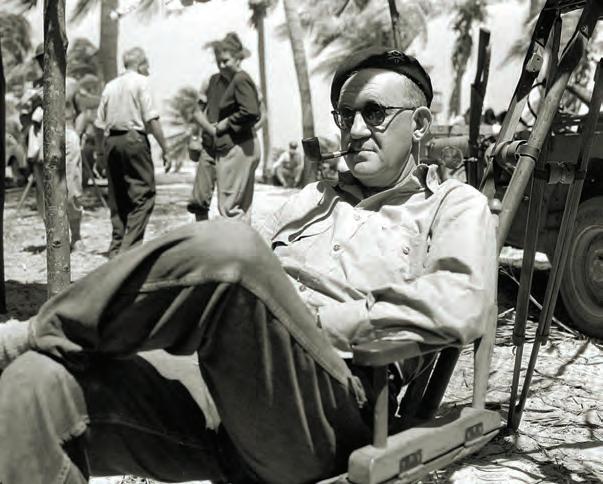
(See “Battle Films,” page 76.) When Ford returned to the United States to start work on the film version of White’s book, his time in the war zones were over.
After the war, Ford continued his film career, directing a series of classic Westerns with John Wayne. (Ford enjoyed needling Wayne over his lack of service in the military.) Those films included Fort Apache (1948), She Wore a Yellow Ribbon (1949), and The Searchers (1956). The director is now considered one of the great artists of Hollywood’s Golden Age. When filmmaker Orson Welles, no slouch behind the camera himself, was asked who his three favorite directors were, he answered “John Ford, John Ford, John Ford.”
For the rest of his days, until he died in 1973, Ford remained proud of his navy service and was “shameless” in his pursuit of official medals and ribbons. Befitting a man who had a character in one of his movies say, “When the legend becomes fact, print the legend,” Ford often burnished the legend of his experiences at Midway and elsewhere. In truth, he had no need to embellish. H
Tom Huntington is the editor of World War II and Aviation History magazines. He has written several books, including Maine at 200: An Anecdotal History Celebrating Two Centuries of Statehood , from which this article has been adapted.
The German vessel Komet lay dead in the water, immobilized by Arctic ice. Captain Robert Eyssen watched from the wheelhouse as a large Soviet icebreaker crunched through the icepack toward him. The steel-reinforced bow of the 11,000-ton icebreaker Stalin c ould crush the Komet ’s hull like an eggshell.
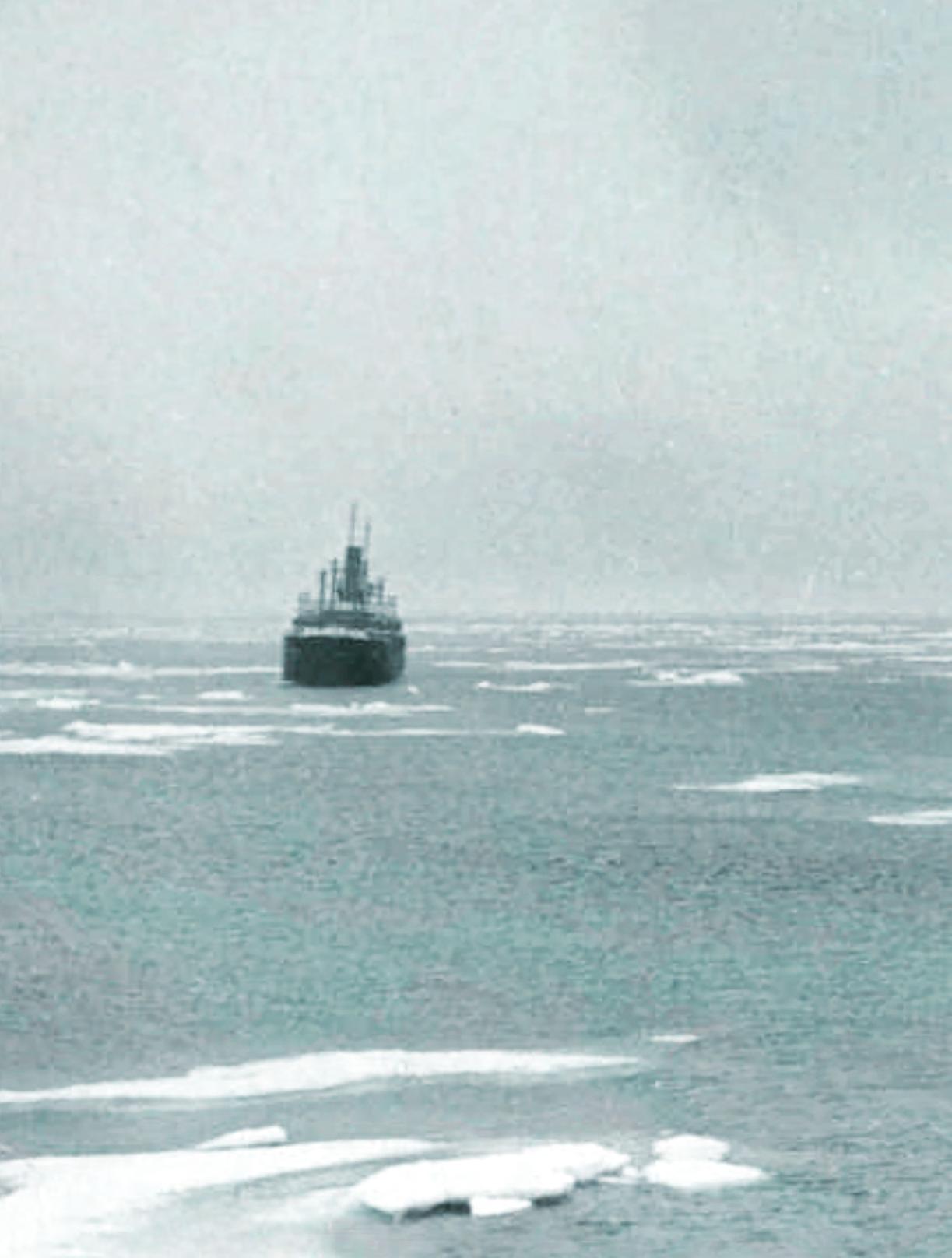
It was August 1940. The Nazi blitzkrieg was storming through western Europe, where the German Wehrmacht seemed unstoppable. But the war at sea was a different matter. Although German U-boats ravaged the Atlantic, the British Navy kept Germany’s few major surface warships mostly bottled up in their ports. Komet aimed to thwart the Royal Navy’s blockade and strike at vital sea lanes that sustained Britain’s war effort.
The ship w as no defenseless merchantman. In 1939, the German Navy commandeered the 7,500-ton passenger-cargo ship E ms and transformed it into an auxiliary cruiser, renamed K MS (Kriegsmarine Schiff ) Komet. It was to be a commerce raider, designed to attack enemy vessels while disguised as a merchant ship sailing under a neutral false flag. Hinged steel deck plates concealed the ship’s main armament, six
5.9-inch guns. Captain Eyssen, however, did not lower the concealing deck plates and train Komet ’s g uns on the approaching icebreaker…because it was secretly an accomplice. Stalin was coming to free his vessel and clear a path through the ice so the German warship could transit the Russian Northern Passage, skirting the Arctic Circle and avoiding the Royal Navy, to emerge in the Pacific to plunder British and Allied shipping,
KOMET ’S MISSION was an unlikely offshoot of the German-Soviet Nonaggression Pact—a cynical deal between Hitler and Stalin that triggered the outbreak of World War II. The pact, which stunned the diplomatic world on August 23, 1939, was much more than a pledge of mutual nonaggression. Secret clauses and side agreements amounted to a temporary
The Soviet icebreaker Stalin plies the northern waters for which it was designed. Thanks to an often overlooked part of a pact between the Soviets and Germany, Stalin played a role in getting a German raider to the South Pacific.
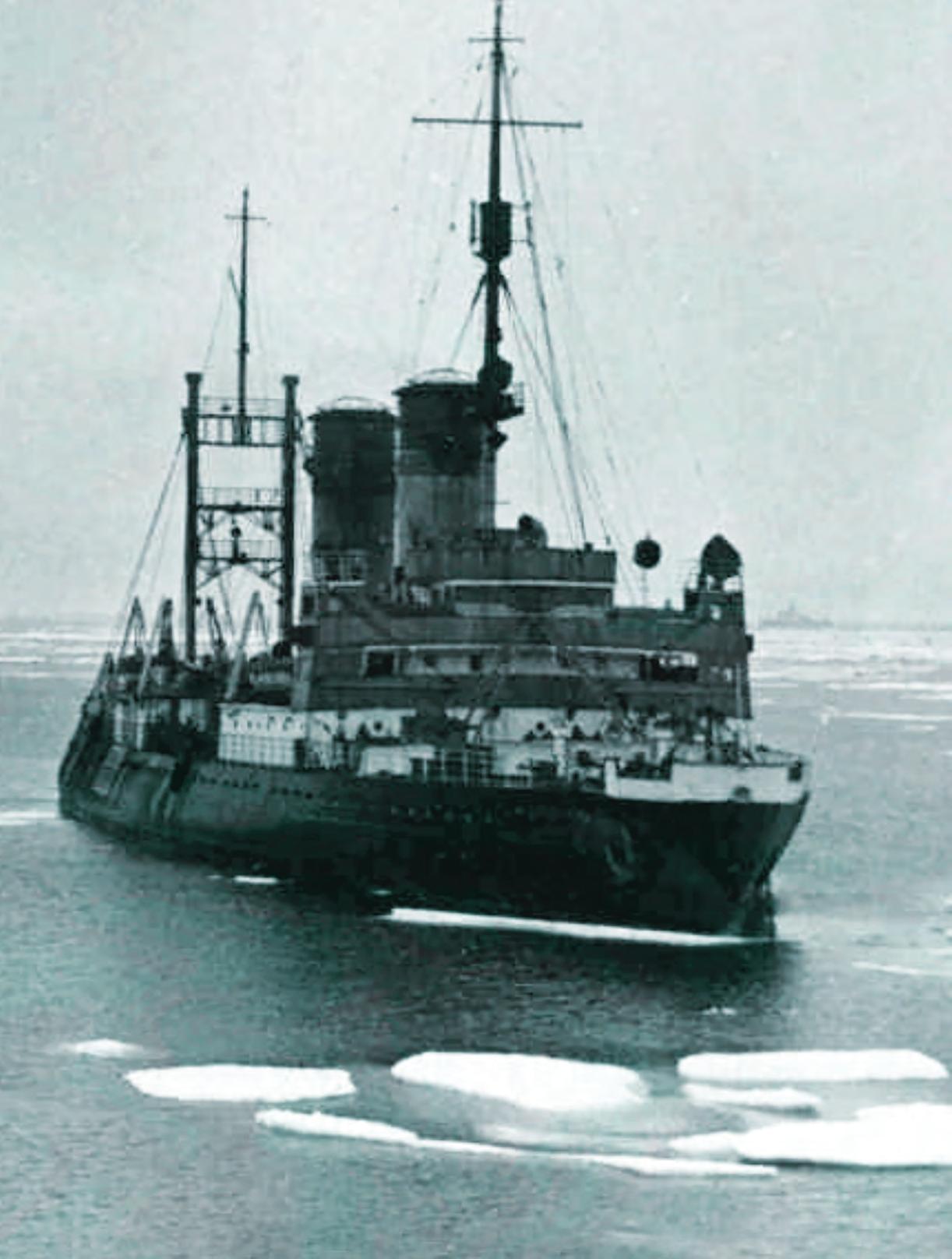
limited partnership between the Nazi and Soviet dictators. At the outset, each got most of what he wanted.
For Hitler, the pact was a green light to invade Poland, now that he could be confident that the Soviets would not join Britain and France in the war against Germany. In a follow-on trade agreement, Moscow promised to supply Germany with vital raw materials, especially oil and grain—a hedge against a possible British naval blockade of Germany. The quid pro quo for Soviet raw materials was the promise of German military technology, particularly naval technology.
Stalin had grandiose plans for building a blue-water navy with enormous warships. In May 1936 he approved a naval construction program that featured an astounding 24 battleships and 20 heavy cruisers. The Sovetsky Soyuz- class battleships were to be 30 percent larger than the massive German battleship Bismarck . Construction had started on four of them before the plan was scuttled after the Germans invaded in June 1941. But it is estimated that Stalin’s battleship program consumed about one third of the defense budget in 1940.
In October 1939, while Berlin tried to get Moscow to agree to deliver the promised raw materials, Soviet officials arrived in Berlin with lists of German equipment they wanted. The Russians presented a 48-page list of requests, half of which were naval and included an entire heavy cruiser and destroyer, blueprints for the Bismarck, naval heavy guns, mines, torpedoes, and enormous amounts of construction equipment and precision machinery for shipbuilding. Not surprisingly, the Germans balked at the “voluminous and unreasonable” Soviet demands.
Eventually, Moscow began shipping large amounts of oil, grain, rubber, and other goods to Germany, although never in the quantity Berlin demanded. The Germans understood that in order to keep the Soviet supplies flowing, they would have to make good on some of their promises. At the top of the Soviet wish list was a heavy cruiser. Berlin decided to hand over the not-yet-completed cruiser Lützow, the newest
of the Admiral Hipper -class. These were formidable warships, displacing more than 16,000 tons and mounting eight 8-inch guns in four turrets. The saga of the Lützow illustrates the promise—and the frustrations—of German-Soviet naval cooperation.
The Lützow was fitting out in a shipyard in Bremen in February 1940 when the transfer agreement was concluded. None of the 8-inch guns and only two turrets had been installed. Lützow eventually received four of the big guns in the fore and aft turrets. German tugs towed the ship through coastal waters and handed it over to Soviet tugs that towed the vessel the rest of the way to Leningrad. The Soviets renamed the cruiser Petropavlovsk.
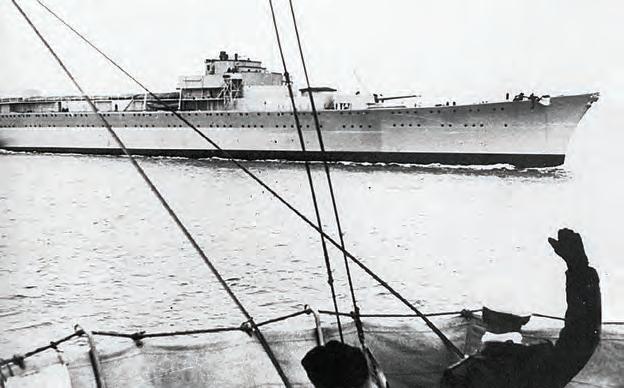
The ship was still incomplete when it arrived. Besides missing half the main and all the secondary armament (twelve 5.9-inch guns), it had only a skeleton bridge, almost no superstructure above the first deck, and incomplete propulsion and mechanical elements. Over the next 12 months Germany was obliged to provide all these materials, plus detailed operating manuals and training for Soviet officers and crew. Even with the best of intentions on both sides, preparing the ship for sea was a daunting task and the project proceeded slowly.
The Soviets were eager in principle to get on with it, despite misgivings about sending enlisted men to Germany or allowing numerous German officers in Leningrad. But unknown to them, in December 1940 Hitler approved Operation Barbarossa, the invasion of the Soviet Union. From then on, German authorities went through the motions of preparing the training and completing the ship’s fitting out but dragged their feet at every turn.
In other areas, however, the prospects for naval cooperation seemed more promising. As early as October 1939, Moscow signaled its willingness to provide a harbor for German naval operations in northwest Russia in exchange for military technology. German Naval Warfare Command ( Seekriegsleitung, or SKL) leaped at the possibility, since a base on the northwest Soviet coast would let German submarines and surface warships bypass the North Sea choke points patrolled by the Royal Navy. On October 17, the Soviets offered Zapadnaya Litsa, a remote harbor northwest of Murmansk in the Motovsky Gulf, the westernmost point of the Kola Peninsula.
For Hitler, the pact with the Soviets was a green light to invade Poland.
This harbor afforded good security as it was closed to both foreign and Soviet domestic shipping and its entrance could not be observed from the open sea. The German naval attaché in Moscow enthusiastically filled in SKL on the Soviet offer: “In this bay, Germany may do whatever she wishes; she may carry out whatever projects she should consider necessary. Any type of vessel may be permitted to call there (heavy cruisers, submarines, supply ships)…during any season of the year.” Despite some disadvantages—the harbor was totally undeveloped and isolated, with no naval facilities at all and no rail or road connections to the interior—SKL quickly accepted the offer and gave Zapadnaya Litsa the sensible code name Basis Nord (North Base).
Basis Nord was to have three principal missions: as a logistics base for German warships, a safe harbor, and a repair base. Admiral Karl Dönitz, head of Germany’s submarine fleet, was especially interested, even though he anticipated being able to operate only one U-boat there at a time. Any possibility of Germany fortifying the base was out of the
The German warship the Soviets came to name Petropavlovsk underwent drastic changes between its original design (top) and its final configuration. Ironically, when the ship did get a chance to use its guns in anger, it was against invading German forces.


question. Security for Basis Nord would be entirely in the hands of the Soviet Navy. Before making the base operational, Dönitz sent two submarines to evaluate the proposed base and the state of Soviet preparedness. This mission began inauspiciously, as the British submarine Salmon torpedoed and sank U-36 in the Norwegian Sea. Its sister ship, U-38 , fared better. Its captain made a clandestine reconnaissance and reported that
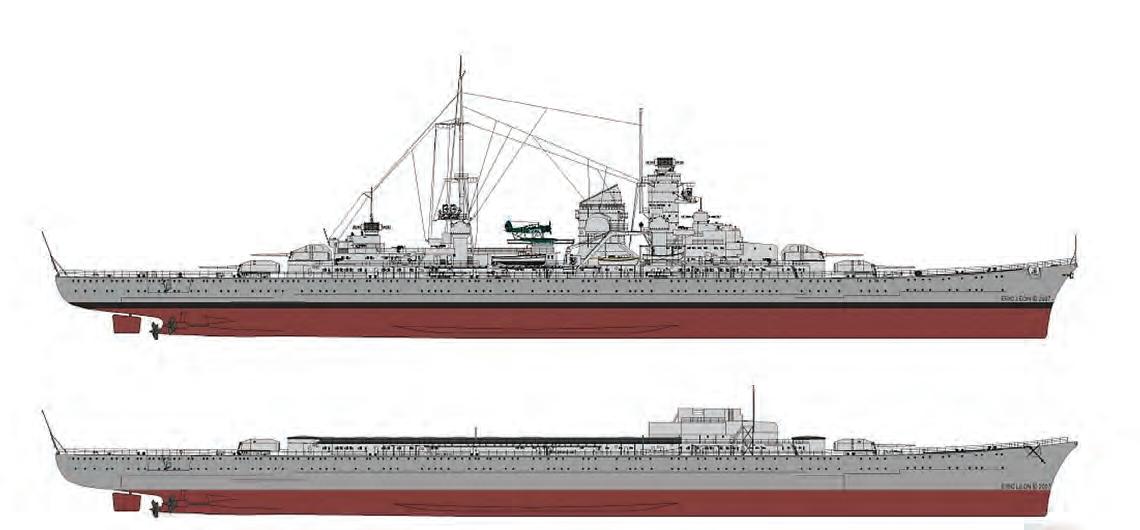
Soviet security and anti-submarine measures were excellent—so good, in fact, that he dared not attempt to follow a Soviet steamer through the anti-submarine nets in Kola Bay, a common tactic for German submariners.
SKL ordered several German merchant ships then trapped in Murmansk by the British blockade to proceed to Basis Nord, stocked with supplies to service German surface warships and submarines. Operationally, however, little was accomplished. Not only was the winter of 1940 exceptionally harsh, which hampered all naval activity in that northern region, but the Kriegsmarine was also stretched thin and had few vessels to spare for that theater, and Germany’s successes in Norway in April 1940 and a few months later in France provided the Kriegsmarine with bases that made Basis Nord totally unnecessary. Berlin ordered the base closed in August 1940.

BUT JUST AS THE BOOK on Basis Nord was closing, a new chapter on naval cooperation between the not-quite allies was opening. In August 1940, the German auxiliary cruiser Komet was making its way through Russia’s ice-choked Northern Passage.
Komet began its journey, with Soviet permission, by steaming up the Norwegian coast disguised as a Soviet vessel. In early August, it took on two Soviet pilots to navigate the Arctic ice. The Soviet icebreaker Lenin guided Komet through several western Arctic Ocean passages. Using Soviet navigation and ice charts, Captain Eyssen and the pilots steered the ship through the Kara Sea and into the East Siberian Sea, where Komet encountered very thick ice that damaged and temporarily immobilized it That’s where the icebreaker Stalin came to the rescue and led Komet far enough eastward that Eyssen, after disembarking the pilots, was able to complete the last few hundred miles of the voyage on his own. On September 6, Komet passed through the narrow Bering Strait separating Siberia
From top: Komet was originally a passenger and cargo ship named Ems; It had hinged steel plates to conceal 5.9-inch guns; The auxilary cruiser Orion joined Komet on the raid, bearing a false name that translated to Not Suitable for the Tropics; Kulmerland served as the raiders’ supply ship.


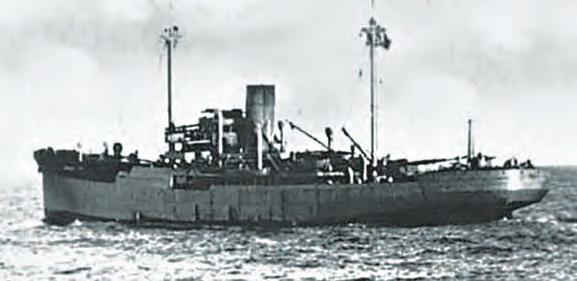
Bering Strait Sept. 6, 1940
Basis Nord Hamburg, Germany Nov. 1941
Gdynia, Poland July 1940
Nauru
Kommata Triadic Triaster Triona Vinni Sunk Dec. 6–7, 1940
Rangitane Sunk Nov. 27, 1940
from Alaska, and into the North Pacific. Eyssen had traversed the northern sea route in 23 days, the fastest crossing of the Northern Passage ever, up to that time.
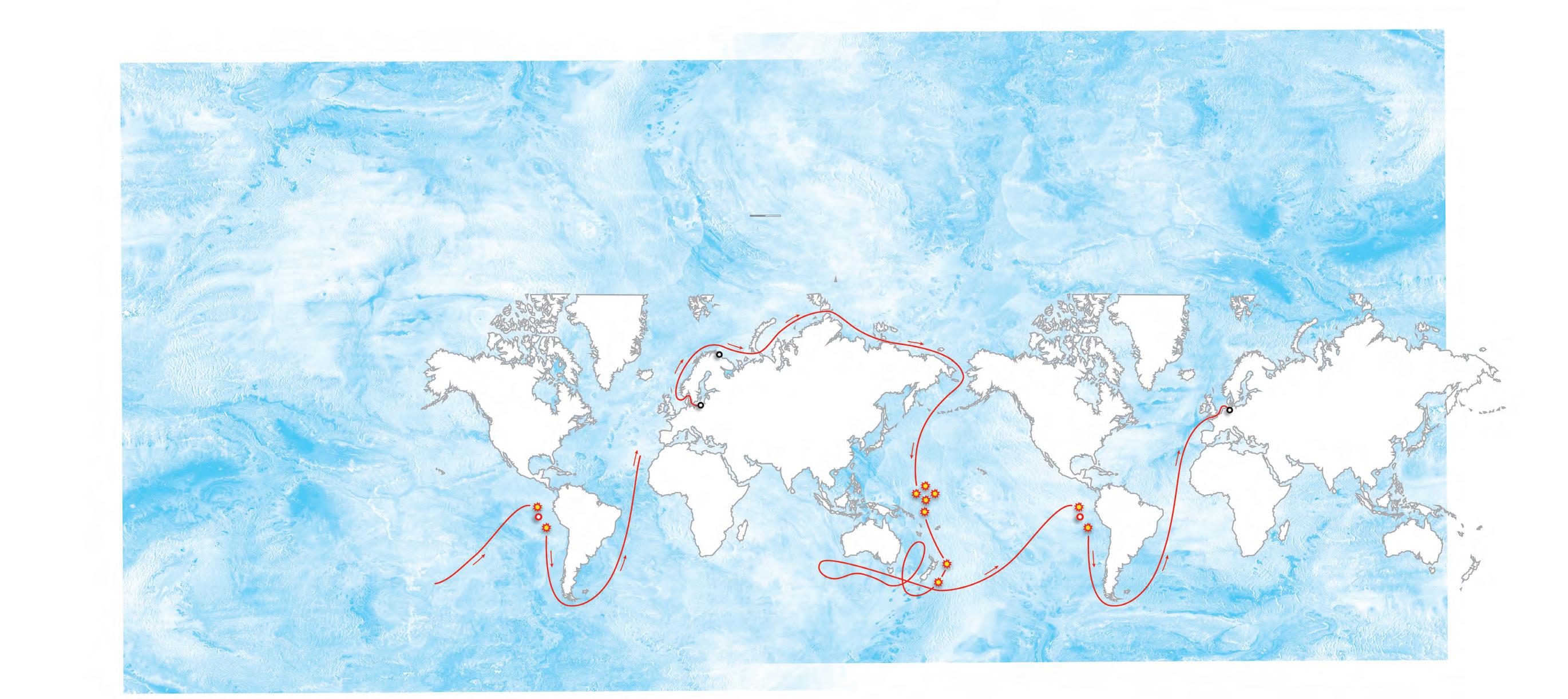
Eyssen’s instructions were to hunt for enemy merchantmen in the southern waters of the Pacific and Indian Oceans, to lay mines in the approaches to Australian, New Zealand, and South African ports, and to seek out the Antarctic whaling fleets. SKL’s objectives were to disrupt enemy, especially British, shipping, and by so doing, tie down British naval forces in remote areas, relieving some of the Royal Navy’s pressure on German home waters.
After refueling and topping off its supplies in Japan, Komet headed south. It reached the Caroline Islands without sighting a single enemy vessel. There, Eyssen rendezvoused with the auxiliary cruiser Orion and the unarmed freighter Kulmerland, a supply ship for the two raiders. All three took on the false identities of Japanese ships. Eyssen had the name Manyo Maru painted on Komet ’s stern and likenesses of the Rising Sun flag emblazoned on the ship’s sides. No one on the Orion knew how to write its false identity in Japanese characters, so they copied some words from Japanese packaging found onboard and painted them on the ship’s side. Any observer who could read Japanese would have been surprised to find the ship operating under the unusual name Not Suitable for the Tropics
Eyssen, the senior officer among the three captains, took his “Far Eastern Squadron” southeastward, cruising the sea lanes between New Zealand and Panama. On November 25, he found his first victim, the small New Zealand coaster Holmwood, which Komet sank with gunfire after first conveying its passengers and crew safely to Kulmerland and carrying off as many of the coaster’s cargo of sheep
Kota Nopan Captured Aug. 17, 1941
Australind Sunk Aug. 14, 1941 Devon Sunk Aug. 19, 1941
Holmwood Sunk Nov. 25, 1940
Cape Horn Oct. 14, 1941
Komet’s epic voyage commenced at the Baltic port of Gdynia in July 1940. By the time it ended in Hamburg in November 1941, the ship had sailed more than 87,000 miles and had circumnavigated the globe. Along the way Komet and its crew cut a swathe through Allied shipping in the South Pacific. After refitting in Germany, Komet returned to the sea in October 1942, only to meet its fate at the hands of British warships that were lying in wait.
as the raiders could conveniently carry. At first the Germans were delighted with the fresh meat, but eventually they came to detest the taste of mutton.
Two days later, Komet and Orion caught a really big fish, the 16,700-ton New Zealand passenger liner Rangitane, bound from Auckland to Liverpool via the Panama Canal with 302 passengers and crew and large quantities of dairy and frozen meat as well as 45 bars of silver. The ship was relatively well-armed, with a 127mm and 75mm gun astern and several anti-aircraft guns on the bridge. It was also faster than the German ships. But the raiders hemmed Rangitane in before the crew knew they were enemy warships. After suffering a short, deadly crossfire at close range, the captain surrendered—but not before sending out an emergency radio signal that he was being attacked by German raiders. Captain Eyssen wanted a prize crew to sail the liner to Germany, not least because it would have been the largest prize ship ever taken by a German raider. But the distress signal Rangitane managed to send out had been picked up and re-transmitted to Australian and New Zealand naval units. Radio intercepts revealed that enemy warships and aircraft
were on the way. The Germans hurriedly brought the passengers and crew aboard, sent the liner and its valuable cargo to the bottom, and fled northeast at top speed toward the island of Nauru. Two long-range New Zealand flying boats reached the scene later that day but found only floating debris.
Nauru lies roughly mid-way between Australia and Hawaii and is composed mainly of phosphate rock, a key ingredient in fertilizer. A joint British-Australian-New Zealand operation mined and exported that valuable commodity and Eyssen guessed correctly that he would find good hunting there. On December 6-7, Komet and Orion sank five freighters, four British and one Norwegian, in Nauru’s harbor and nearby waters. Several of the victims tried to flee, but a few well-aimed salvos compelled surrender, not without some loss of life on the freighters. Aside from that, all crew and passengers were brought on board the German vessels before their ships were destroyed. The captains of two of the British vessels thanked Eyssen in writing for “the
way we have been treated on board your ship as prisoners. Everything possible has been done for us in the circumstances and…everything was done for the sick and wounded.” As a coup de grâce, after warning the civilians ashore of his intentions, Komet shelled the phosphate loading facilities on Nauru, putting them out of operation for months. Nauru did not resume full production until after the war.
The Nauru operation was the most successful and economically consequential action of Komet ’s war cruise. In recognition, SKL promoted Eyssen to Konteradmiral (rear admiral). His new orders were to head south in hopes of catching the Anglo-Norwegian whaling fleet near Antarctica, and then to proceed into the Indian Ocean. Komet sailed alone, as Orion was slower even when not plagued with engine trouble, as it often was. Finding no sign of the whalers, Komet proceeded north again in March 1941 to patrol the waters between Australia and Africa. However, due to the high level of raider activity in the Indian Ocean, merchant shipping increasingly traveled in convoys under British naval escort. The following months were unproductive and frustrating for Komet . During this lull, Eyssen received the electrifying news that the Wehrmacht had invaded the Soviet Union in June. There would be no more transits of the Northern Passage for him—at least not until Russia was completely subdued.
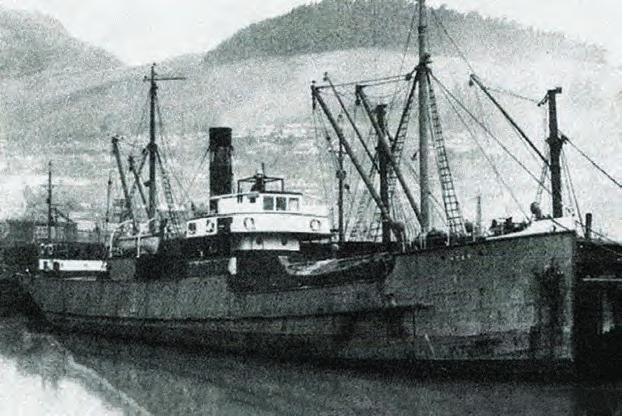
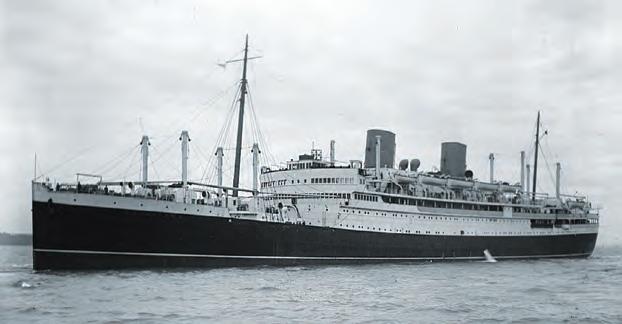

SKL instructed Eyssen to return to Germany by October so Komet could be re-fit for its next war cruise. The new admiral was determined to score a few more victories on his way home and he was not disappointed. Near the Galapagos Islands on August 14, Komet ’s crew sighted the first enemy ship they had seen in seven and a half months. Still disguised as a Japanese vessel, the raider drew close before Eyssen had the Kriegsmarine ensign and his admiral’s pennant run up and he fired two warning shots. The 5,000ton British freighter Australind, en route to England by way of the Panama Canal, refused to stop and its crew manned the 4-inch gun on the stern. At a range of only 3,000 yards, Komet rapidly put seven salvos into the British ship, severely damaging the bridge and killing the captain and another officer. The wounded ship stopped and lowered its boats. Eyssen brought the survivors aboard and, finding the cargo uninteresting, scuttled the ship.
Three days later, Komet intercepted the
7,300-ton Dutch freighter Kota Nopan, bound for New York. It was in good condition and carried a very valuable cargo of rubber, tin, and manganese. Eyssen put a prize crew aboard and, after a rendezvous with a supply ship to refuel Komet and his prize, he sent Kota Nopan toward home. It reached Bordeaux in November. Just two days after subduing Kota Nopan, another victim steamed into Komet ’s view: the 9,000-ton British freighter Devon, bound for New Zealand with a “miscellaneous” cargo. Neither the ship nor its cargo was deemed worth saving, so after taking the crew aboard, Komet sunk the freighter with gunfire.
Komet rounded Cape Horn on October 14 and set a course for the French coast, taking on the identity of a neutral Portuguese freighter. It rendezvoused with two U-boats in mid-November and the submarines saw the raider safely into the Bay of Biscay. Komet anchored briefly at Cherbourg and Le Havre before making the dangerous dash up the English Channel, escorted by German torpedo boats and minesweepers. British torpedo boats and bombers attacked; a bomb caused minor damage but no casualties. Spending a day in Dunkirk, Komet continued up the coast of Holland and, at 6:00 p.m. on November 30, 1941, tied up at Hamburg. Komet had been at sea for 516 days, sailed over 87,000 miles, crossed the equator eight times, sank seven ships and sent one home as a prize, and wrecked the phosphate operations at Nauru. It had been an epic voyage.
Komet laid up for almost a year for a complete re-fit that included overhauling the engines and receiving new guns and upgraded communications gear in preparation for a second war cruise. This time there would be no Northern Passage; Komet would have to get past the Royal Navy to reach the Atlantic. Admiral Eyssen was ashore in Norway as chief of the Oslo Naval Depot. Komet was now commanded by Captain Ulrich Brocksien, who took the raider out of friendly waters on October 7, 1942, and docked in Dunkirk that night. On October 12, Brocksien made his break for the open sea, escorted by four torpedo boats. But the Royal Navy, forewarned perhaps by an Enigma radio decrypt, was ready and had two British battle groups, composed of eight destroyers and eight torpedo boats, waiting.
An RAF patrol plane spotted Komet around
midnight and dropped flares. The British ships attacked. In the melee that followed, Komet was hit and set afire. The flames spread rapidly and minutes later a massive explosion sent a fireball hundreds of feet into the night sky and literally blew the ship apart. Komet sank immediately, taking all 251 officers and men with it. In afteraction reports, the British attributed Komet ’s destruction to one or two torpedo hits. German torpedo boat officers saw no torpedo wakes near Komet and believed gunfire from the destroyers must have scored a direct hit on one of the ammunition magazines.
While Komet was dying, Petropavlovsk, the former German heavy cruiser Lützow, lived on. When the Wehrmacht stormed into the Soviet Union on June 22, 1941, Petropavlovsk was not seaworthy but could serve as a deadly floating artillery battery. Tied up at the coal wharves in Leningrad harbor in early September, the cruiser poured some 700 rounds from its 8-inch guns into German forces closing in on the city. German troops attested to the fearsome impact of those shells. On September 17, German heavy artillery scored multiple hits on the ship, which sank bow first. Soviet salvage crews managed to raise it sufficiently to get its guns back in action a year later. The Soviets renamed the ship Tallinn in September 1944 when an old Tsaristera battleship received the name Petropavlovsk . Tallinn hit the Germans again during the breakout from Leningrad’s encirclement in 1944. The fighting soon passed beyond the range of its guns, which finally fell silent.
After the war, the Soviets used the battlescarred hulk as a floating barracks until it was broken up for scrap in the 1950s. That ended the last physical remnant of wartime German-Soviet naval cooperation. H
Historian Stuart D. Goldman is the author of Nomonhan, 1939: The Red Army’s Victory That Shaped World War II
After his time commanding Komet, Robert Eyssen was promoted to rear admiral. Below: His story was recounted in Der Landser Ritterkreuzträger, a pulp magazine that was sometimes accused of whitewashing German war stories.
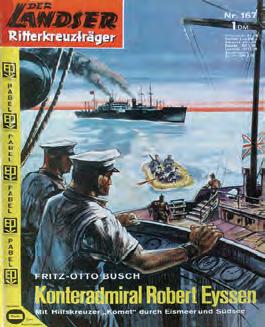

IT WASN’T LONG after the advent of flying war machines before militaries developed weapons to shoot them down. Germany experimented with anti-aircraft guns in World War I and, despite postVersailles restrictions that ostensibly limited German war industry, in the 1930s they designed the Flak 18, an accurate, highmuzzle-velocity, 88mm anti-aircraft gun. It proved its worth during the Spanish Civil War and became one of the best known and most feared weapons of World War II.
A s an anti-aircraft weapon the Flak was lethally effective. The

After firing, the Flak ejected its spent shells from the rear of a sliding breechblock before automatically recocking. This allowed a speedy firing rate of up to 20 rounds per minute.
gun’s high velocity and rapid firing rate allowed synchronized German batteries of four to accurately hurl massive 17-pound shells thousands of feet into the air, where they would explode into 1,500 fragments or more, leaving tell-tale black puffs of smoke. Any aircraft within 200 yards were at risk from the scything shards of metal. Tens of thousands of Allied airplanes fell victim to
The rear handwheel adjusted the gun’s elevation. There were two speeds, one for rapid movement and a slower one for precision aiming. At the higher speed, a crewman could raise the gun to a nearly vertical 85-degree elevation with 42.5 wheel rotations.
The Flak’s barrel liner wore out after only about 900 rounds, making on-field replacements necessary. The Wehrmacht experimented with various two- and three-piece liner styles over the war years to facilitate the process.
A crewman controlled the gun’s horizontal traverse via the two-speed front handwheel. At the high-speed setting, the gun could make a full 360-degree sweep to shoot in any direction with 100 turns of the wheel.
At the foot of each metal outrigger were leveling jacks, which screwed up or down to help the 16,000-pound gun maintain a level firing platform on uneven terrain.
The Flak often bore a defensive metal shield when the gun was used an anti-tank weapon. Here German crews attend a Flak 18 in 1942 during the North African campaign.
88mm Flaks during the course of the war. While the Wehrmacht initially thought the gun too large and heavy to serve in the field, its effectiveness in Spain made them revise their tactics. The improved Flak 36, introduced in 1939, had the flexibility to shoot at low angles, and its variety of both high-explosive and armor-piercing shells were effective against Allied tanks and fortified positions from more than 1.5 miles. The gun was eventually adapted for use on tanks, but the Germans deployed the majority of the Flaks in its original anti-aircraft role for home defense. —Larry Porges


GERMAN 88MM FLAK 36
Crew: 10 / Length: 20 ft. / Weight: 16,330 lbs. / Caliber: 88mm / Elevation: -3° to +85° / Rate of fire: 15-20 rpm / Max. firing range: 32,500 ft. / Germany had about 3,000 88mm Flaks available at the start of World War II, eventually producing more than 20,000 guns.

AMERICAN 90MM M1

Crew: 8 / Length: 29.5 ft. / Weight: 19,000 lbs. / Caliber: 90mm / Elevation: -10° to +90° / Rate of fire: 32 rpm / Max. firing range: 62,475 ft. / The U.S. Army modified the 90mm M1, its main anti-aircraft gun of the war, into the M2 to mount on M26 Pershing tanks and M36 tank destroyers.
ITALIAN CANNONE DA 90/53
Crew: 6 / Length: 16.5 ft. / Weight: 19,730 lb / Caliber: 90mm / Elevation: -2° to +85° / Rate of fire: 19 rpm / Max. firing range: 39,000 ft. / Derived from a naval gun, the Cannone de 90/53 served effectively in both anti-aircraft and field artillery roles for Italy until its 1943 surrender.


The Japanese attack on Pearl Harbor on December 7, 1941, and the United States’ subsequent entry into World War II affected every corner of American life. That included the Walt Disney Studios. On the day of the attack, army troops arrived at the Disney lot in Burbank, California, to set up an anti-aircraft battery.
Walt Disney and his staff pledged their support to the war effort, with the studio devoting over 90 percent of its wartime output to producing training, propaganda, entertainment, and public-service films, starting with a short for Lockheed titled Four Methods of Flush Riveting . Disney also produced publicity and print campaigns—almost all without profit. Even the animated members of Disney’s entourage supported the war effort, appearing in advertisements, stamp books, magazines, and government posters to promote war bond sales, food recycling, and more. (When government officials objected to Donald Duck appearing in a short for the Internal Revenue Bureau about the importance of paying taxes, Walt pointed out that getting the duck was equivalent to MGM loaning out Clark Gable.)
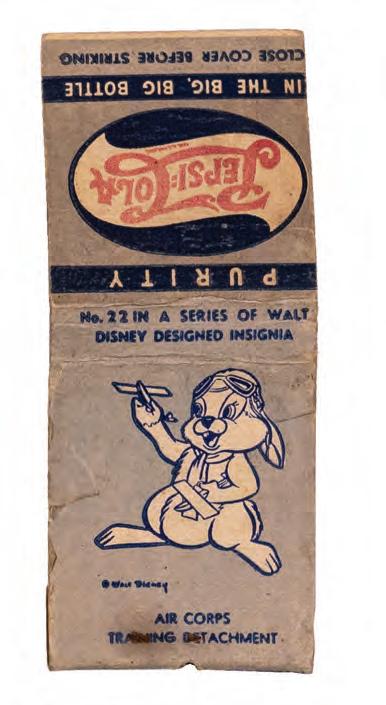

In March the National WWII Museum opened a special traveling exhibit, The Walt Disney Studios and World War II, which explores how the beloved entertainment company supported the war. Organized by the Walt Disney Family Museum in San Francisco, California, the exhibit features more than 500 rare historical artifacts and film clips and includes profiles of Disney employees who left the studio to join the armed forces.
Located in the heart of New Orleans, the National WWII Museum tells the story of the American experience in the war that changed the world— why it was fought, how it was won, and what it means today—so that future generations will know the price of freedom and be inspired by what they learn. The Walt Disney Studios and World War II will be at the museum through September 24, 2023. H
Opposite: Donald Duck and Goofy are up to their usual antics in Disney-created artwork for Cochran Army Airfield in Macon, Georgia. Above: These matchbooks sport unit insignia created by Disney. Studio artists designed more than 1,200 such insignia during the war.


EA Disney artist Henry “Hank” Porter contributed this illustration for a Masquers Servicemen’s Morale Corps program. The Masquers Club in Hollywood hosted the events to honor American servicemen and women. B Walt Disney personally oversaw production of an adaptation of Alexander de Seversky’s best-selling Victory Through Air Power, for which this dramatic eagle was created. C For a title card that appeared before a 1942 Disney production, Donald Duck replaced his traditional sailor’s cap with army headgear. D A story sketch depicts a preliminary scene for the 1942 short The Vanishing Private. E Not even Donald Duck appreciated KP duty, as this Disney-designed apron reveals.
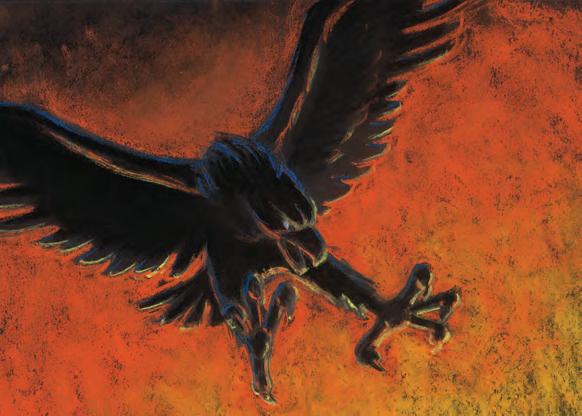


GF Mickey Mouse reminded Americans to remain alert in the wake of the Pearl Harbor attack. G Dumbo the elephant remained alert, too, in an insignia orginally created for the 2nd Reconnaissance Squadron in Fresno, California. Released on October 31, 1941, Dumbo was slated to be the cover story for Time magazine on December 8, but news about Pearl Harbor took its place. H Another Disneydesigned insignia decorates the leather jacket of aviator R.C. Lehnert of Marine Fighting Squadron 422, also known as the “Flying Buccaneers.”
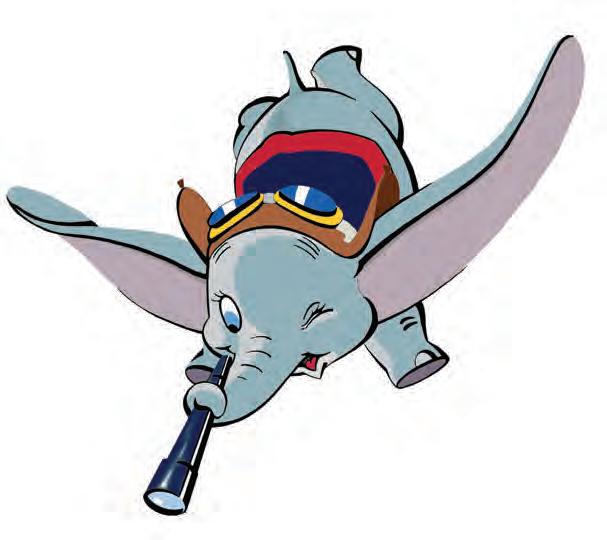


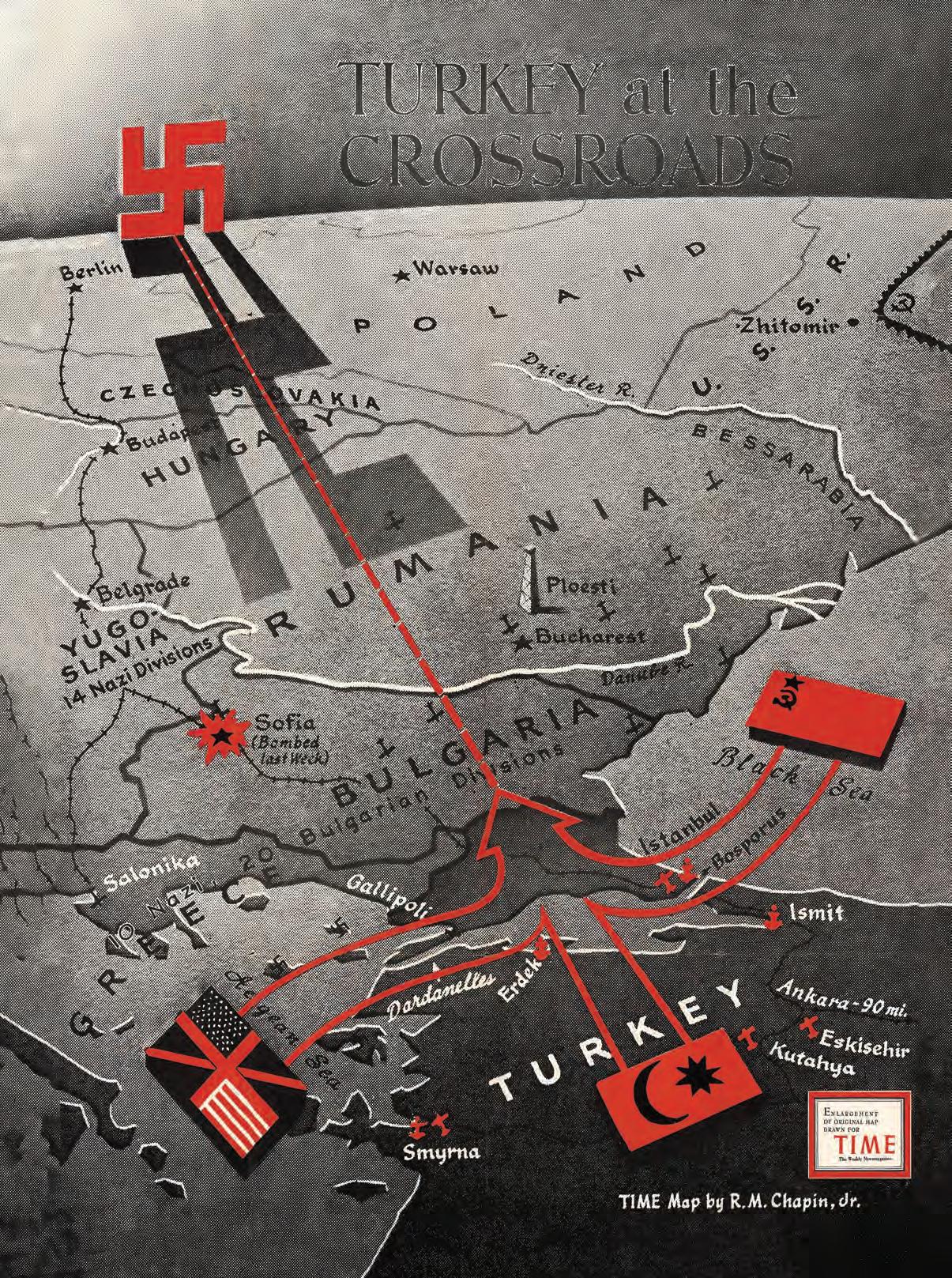
It wasn’t until February 23, 1945, that the Turkish Grand National Assembly voted—unanimously—to declare war on Germany and Japan. This was only six weeks after Turkey severed links with Japan, six months since ending diplomatic relations with longtime trading partner Germany, and less than three months before the German surrender. The declaration of war was mostly a formality to join the postwar United Nations—Turkey would remain a non-belligerent—but it was still an unexpected act from a country that for years had stubbornly refused to be drawn into choosing a side in the war. In the words of one Turkish minister, Turkey “was determined to maintain her neutrality to the end.” While the rights of neutrals were rarely respected by the warring countries, Turkey had dug in its heels.
Opposite: A 1943 Time magazine illustration depicts Turkey’s wartime dilemma, when belligerents encircled the nation.
It was a fine and dangerous line on which Turkey balanced. The country was terrified by the threat of Luftwaffe bombers in occupied Greece, which could level Turkish cities overnight. But Turkey feared a victorious Soviet Union even more than a victorious Germany, as the Soviets had been eyeing Turkish ports and waterways for years. This animosity was nothing new: beginning in 1568 Turkey and Russia had fought 17 wars, the majority of which resulted in Russian victories. As Ottavio De Peppo, the Italian ambassador to
Turkey during the war, phrased it, “the Turkish idea is that the last German soldier should fall upon the last Russian corpse.”
Beginning in 1939, war had consumed the region around Turkey, the nation that served as the literal bridge between Europe and Asia. Along with Nazi-occupied Greece directly to the west, the Germans also controlled the former Ottoman Balkan territories of Bulgaria, Bosnia, and Serbia to the northwest. Turkey’s southern neighbors, the British and French colonial empires occupying Syria, Iraq, and Lebanon, had quickly been drafted into battle for the Allies and, after 1941, Turkey’s longtime enemy, the Soviet Union, joined the fight against Germany—meaning Turkey had become encircled by belligerents. Yet Turkey, with crucial shipping routes connecting the Black Sea to the Mediterranean and possessing the major land passage to the oil-rich Caucasus, maintained its neutrality and independence throughout nearly all of World War II. This was not evidence of indecision or cowardice, but rather a sign of a carefully tended strategy—one created, as Turkey saw it, out of pure necessity. And one that allowed it to preserve its economy as well as avoid the physical ravages of battle.
NEUTRALITY HAD BEEN a cornerstone of the Republic of Turkey since it had been created in 1923 by founding father and president Mustafa Kemal Atatürk, the soldier-turnedleader-turned-national hero. Atatürk had
built his country from the ashes of the Ottoman Empire, the 600-year Islamic imperial realm that had once ruled much of the Middle East, but which in its last decades had been reduced to a puppet state for more powerful European nations. After the Ottoman defeat in World War I, Atatürk’s forces fought off the French and British as well as Turkey’s millennium-old enemies of Greece and Armenia in the 1919-1923 Turkish War of Independence. Atatürk’s subsequent reforms transformed Turkey into a secular, modern nation, putting the new country on the path to peace and prosperity. Atatürk believed the young republic needed to look inward to develop fully, coining the phrase “Peace at home, peace in the world” to explain the new isolationist policies he advanced. But this position had become increasingly untenable as fascist governments began forming across Europe, inching ever closer to Turkey’s borders.
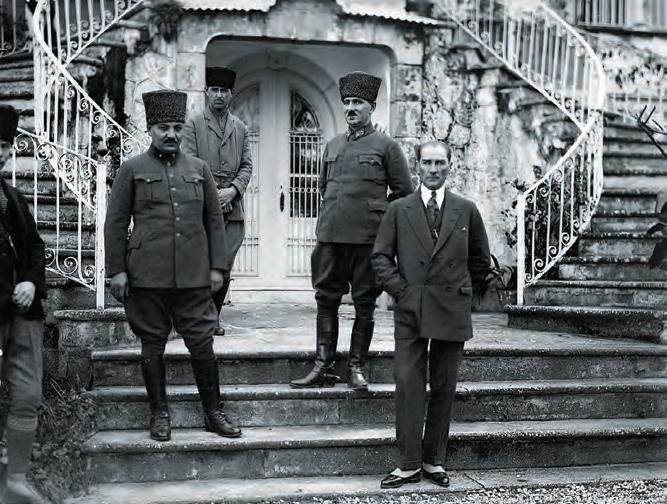
Atatürk died of cirrhosis of the liver on the morning of November 10, 1938, only hours after Nazis had shattered the windows of Jewish businesses and synagogues across Germany and Austria on Kristallnacht. The two stories dominated the evening editions of newspapers around the world. Atatürk’s successor, the unassuming İsmet İnönü, had been the equivalent of a colonel during World War I, fighting on the Caucasus and Palestinian fronts, where he became Atatürk’s confidante. He later rose to the equivalent of brigadier general during the Turkish War of Independence, winning two major battles against the Greeks and serving as commander at the final Turkish victory in 1922.
Slim and shy in contrast to the charismatic and forceful Atatürk, 54-year-old İnönü was committed to continuing Atatürk’s policy of international neutrality, even once World War II began. İnönü believed neutrality was about more than just preserving economic and political relations with the Axis and the Allies; he saw it as a matter of survival for his young country, necessary to avoid takeover by its larger and more established neighbors like Italy, Germany, or—worst of all—the Soviet Union.
İnönü’s view was part of a larger cultural stance, explains Murat Önsoy, a professor in
Turkey’s president and founding father Mustafa Atatürk (right) believed that isolationism was the best path forward to help his nation fully develop into a modern society.
Turkey's isolationist policies became increasing untenable as fascist powers inched ever closer to its borders.
War Studies and German Studies at Turkey’s Hacettepe University: “Turkish elites came from a generation that had witnessed the destruction of the Ottoman Empire…. They had seen how the Balkans had faded away out of their hands and how Turkey had been slighted in World War I, and they witnessed how hard the Republic was achieved.”
Even though the country had signed the Tripartite Alliance treaty in October 1939 with France and Britain, a 15-year agreement of collaboration in the interests of national security, İnönü officially declared Turkey’s non-belligerence on June 26, 1940. This was a tough blow for the British. Prime Minister Winston Churchill complained that Turkey was “shirking her responsibilities.”

While the British would still have access to Turkey’s strategic shipping ports, they were more interested in seeing Germany lose such rights, knowing the loss would hit Germany harder, since after its defeat in World War I it had no colonies and few trading partners. Churchill also wanted a base in the area from which to launch his desired Mediterranean attacks on what he called Europe’s “soft underbelly.” But as the war advanced, the Allies believed that, if they were patient, Turkey would join their side soon enough. The British ambassador to Turkey, Sir Hughe Knatchbull-Hugessen, recommended “keeping the pot boiling”—meaning that Allied leaders should continue their pressure campaign on the Turks.
In late September 1939, the German ambassador to Turkey, Franz von Papen, had stated that “in no circumstances did Germany intend to start a war in the Mediterranean.” But rival Italy entered the war in June 1940, and Germany had completed its takeover of both Greece and the Balkans by 1941. Hitler immediately sent an official letter to İnönü confirming German respect of Turkish neutrality, declaring that he did not start the war, that he was not “intending to attack Turkey,” and that he had “ordered troops in Bulgaria to stay far from the Turkish border in order not to make out a false impression of their presence.”
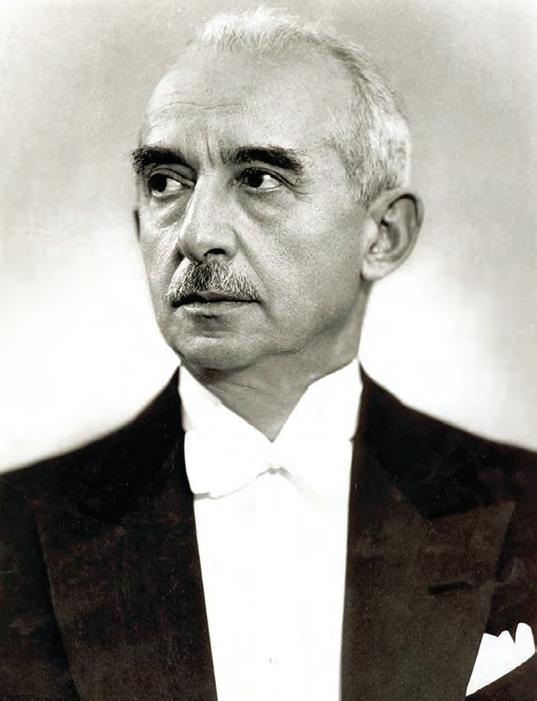
TURKEY INITIALLY LOOKED the other way as both Germany and Britain infringed its neutrality. The Turkish government chose a very loose interpretation of its agreement at the 1936 Montreux Convention, which confirmed Turkey’s control over the Turkish Straits—the Bosphorus and Dardanelles waterways—but also required the country to prohibit the passage of belligerent naval ships in any conflict in which Turkey was neutral. Yet Allied and Axis warships were regular presences in both during the war.
There were many reasons why Germany didn’t simply invade Turkey. Even though several foreign diplomats estimated that it would only take them 48 hours to conquer Istanbul, Turkey’s largest city, the ghost of Gallipoli—when Ottoman forces had fought off the bettersupplied British, Australian, and New Zealand militaries for eight months in World War I—still haunted the memories of the European powers, and the Germans kept their distance. In addition, Turkey was larger than all European countries except the Soviet Union, with a difficult terrain and a sizeable—though unmodernized and undersupplied—standing military, making quick and easy victory anything but certain.
But Germany's primary reason for hesitating to invade Turkey was economic. Throughout the 1930s, more than half of Turkey’s trade was with Nazi Germany. German banks had also taken advantage of the high prices in the Turkish precious metals market to sell their looted gold. Deutsche Bank ledgers
recovered by the Allies after the war showed that more than 2,200 pounds of gold stolen from German's Holocaust victims had been sold to Turkey.
İnönü understood early that none of the Allies could replace Germany as a primary trading partner. Britain, France, and the United States had their own sources for the country’s cotton and tobacco, in contrast to the Germans, whose lack of colonies limited their access to such products. In return, Germany remained the most ardent supporter of Turkish neutrality since a neutral Turkey was a guarantee of a ready supply of raw materials.
The most important raw material that Turkey supplied was chromium. This was manufactured into chrome, an essential material for making stainless steel since it provides resistance to rust, and was used to make gun barrels, tanks, aircraft engines, ball bearings, shells, and submarine parts. In 1939, Turkish chrome output was about 200,000 tons per year, about a fifth of the


Germany’s war machine depended on high-quality Turkish chromium ore, a vital component in the stainless steel in tanks, shells, airplanes, and other armament. Germany needed Turkey to remain neutral in order to maintain a steady supply of the metal.
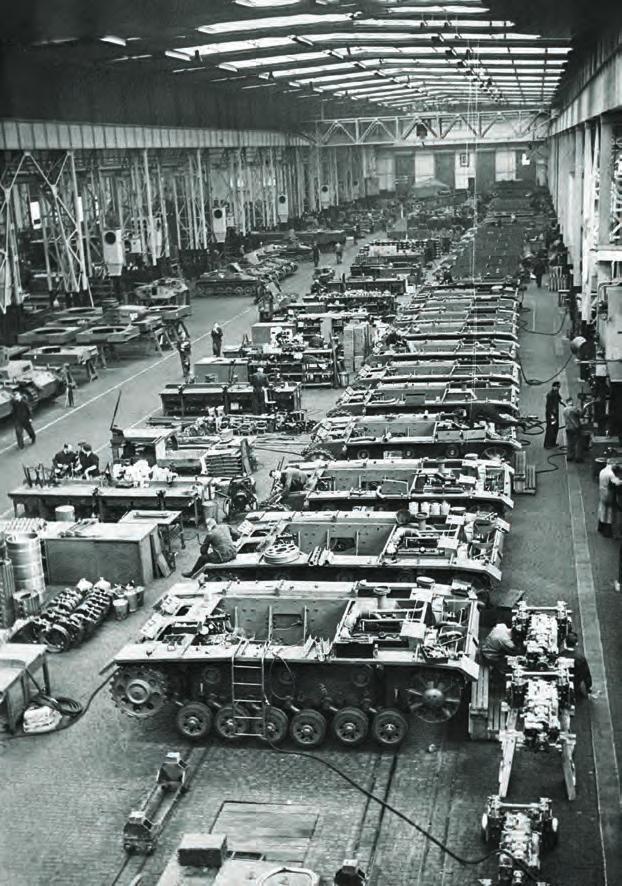
world’s total, of which Germany bought half. This was the only non-Allied source of quality chrome. There were some mines in Greece and the Balkans, but the deposits didn’t have the more preferred chromium-to-iron ratio of Turkish chrome.
The British were keeping a close eye on all this. British ambassador to Turkey Knatchbull-Hugessen sent a report in 1941 to the Ministry of Economic Warfare noting that “Chrome ore is very high on the list of commodities which were believed to be of critical importance to Germany.” He estimated that “stocks are believed to be equivalent to about seven months’ supply.”
He hadn’t exaggerated. Albert Speer, Germany’s Minister of Armaments and War Pro -
Germany openly threatened to bomb Turkish cities if the country joined the Allies.
duction, wrote in a memorandum to Hitler on November 10, 1943, that “should supplies from Turkey be cut off, the stockpile of chromium is sufficient for only five to six months…almost the entire gamut of artillery would have to cease from one to three months after this deadline.” Germany also understood that if it invaded Turkey, the Turks would quickly destroy the mines, as the Greeks had done in their country.
Fully aware of this dynamic, the Allies remained less concerned about Turkey’s declared neutrality than with its material boost to the German war machine. But İnönü was elusive with the Allies when pressured on the topic and sidestepped both British and American proposals to cease exports to Germany, though Turkish diplomats promised that they were employing various subterfuge to delay shipments.
The British kept up diplomatic pressure, but Turkey became more and more distant as Germany consolidated its power around the Mediterranean. Turkey and Germany signed a 10-year mutual non-aggression pact on June 18, 1941, just four days before Hitler launched Operation Barbarossa against the Soviet Union.
But, at the same time, as the full extent of the damage from France’s collapse the year before became apparent and alongside new threats to Britain’s Middle Eastern colonies, Turkey’s value to the Allies increased. And the country had plenty of concerns about the goals of the Axis Powers. While Turkey had a historically close relationship with Germany, the same could not be said for the Axis power of Italy. Mussolini’s cries of “mare nostrum,” or “our sea”—a term popular with Italian fascists to encourage domination of the Mediterranean Sea—combined with Italy’s construction of military bases on the Italian-controlled Dodecanese Islands only miles off Turkey’s southwest shore, had always made İnönü hesitant to join the Axis, as well as grateful for the British naval presence in the area. As the war completed its third year, it seemed Turkey’s resolve to remain a non-belligerent was finally beginning to waver.
IN LATE JANUARY 1943, Churchill and İnönü met in a Turkish railcar for the Adana Conference, where Churchill yet again tried and failed to convince İnönü to join the Allies.
The details of the 90-minute discussion weren’t recorded, but rumor has it that at one point an exasperated Churchill asked how the Turks couldn’t hear the German guns right over their border. İnönü reportedly informed Churchill that, since he had been a gunner in his earlier military days, he couldn’t hear very well.
Önsoy, the Turkish professor in War Studies, calls this İnönü’s “wait and see mentality.” This attitude led one of the participants at the Second Cairo Conference, attended by President Franklin D. Roosevelt, Churchill, and İnönü in December 1943, to remark that the Turkish delegation “wore hearing devices so perfectly tuned to one another that they all went out of order at the same instant whenever there were mentions of the possibility of Turkey entering the war.”
İnönü would remind his cabinet of the Turkish proverb, “There is always safety in patience.” By the end of 1943, though, İnönü’s patience was becoming a source of danger. The Germans openly threatened to bomb Turkish cities if the country abandoned its neutrality to join the Allies. German ambassador von Papen calculated that since the majority of Istanbul was composed of wooden structures, one air raid by the Bulgaria-based Luftwaffe could easily have the entire city up in flames.

Yet İnönü also knew that if he did not declare war against Germany, he would have no say in the postwar plans already being
Top: Winston Churchill took the Allied case directly to Inönü in a January 1943 meeting in Adana, Turkey. Inönü again balked at taking sides, frustrating the British prime minister. Above: The German ambassador to Turkey, Franz von Papen, tried to keep the Turks in line with threats of Luftwaffe air raids.
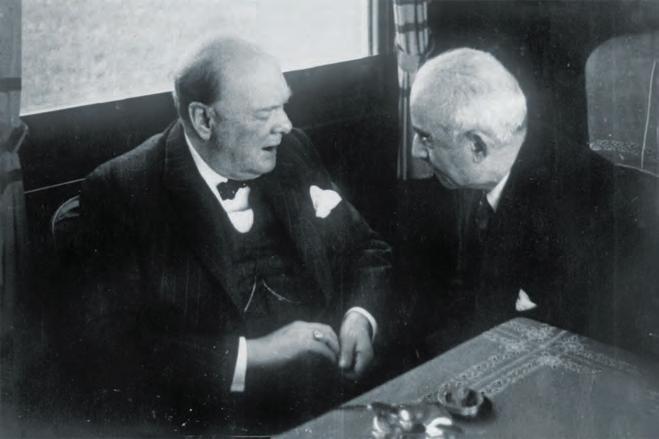
Left: While Turkey remained prepared for war, its stubborn neutrality until February 1945 kept the country out of the fight and its economy and cities intact. Bottom: Inönü (center) joined Churchill and President Franklin D. Roosevelt at the Second Cairo Conference in December 1943.
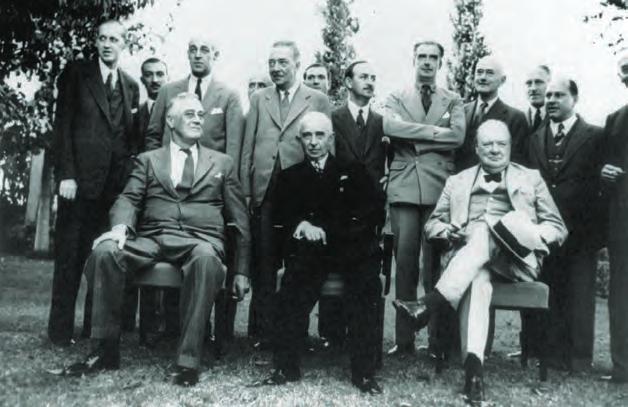
negotiated among the Allies. Relations with Britain had deteriorated as Britain tired of the Turkish delegation’s stalling tactics. Even the ever hopeful and tenacious Churchill wrote in his journal that he was "becoming resigned to Turkish neutrality.”
At dinner with Roosevelt and Stalin during the Tehran Conference in November 1943, Churchill suggested that a country as large as the Soviet Union “deserved access to warm water ports.” Joseph Stalin was less subtle, announcing, “We ought to take [Turkey] by the scruff of the neck if necessary.” Churchill had earlier warned İnönü that he would not stop the Soviets from taking control of the Dardanelles waterway if Turkey refused to join the Allies. Such statements confirmed Turkey’s worst fears about postwar realignments.
İnönü took note of Germany’s losses on nearly every front by that next spring, particularly at Stalingrad. In April 1944, Britain and the United States threatened Turkey with an embargo unless Turkey stopped sending strategic materials, most notably chrome, to Germany. Turkey ceased all shipments on April 21. Churchill told the British Parliament that Turkey had provided “good service” by halting chrome exports, despite what he characterized as the country’s “exaggerated attitude of caution.”
Turkey officially declared war in February 1945. Never as liberal-minded as his predecessor, İnönü used this as an excuse to crack down on dissidents and exert further control over the country’s media. The once commonplace pro-German editorials disappeared from the pages of all major Turkish newspapers.

The war declaration didn’t involve any active fighting on the part of Turkey or its large military and there were no casualties. However, the American ambassador to Turkey, Edwin C. Wilson, noted that the Turks “expect treatment identical to that which has been given to the other United Nations which have not been occupied by the enemy and they do not consider themselves in the same category as neutrals.”
Turkey’s strategic importance, once its greatest vulnerability, now became its
strength, as its location was integral to the emerging Western focus on containing the USSR. The Soviet threat came at the right time for Turkey, dissipating any Allied resentment over its previous neutrality. Roosevelt said he did not blame the Turkish leaders for not wanting to get caught “with their pants down.” Great Britain quickly forgot any grudge it might have held, as the two countries stood together against Soviet expansionism.
President Harry Truman announced in his Truman Doctrine in 1947 that any attack on Turkey would be an attack on the United States, and he signed an aid agreement with Turkey worth $150 million. Five years later, Turkey was made a full member state of NATO, the only Muslim-majority country to do so until Albania joined in 2009.
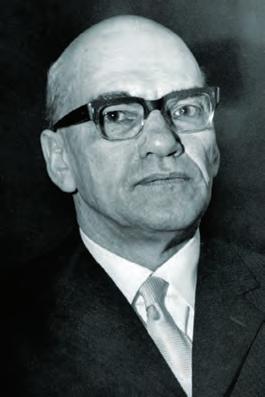
WHILE İNÖNÜ DOES NOT CARRY the mystique or fame of his predecessor Atatürk, his calculating negotiations ensured his country avoided seizure by the Soviets, either through invasion or as war reparations for having aligned themselves commercially with the losing Axis. And Turkey didn’t have to rebuild itself physically or economically like so many of its European neighbors in the aftermath of the war.
İnönü later defended his country’s initial adoption of neutrality by asking, “With what right could anyone expect us to do anything else at the time, when the Germans were at the gates of Istanbul, Britain feared invasion of the British Isles, Russia had a Non-Aggression Pact with Germany, and the United States was not in the war?”
The middle course—that Atatürk had originally envisioned and İnönü had maintained— allowed the country uninterrupted development and modernization while simultaneously preserving its independence. There hadn’t been peace in the world, but İnönü had managed some semblance of peace at home, achieving his stated goal to be “at the table but not on the menu.” H
Mac Carey is a freelance writer who lives in Virginia. Her work has appeared in Texas Monthly, Washingtonian, and Virginia Living magazines. Her time living in İzmir, Turkey, in the aughts left her with a lifelong interest in the country’s history and led her to learn more about the country’s experience as a non-belligerent during World War II.
TURKEY’S NEUTRALITY created a fertile ground for spying, especially with both Allied and Axis embassies in convenient proximity to each other in Ankara. Turning a blind eye to espionage was another concession the country made to preserve its neutral status.
The most infamous of Turkey’s wartime spies was Cicero, the pseudonym of Elyesa Bazna, a Turk of Albanian descent who spoke five languages fluently, including German. Bazna had worked as a servant for a German diplomat but was fired for reading his employer’s mail. After that it seems Bazna decided his skills would be better appreciated as a spy. He eventually found his way into the home of Britain’s ambassador to Turkey, Sir Hughe Knatchbull-Hugessen. It wasn’t long before Bazna picked the lock of his boss’s safe and began photographing its contents. In October 1943, Bazna took his photos to the German embassy and became a paid agent. Ambassador Franz von Papen himself gave Bazna the code name “Cicero,” because of his “astonishing eloquence.”
Over time, the Germans paid Bazna approximately eight million in present-day dollars. It was even rumored that Hitler intended to gift him a villa at the end of the war, after the German leader was shown some of Cicero’s photographs.
But Bazna may have been too efficient at his job. Many German officials doubted the legitimacy of the photos because of their quantity and quality. They should have looked closer. At least one of the documents mentioned the planned Operation Overlord (the code name for D-Day), but the information never made its way to the Nazi upper echelon and so was ignored.
The British embassy quickly realized that there was a spy in its midst and conducted an unsuccessful sting operation. Within a few months, Bazna left his employment and he had stopped selling information to the Germans by March 1944.
The Allies questioned Bazna after the war but never charged him with espionage. And the Germans got the last laugh: Bazna discovered that most of the currency they’d given him was counterfeit, remarking that the bills were “not worth even the price of the Turkish linen out of which they had been manufactured.”
The 1952 spy thriller 5 Fingers, starring James Mason and directed by Joseph L. Mankiewicz, was based on communications between Cicero and von Papen. Bazna inquired about becoming a technical adviser on the film, but the film execs politely declined. The former spy was living in Munich when he died of kidney disease at the age of 66 in 1970.

U.S. soldiers receive a warm reception as they enter Cebu City in the Philippines. Most Filipinos welcomed American troops as liberators.
WITH HIS NEW BOOK, historian John C. McManus has crafted an exhilarating conclusion to his trilogy about the American army’s role in winning World War II in the Pacific.
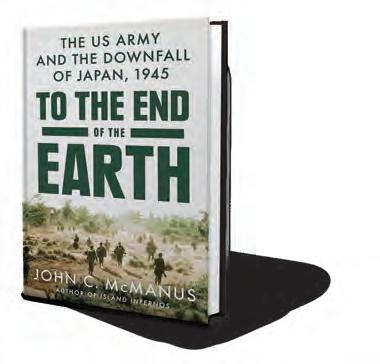
The first volume, Fire and Fortitude, traced the army’s role from 1941 through 1943, from the attack on Pearl Harbor through Guadalcanal and New Guinea. The sequel, Island Infernos , examined the 1944 battles for Saipan, Guam, and Peleliu. The concluding volume zeroes in on the dramatic final year of the war. McManus opens up with the American invasion of Lingayen Gulf in the Philippines, which was the front door for retaking Manila and the setting for the long sought-after homecoming of General Douglas MacArthur.
The 29-day fight for the Philippine capital would prove one of the most destructive urban battles of World War II, a slugfest that claimed an estimated 100,000 civilian lives, many of them massacred by the Japanese. American soldiers accustomed to battling in jungles and on beaches had to adapt to a blockby-block, house-by-house brawl to wrest back control of the former Pearl of the Orient.
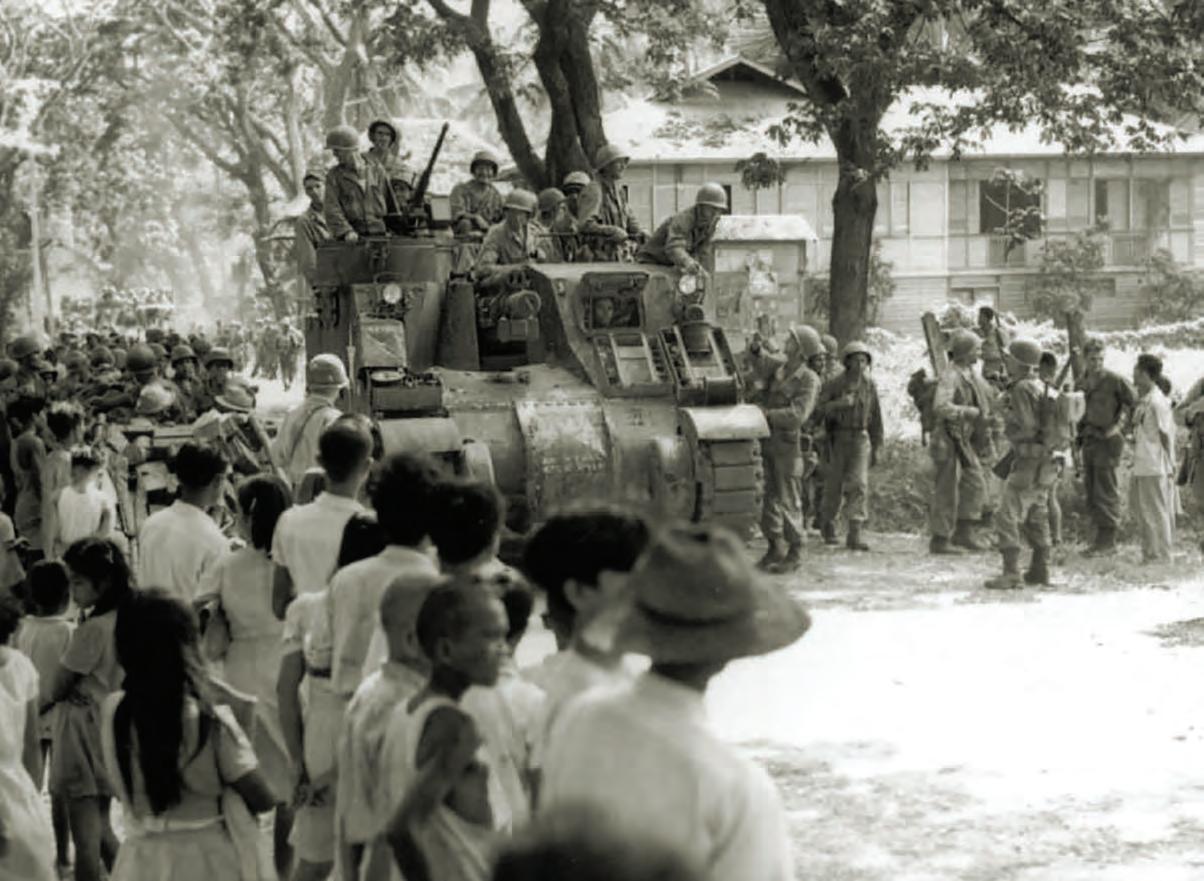
McManus marries his account of the Battle of Manila with the gripping tale of the retaking of Corregidor, a 1,735-acre fortified island that guarded the entrance to Manila Bay. The logistics of dropping thousands of airborne troops atop the island’s highpoint are fascinating, rivaled only by McManus’s marvelous

retelling of the hellacious conditions of the battle that left the entire island overwhelmed by the stench of death. From the Philippines, McManus takes readers through the equally gruesome fight for Okinawa, where casualties were so high that President Truman used the island as justification for dropping the atomic bombs that ultimately ended the war. McManus concludes with a detailed and beautiful account of the surrender ceremony aboard the battleship USS Missouri.
A professor at Missouri University of Science and Technology and the author of more than a dozen books, McManus is one of the best—if not the best—World War II historians working today. What sets his work apart is the depth of his research coupled with his extraordinary writing skills and his eye for details. For example, he recounts how MacArthur, a larger-than-life commander, was so overcome by nerves moments before the surrender ceremony that he retreated to the bathroom and was sick. McManus digs deep into primary source materials, from after-action reports to the individual letters and diaries penned by soldiers. The result is a kaleidoscopic view of the war, from the commanders back in headquarters down to the individual infantrymen huddled in foxholes. With this trilogy, McManus has done for the Pacific what Rick Atkinson did for Europe. —James M. Scott is a former Nieman Fellow at Harvard University and the author of Black Snow: Curtis LeMay, the Firebombing of Tokyo, and the Road to the Atomic Bomb and other books.
The author of To the End of the Earth talked to World War II about his book. Here’s an excerpt in which he discusses General of the Army Douglas MacArthur in 1945.
I definitely feel like I know MacArthur, although there’s always an element of enigma to him, something mysterious about him. He’s at turns infuriating and other times he’s kind of inspiring. In the end, and I think anyone who’s read the first two volumes won’t be surprised to hear me say this, I do find him to be a troubling figure on a lot of levels because of his egomania, his vaingloriousness. But by this point in the war, these are some of his finer moments, I will say. And what I mean by that is I think that the overall Philippines campaign is fairly well executed, at his level, at least. And you see something of his better angels once he gets to Japan at the end of the war, and the surrender ceremony and the initial occupation. In this volume you get a little bit more insight into the personal side of MacArthur, too, because his wife, Jean, joins him once Manila is taken. And his son, Arthur, and though I feel it was very inappropriate to have them in theater when no one else had their family, I do think that it does show you what a decent person he was at the family level. You do get some insights into him there. He’s just kind of endlessly fascinating, because it depends what day we’re talking about whether we’re angry at him, or whether we’re sort of inspired. This transcript has been edited for publication. To see the entire interview online, go to historynet.com/john-cmcmanus-interview.
THE AMERICANS AND BRITISH tend to think of World War II as an ideological struggle between democracy and dictatorship, but the largest, bloodiest, and bitterest ideological clash pitted Soviet Communism against German National Socialism, with the latter adding a racial element that was most notoriously embodied in the Schutzstaffel, or SS. While drafted Wehrmacht personnel swore, “I swear to God this holy oath, that I shall give my unconditional obedience to the Leader of the German Reich and people,” the SS volunteer’s oath went, “I swear to you, Adolf Hitler, as Führer and Chancellor of the German Reich, my loyalty and bravery.” In other words, Chris McNab notes in Waffen-SS Soldier Versus Soviet Rifleman, while the average German soldier fought for God and country, the SS man’s first loyalty was specifically to Hitler. As for the average Soviet rifleman, his primary loyalty was Za Rodinu (“for the Motherland”).
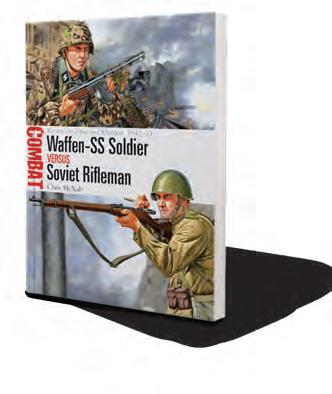
Rostov-on-Don and Kharkov 1942-43
by Chris McNab, 80 pp. Osprey Publishing, 2023. $23.
McNab’s latest entry in Osprey’s “Combat” series examines the two forces in transition, with attrition taking its toll on the intense training and legendary flexibility of the first generation of Waffen-SS, while the Red Army troops, some of whose units suffered 100 percent casualties, gradually evolved into soldiers who would ultimately have their reckoning with the Master Race in the streets of Berlin. The battles the book covers are lesser-known to the average Western World War II reader, but indicative of the weapons and tactics applied to urban warfare in Rostov-on-Don, July 20-25, 1942, and the Second, Third, and Fourth battles of Kharkov, a Ukrainian city that has again become a battleground.
—Jon Guttman
THE THREE ZEALOUSLY opportunistic individuals who provide Ian Buruma with his subjects were masters of mendacity. Felix Kersten (1898-1960) was an extraordinary masseur. His “magic hands” brought him into contact with Europe’s power elite: businessmen, aristocrats, and, in 1938, Heinrich Himmler, the Nazi SS leader and one of the masterminds behind the Holocaust. Kersten relieved Himmler’s excruciating stomach pains and the masseuse became part of the Reichsführer-SS ’s retinue. Kersten used his proximity to Himmler to save some individuals from death; but he also realized, when it became evident that Germany would lose to the Allies, that being Himmler’s masseur wouldn’t boost his postwar prospects. And so he crafted a second career: rewriting history to sanitize himself. The most stupefying example: he claimed to have saved the population of the Netherlands, Jews and non-Jews, from being deported to Poland.
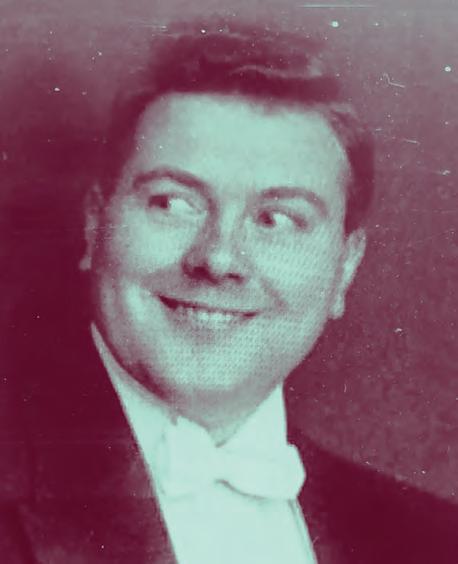
Friedrich Weinreb (1910-1988) was born in what is now Lviv in Ukraine and raised as a secular Jew. When World War I began, his
family moved to the Netherlands, where Friedrich embraced Orthodox Judaism. In 1941, after Nazi Germany imposed anti-Jewish measures in the occupied Netherlands, Weinreb offered Jews transit to neutral nations—for a hefty sum. It was a ruthlessly fraudulent confidence scheme; Weinreb had no intention of following through on his side of the deal. The SS arrested Weinreb because he was Jewish, but quickly released him—so he could find and betray Jews in hiding. A postwar Dutch study reported that “at least twenty-two people lost their lives because of Weinreb’s spying.”
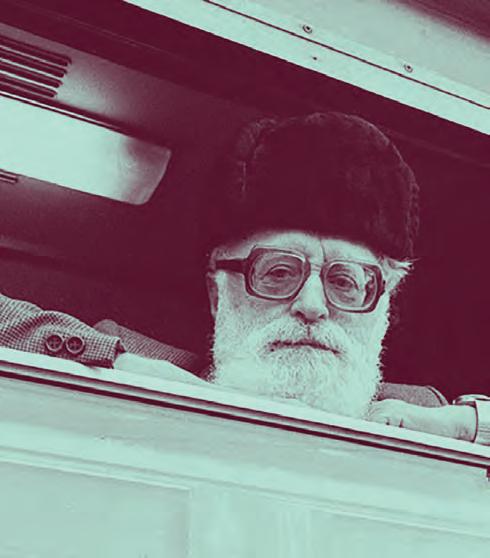
Kawashima Yoshiko (1907-1948) was the daughter of a Chinese Manchu prince who so admired Japan that he suggested that a Japanese “former samurai”—and reactionary— named Kawashima Naniwa adopt his daughter. Naniwa consented. In the 1930s Kawashima Yoshiko spied for the Japanese in China, which “earned her [a] sobriquet in Japanese military and media circles: the Mata Hari of the Orient.” Kawashima also referred to herself as the “Manchu Joan of Arc” after the Japanese propaganda machine fabricated a heroic role for her in Japan’s conquest of Manchuria. She was a great favorite of that machine, which probably backfired on her when, after the war, she was tried and exe -
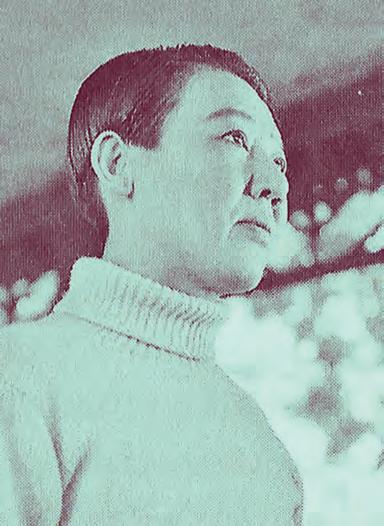
cuted (for collaboration) by the Chinese Nationalist authorities.
I wish Buruma had given Kersten, Weinreb, and Kawashima their own individual chapters, instead of weaving their louche biographies through each of the book’s chapters, because the format sometimes makes it difficult to follow the author as he steadfastly teases out facts from multitudes of tortuous lies. But ultimately, Buruma’s commonsensical acumen does justice to the injustices meted out or acquiesced in by his fascinating, disquieting protagonists. —Howard Schneider has reviewed books for a variety of HistoryNet publications.

COMPANY OF HEROES 3 Relic Entertainment/SEGA. $59.95. Microsoft Windows, Playstation 5, and Xbox series X/S.
THE BASICS The squad-based, real-time strategy (RTS) franchise is back after a 10-year wait. Company of Heroes 3 (COH3) transports players to the Mediterranean, where they can work their way through two single-player campaigns, or head straight to combat in multiplayer matches or skirmishes against the computer.

UNIT HISTORIES vary widely in quantity. Practically every infantry and cavalry regiment involved in the American Civil War has some account of its battle honors, as do a great number of fighter and bomber squadrons of World War II. Much less has been done on the motor torpedo boat squadrons, or MTB RONs, that operated patrol torpedo (PT) boats in coastal waters from the Mediterranean Sea to the South Pacific. After years of research, C.J. Skamarakas has assembled a detailed account of one such unit, MTB RON 25. From the squadron’s inception, the author moves on to describe organization and training in Melville, Rhode Island, staging at Taboga Island, south of the Panama Canal, and its first combat operations in March 1944 from Papua, New Guinea. From there the reader follows the RON as it accompanies General Douglas MacArthur’s “leap frogging” advance along the northern coast of New Guinea, Morotai, and the Philippines. Primarily engaged in disrupting Japanese troop and supply movements, RON 25 seldom had occasion to deploy its torpedoes but made generous use of its PT boats’ secondary armament of machine guns and cannons to shoot up barges and shore installations. Each chapter follows that advance from one base to another, adding up to an exemplary example for future MTB RON histories to follow. —Jon
GuttmanTHE OBJECTIVE The core gameplay happens at a tactical level. You recruit and command infantry, engineers, vehicles, artillery, and special forces to capture objectives and eliminate your enemy from the map. The narrative North African campaign, culminating in El Alamein, takes you through set pieces as an Afrika Korps commander; or you can play as U.S. and U.K. forces slogging it out for Italy in a much longer turn-based strategic campaign.
HISTORICAL ACCURACY COH3 is an action-based RTS with a romanticized World War II theme, not a faithful simulation. The battlefield aesthetics are convincing enough, but the history is superficial. (A companion website— history.companyofheroes.com— offers more robust historical context on the campaigns.) Perhaps most “accurate” of all is that the muddled game design of the Italian operation lets you taste the brutal tedium of the real thing.
THE GOOD, THE BAD, AND THE UGLY The tactical experience is very entertaining. The combat system is solid, the graphics are fluid and immersive, and the physics satisfying—especially when it comes to blowing up structures and cratering terrain. The factions are balanced and appreciably unique, with fun (if occasionally hokey) voice acting. On the other hand, the campaigns are dreary and the interstitial art/menu interfaces feel outdated. Plus, we could’ve done without the further mythologizing of Rommel.
PLAYABILITY Anyone used to RTSes will know the drill. The pace is forgiving enough for beginners, particularly with a new Tactical Pause feature that allows you to momentarily stop the action. Expect frustrations managing the turn-based campaign, though.
THE BOTTOM LINE If you want to play toy soldiers on the hills of Italy or the Libyan desert, COH3 offers a good time.
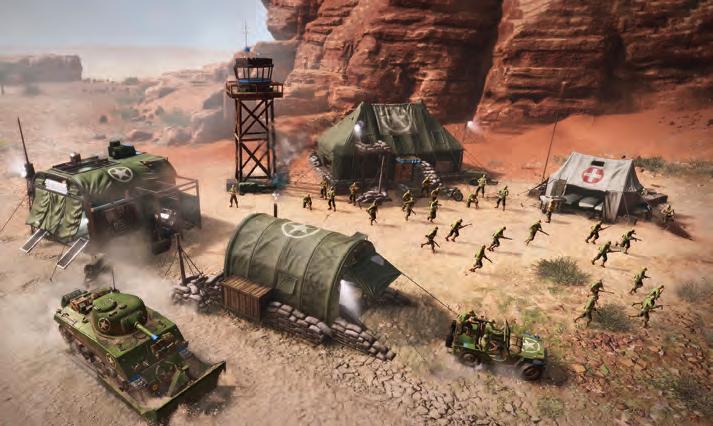
IN 1941 , the Soviet Union changed from a German ally to a German enemy. That summer, more than 160 German and Axis divisions invaded the Communist country as part of Operation Barbarossa, crushing the Red Army in its path.
surprisingly, propaganda played an important part in the Communist Party’s dissemination of news surrounding this bloody standoff. According to MacGregor’s research, the small cadre of soldiers reported to be fighting at Pavlov’s House were actually not alone. Hundreds of Red Army troops, many of whom will never be known because their bodies were lost in combat, circulated in and out of the battle site during its defense.
The Nazi war machine got all the way to the gates of Moscow and Leningrad before turning its attention to Stalingrad, where an epic struggle for survival took place as German and Soviet forces slaughtered each other in hand-to-hand combat for this city on the Volga River—the gateway to oilfields beyond the Caucasus Mountains.
The Lighthouse of Stalingrad provides a detailed accounting of Operation Barbarossa and the Battle of Stalingrad, citing sources from infantrymen on both sides. An unpublished manuscript by Wehrmacht colonel Friedrich Roske, who commanded an infantry division, offers a fascinating look at the futile German effort.

The
Truth at
Emblematic of that carnage was the Lighthouse, codename for Pavlov’s House—essentially the Soviets’ Alamo. Here in this building on 9th January Square, heroic Red Army defenders repulsed countless Wehrmacht assaults for 60 days as they held this vital foothold, helping turn the tide of battle and providing positive news for a nation on the brink of collapse.
Iain MacGregor’s book examines the myths surrounding Pavlov’s House, which received its name from Sergeant Yakov Pavlov, who led a squad at the fortified position. Perhaps not
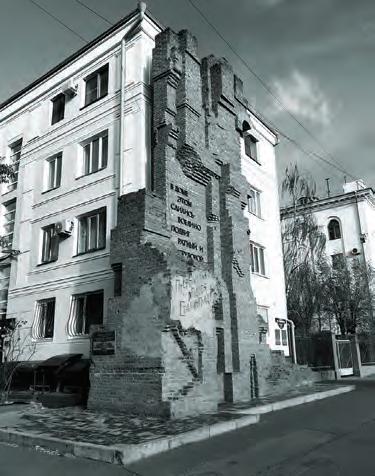
Sadly, the book falls flat on the legend of Pavlov’s House and the facts as they are now known. MacGregor writes at length about the leadup to and actual siege of Stalingrad but offers only sketchy coverage of the sergeant’s heroic defense of the city—legendary or otherwise. Still, The Lighthouse of Stalingrad is an engrossing read with a dramatic narrative of the costly battle that decided the outcome of World War II. I just wish there were more details on the titular fight at the center of it all. —Massachusetts-based Dave Kindy is a frequent contributor to HistoryNet publications as well as Smithsonian and the Washington Post.
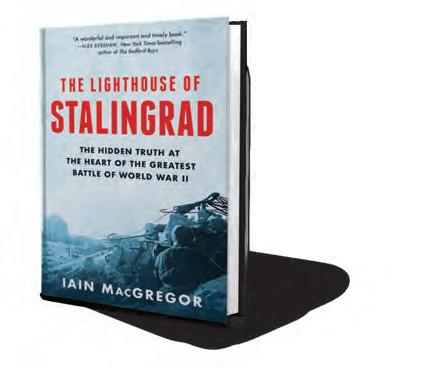

Where does hunting fit in the modern world? To many, it can seem outdated or even cruel, but as On Hunting affirms, hunting is holistic, honest, and continually relevant. Authors Lt. Col. Dave Grossman, Linda K. Miller, and Capt. Keith A. Cunningham dive deep into the ancient past of hunting and examine its position today, demonstrating that we cannot understand humanity without first understanding hunting.
Readers will…
• discover how hunting formed us,
• examine hunting ethics and their adaptation to modernity,
• understand the challenges, traditions, and reverence of today’s hunter,
• identify hunting skills and their many applications outside the field,
• learn why hunting is critical to ecological restoration and preservation, and



• gain inspiration to share hunting with others.
Drawing from ecology, philosophy, and anthropology and sprinkled with campfire stories, this wide-ranging examination has rich depths for both nonhunters and hunters alike.

On Hunting shows that we need hunting still—and so does the wild earth we inhabit.


“All true hunters ‘feel’ the truth, but few are able to ‘articulate’ that truth. Now, thankfully, we have On Hunting to be our champion of the wild!”
—JIM SHOCKEY, Naturalist, Outfitter, TV Producer and Host
watched the director rake Wayne over the coals. “Can’t you manage a salute that at least looks like you’ve been in the service?” Ford asked in front of the cast and crew. Eyman related what happened next. “Finally, Robert Montgomery walked over, placed his hands on both sides of the director’s chair and said, ‘Don’t ever talk to Duke like that. You ought to be ashamed.’ The set fell silent. A break was ordered, and Ford ended up in tears.”
Despite the turmoil on set, They Were Expendable ended up being one of Ford’s finest films, a melancholic love letter to PT boats and to the navy in general.
When the film opens in Manila on the eve of war in 1941, Lieutenant John “Brick” Brickley (Montgomery) wants to demonstrate the potential of the PT boats he commands. His admiral is dismissive (“In wartime, I prefer something more substantial,” he says). So is his second in command, Lt. (j.g.) Rusty Ryan (Wayne). Rusty wants a transfer to destroyers.
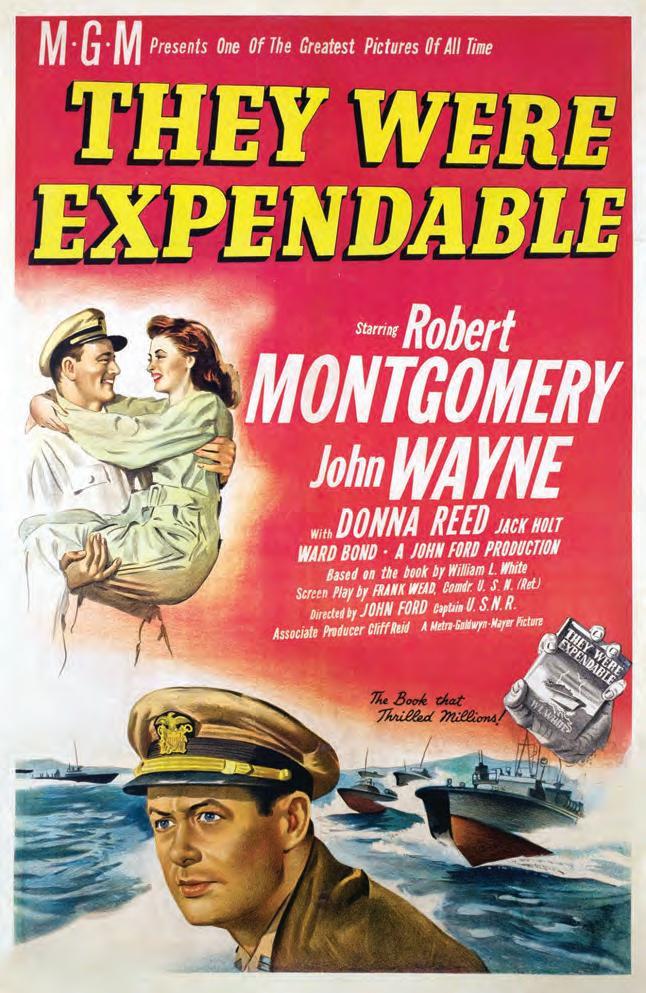
Then the war comes.
DIRECTOR JOHN FORD went on inactive status from the navy in 1944 to film an adaptation of They Were Expendable, William Lindsay White’s book about PT boats during the opening months of the war in the Philippines. The movie starred Robert Montgomery, who had joined the navy after Pearl Harbor and, like the character he plays, commanded a PT boat. John Wayne, who had not served in the war, was billed second. Back on a film set, Ford remained the same cantankerous needler he had been before the war and he zeroed in on “Duke” Wayne, one of his favorite targets. In Print the Legend, his Ford biography, author Scott Eyman relates how Montgomery
In one early scene, Rusty receives a finger wound that becomes infected and Brick orders him to the hospital on Corregidor. There he strikes up a brief romance with nurse Sandy Davyss (Donna Reed). Like everything else in the movie, the romance is realistic and understated. Rusty invites Sandy for dinner at the hut serving as the officers’ club, where sailors hidden in the crawl space beneath the building serenade them. It’s a touching scene, but Ford understands that romance is impossible under these conditions. The last time the two speak is over a field telephone as Rusty prepares to depart on a mission and Sandy remains on Corregidor as the Japanese move closer. The conversation gets cut off abruptly when higher-ups commandeer the line. Rusty—and the audience—never learn Sandy’s fate.
Ford uses his own naval experience to create a sense of authenticity. There’s no place for cinematic heroics. Earlier in the film, as Brick chafes at the limited role his boats have been given, the admiral compares the situation to a baseball game. If the manager tells you to hit a sacrifice bunt, that’s what you do. “You and I are professionals,” he says. At the end, when Rusty decides to give up his seat on the last plane out to Australia so he can join the guerrilla fight against the Japanese, Brick calmly reminds him that they have their orders. Rusty sits back down.
Brick’s PT boats do see combat and those
who like watching these speedy plywood craft in action will enjoy those sequences. They also get one vital mission when they spirit “the General” out of the war zone so he can continue the fight from Australia. Although the General remains nameless, audiences certainly recognized him as Douglas MacArthur. In real life, John D. Bulkeley, the Medal of Honor recipient on whom Montgomery’s character is based, did transport MacArthur and his family south to safety on Mindanao, where B-17s then flew them to Australia.
One of the movie’s greatest strengths is its eye for detail—when Brickley grabs a pair of scissors to estimate the distance on map; the terrified faces of wounded soldiers on Corregidor as Japanese bombs fall; the cook’s instructions to use a pinch of salt in the pancake batter; the way Sandy brushes her hair and puts on a string of pearls before sitting down to dinner with the officers; the fact that Rusty demands aviation fuel (PT boats used Packard engines adapted from airplanes). It is also beautifully filmed, with haunting shots of the shadowy and wet tunnels of Corregidor







and some pulse-pounding sequences of PT boats dodging shell bursts. They Were Expendable turned out to be one of John Ford’s best films, but it was not a huge box office success when it was released at the end of 1945. It is a war movie in a minor key—subdued and somewhat melancholy. It matches the film’s subject matter: the American experience in the Philippines at the start of the war did not go well, either. No doubt, audiences who had just seen the terrible war come to an end were not eager to relive its grim early days, no matter how beautifully photographed. H
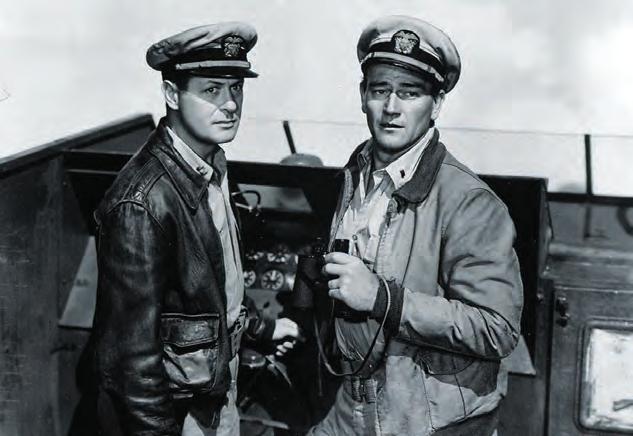

We altered this photo from the Japanese surrender aboard the battleship Missouri to create one inaccuracy. What is it?

ANSWER TO THE SPRING CHALLENGE: As 40 of you correctly guessed, we removed the gunports from the Hurricane. Many readers were fooled by the airplane’s two-bladed propeller.


Please email your answers to this issue’s challenge to challenge@historynet.com
SEE OUR AUTUMN ISSUE FOR THE ANSWER TO THIS ISSUE’S CHALLENGE!

Actor Henry Fonda was under contract to Darryl F. Zanuck at Twentieth CenturyFox when he enlisted in the U.S. Navy on August 24, 1942, as an ordinary seaman. “I’d like to be with the fellows who handle the guns,” he said. When Zanuck found out, he got the military to delay things so Fonda could shoot a movie called Immortal Sergeant. Fonda reached boot camp in November. Assigned to the destroyer USS Satterlee as a quartermaster, in October 1943 Fonda went to officer training school, followed by a stint of anti-submarine training before reporting to the seaplane tender USS Curtiss. On June 21, 1945, a kamikaze hit the Curtiss, destroying Fonda’s quarters—but Fonda was on shore leave. Lieutenant Fonda returned to the states that August to resume his film career. He left any army-navy rivalry behind when he played Brig. Gen. Theodore Roosevelt Jr. in 1962’s The Longest Day (below).
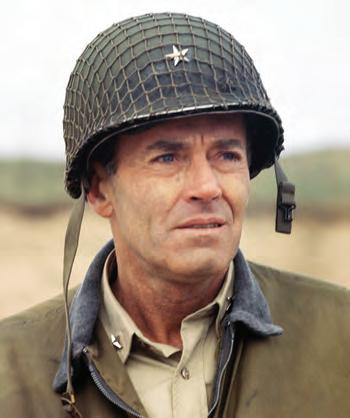


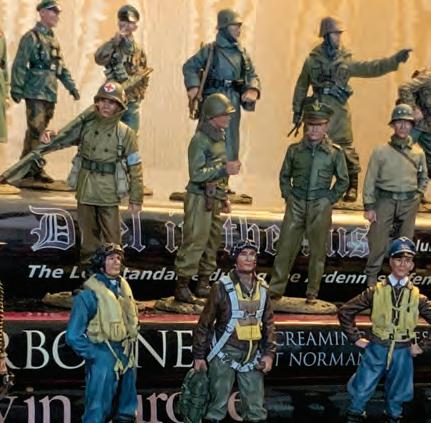
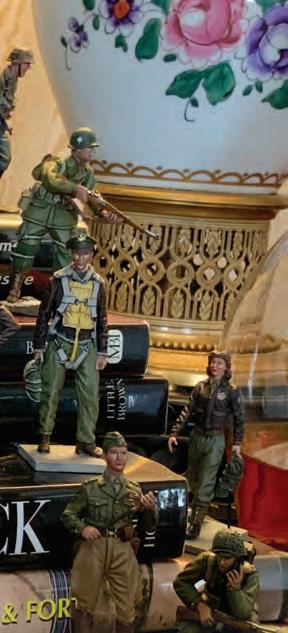

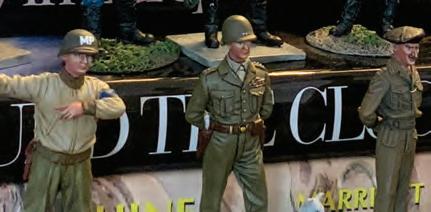





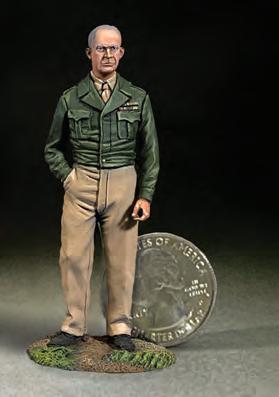
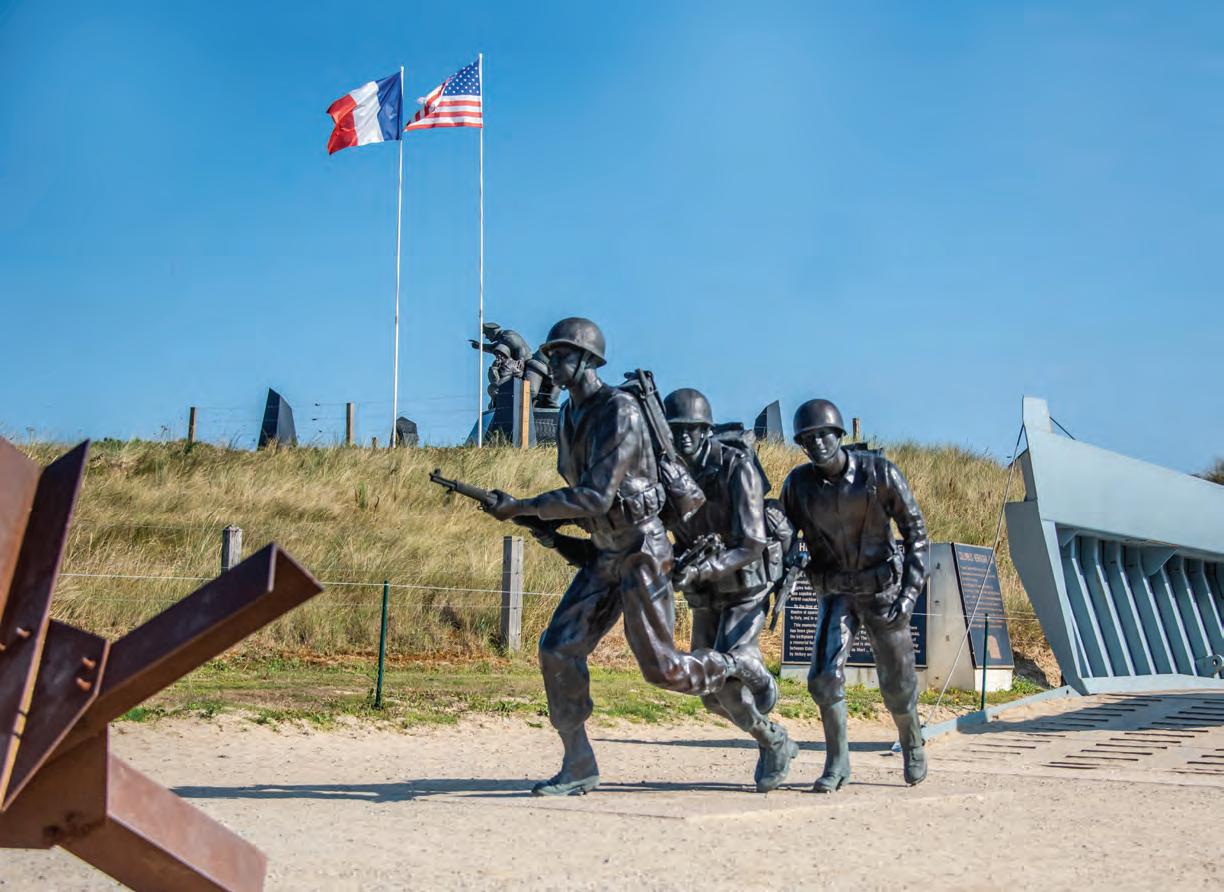
Travel with us June 1-13, July 21-August 2, or September 1-13, 2023
Follow along the path where America’s best and brightest fought in WWII as you travel from England to Normandy to the Ardennes on our D-Day to the Rhine Tour. Pay homage to the fallen in Europe and the Pacific on our Operation Overlord, Original Band of Brothers, Iwo Jima, Battle of Britain, Battle of the Bulge, Ghost Army, In Patton’s Footsteps, Italian Campaign, Manhattan Project, Normandy Campaign and Poland and Germany tours. Our WWII, Civil War and American History tours are unrivaled in their historical accuracy!
The best way to understand history is to study the places it was made.
DR. STEPHEN AMBROSE